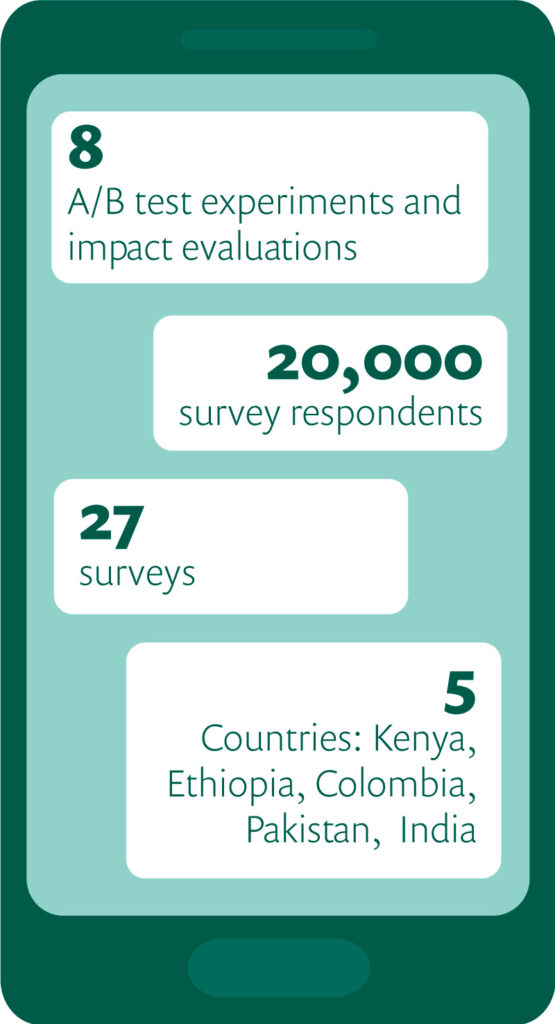
2022 was a tremendous leap forward for research at PxD. Our research and operations teams completed a total of eight A/B test experiments and impact evaluations. We collected data in person and over the phone from approximately 20,000 survey respondents in 27 distinct surveys that took place in Kenya, Ethiopia, Colombia, Pakistan, and three states in India.
We generated new insights to build future programming such as an SMS agro-dealer directory to reduce input market information frictions, built evidence-based proofs of concepts for innovative service design such as WhatsApp-based crowdsourcing chatbot and learned to leverage research partnerships for scalability with dairy cooperatives. We used research insights to shift and refine our approach and we are excited about further impact evidence from forthcoming analysis in 2023.
Devastating events in 2022 from drought in the Horn of Africa to the 100-year flood in Pakistan emphasize that climate change is one of the most urgent challenges facing our users. As such, we have intensified our research efforts to identify interventions that can improve smallholder livelihoods whilst incorporating climate adaptation and mitigation efforts into our existing services. We’ll continue this innovation research agenda in the coming year to explore high-value innovations to supplement our core digital agricultural advisory.
New insights to build future programming
Across a diverse portfolio of research projects, we have demonstrated the value of PxD’s services and contributed to an expanded knowledge base on digital agricultural extension. A particularly promising finding is establishing that digital tools can be effective in improving in-person extension services.
Performance goal reminders sent via SMS messages could increase extension volunteers’ performance: Through a large-scale randomized evaluation in Rwanda, we demonstrated that performance goal reminders sent via SMS messages – particularly goals that were ambitious but attainable – could improve community extension volunteers’ (known as Farmer Promoters – FPs) performance and therefore generate positive impacts on farmers’ outcomes. Sending goal reminders to FPs significantly increased the number of farmers trained by 3.1 percent, led to a significant 4.3 percent more training sessions being delivered, and increased farmers’ registration for subsidized inputs by 1.9 percent (statistically insignificant) over FPs who did not receive goal reminders. Given that the unit cost for each SMS is $0.006 and the average number of farmers assigned to each of the ~14,000 FPs across Rwanda is 190, the effect sizes of these messages are likely to be highly cost-effective.
The results of the Rwanda project support the expansion and replication of extension agent interventions in other settings targeting different populations in the future. In addition, these results point to areas for future research and development that could enhance the effectiveness of extension agent services. For example, we are interested in exploring how digital tools can be used to help extension agents set performance-increasing goals, direct them to farmers most in need, and extend information access to farmer populations that may not benefit from direct digital advisory services.
A digital directory of agro-dealers has the potential to increase the adoption of recommended inputs: In Kenya, we found evidence that farmers can benefit from the provision of an SMS agro-dealer directory by reducing input market information frictions. Our preliminary empirical findings suggest that – particularly for a directory that includes stock and price information about agro-dealers – access to this tool prompts farmers to refine their choice of agro-dealers before an in-person visit. Farmers in the treatment arm who had access to the agro-dealer directory and stock information contacted 21 percent more agro-dealers, but visited 4 percent fewer agro-dealers relative to the control group which did not have access to the tool. This suggests that farmers in this treatment arm used the contact information to call more agro-dealers before spending time and money to travel to the shops themselves.
Farmers given access to the agro-dealer directory were more likely to purchase PxD-recommended inputs and experienced fewer stockouts than those who didn’t have access to the directory. When pooling the two treatment arms, we observe that consistent with PxD’s advisory recommendations, treated farmers were 6 percent more likely than control farmers to use hermetic bags to store maize – a practice shown in rigorous studies like Ndegwa et al. (2016) to prevent post-harvest losses from pests. Farmers in the treatment arm with access to the directory but not stock info appeared to contact and visit agro-dealers at the same rate as the control group but then were 22 percent less likely than the control group to report facing an input shortage when they shopped (meaning they were more likely to find and purchase the product they were looking for).
Building on these promising findings, we hope to identify opportunities to further develop a scalable digital agro-dealer directory tool. Specifically, we are interested in exploring ways to onboard a large number of agro-dealers and update the stock information at a low cost.
Building proofs of concepts
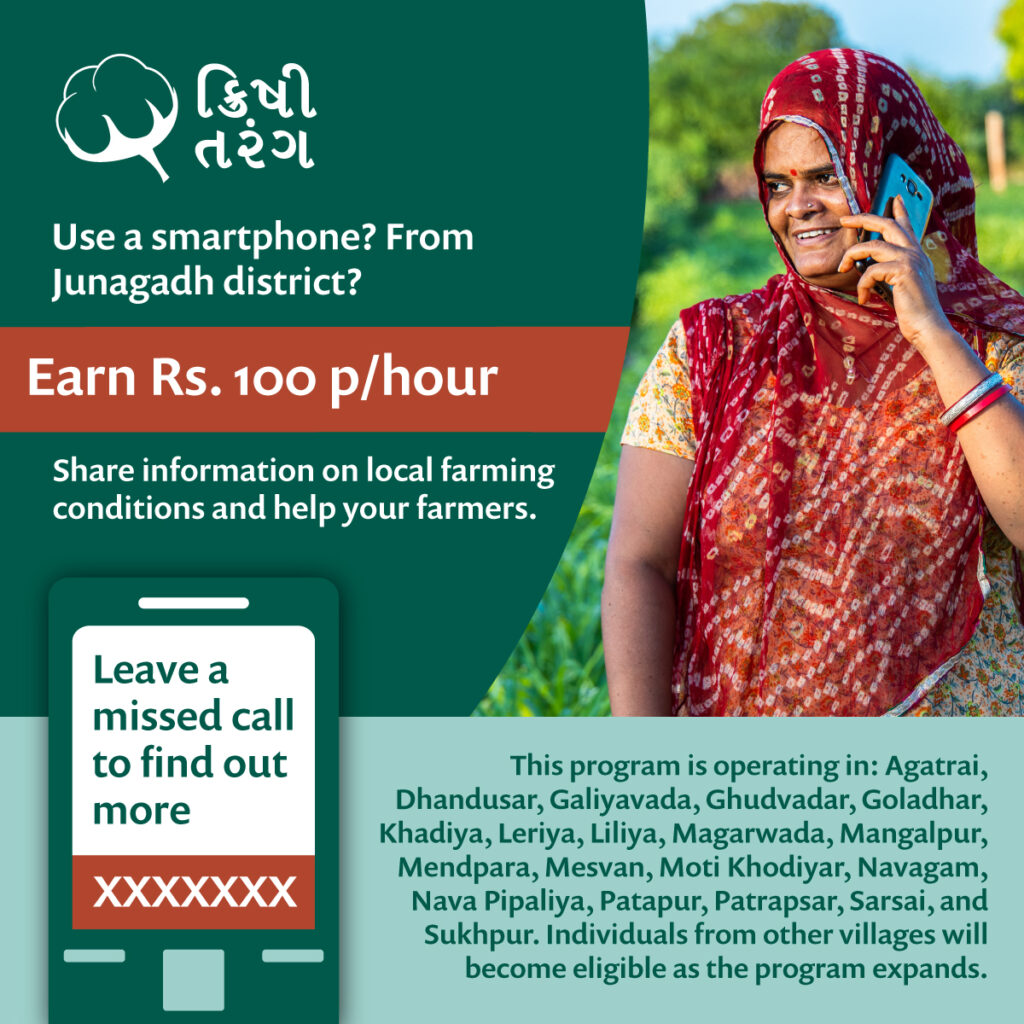
Digital peer groups increase farmer interactions and potentially increase the adoption of recommended practices, but we need creative ways to form groups at a low cost: Various research projects aimed to demonstrate proof of concept for novel interventions that PxD was exploring for the first time. For example, we now have empirical evidence that an intervention in Kenya to organize farmers into groups and send them SMS nudges to communicate with each other was effective at increasing both engagement with PxD’s service and communication between group members. Treatment farmers who were organized into digital peer groups had higher interaction levels than their control group counterparts and were 43 percent more likely to meet with their group members on a farm than control farmers. Interacting with one’s group members on a farm was also associated with increased adoption and knowledge of recommended practices.
A gig-worker model for crowdsourcing agricultural field photos has the potential to generate real-time data on field conditions: We acquired institutional knowledge, both technical and regulatory, to build and operationalize crowdsourcing platforms to demonstrate the feasibility of crowdsourcing information from agro-dealers and farmers in Gujarat. In a pilot, we set up a WhatsApp chatbot, integrating a WhatsApp Business Account with our in-house user communications platform, Paddy, to guide users through a systematic inspection of a field for crop health issues and send reports back to PxD with their findings.
Eighteen of our recruited farmer agents consistently engaged with the program over 10 weeks, with a median of nine crop health reports per agent. The quality of field reports was high – approximately 94 percent of reports are usable. In total, we received 220 field reports with accurate GPS locations and usable photographs. Each of these reports costs INR 125 (USD 1.67), which is substantially below the cost of a 15-minute phone survey. This suggests that crowdsourced data could be a cost-effective method of collecting local data.
PxD aims to further build this knowledge to crowdsource various types of information and use it to improve future service offerings by customizing advisory to be more locally relevant and actionable.
Working with smallholder farmers in the fight against climate change
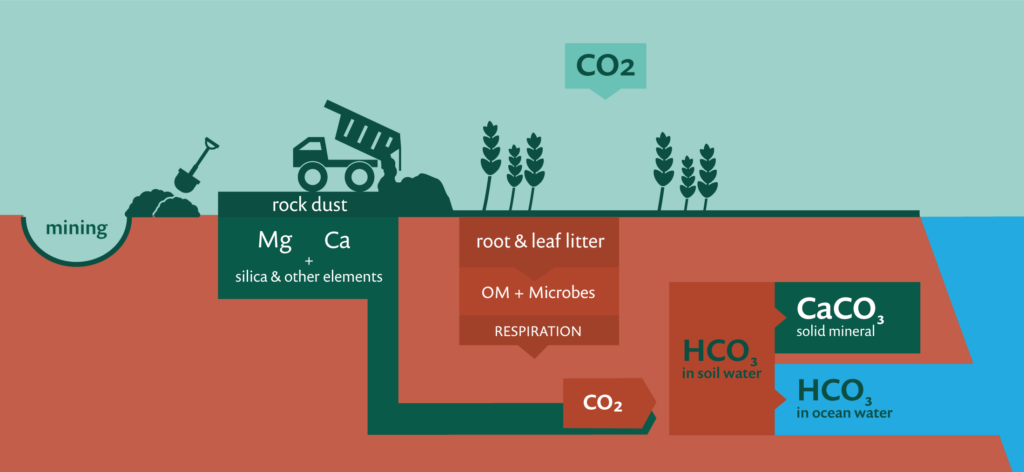
We are intensifying our efforts to provide information to smallholder farmers that will allow them to make informed decisions to reduce the risks that climate change presents to their livelihoods and to consider adopting practices that can actively reduce greenhouse gas emissions. We approach this work with the guiding principle of farmer welfare first: smallholder farmers cannot be expected to pay the price for climate change mitigation. Climate change-related advisory should directly support livelihood gains via improved agricultural output or renumeration .
PxD, in collaboration with the Institute for Governance and Sustainable Development (IGSD), worked to assess opportunities to benefit poor farming communities through their participation in climate mitigation activities and to direct tangible returns to participating smallholder communities.
The PxD-IGSD collaboration has focused on exploring four mitigation areas with most promise in agriculture: Carbon dioxide sequestration through enhanced rock weathering; Carbon dioxide sequestration with organic carbon storage in soils and plant biomass; Nitrous oxide mitigation through precision nutrient management; and Methane mitigation in dairy through improved livestock feeding practices.
- Enhanced rock weathering (ERW), an emerging technology that permanently draws down carbon from the atmosphere and has the potential for agricultural co-benefits makes it an attractive mitigation strategy in the smallholder farmer context.
- There is evidence that conservation agriculture practices that many farmers are already familiar with – such as reduced tillage, the use of cover crops, and intercropping – promote the sequestration of organic carbon in soils.
- In terms of nitrous oxide emissions, simple decision support tools following the Site Specific Nutrient Management approach, i.e. Leaf Color Charts (LCC), have been shown to reduce nitrous oxide emissions from nitrogen fertilizer use as well as improve farmer outcomes.
- For methane, improving feeding practices that increase milk production and closing the dairy yield gap in the Global South per cow can lower the methane intensity of production and contribute to methane mitigation, as well as improving farmer livelihoods.
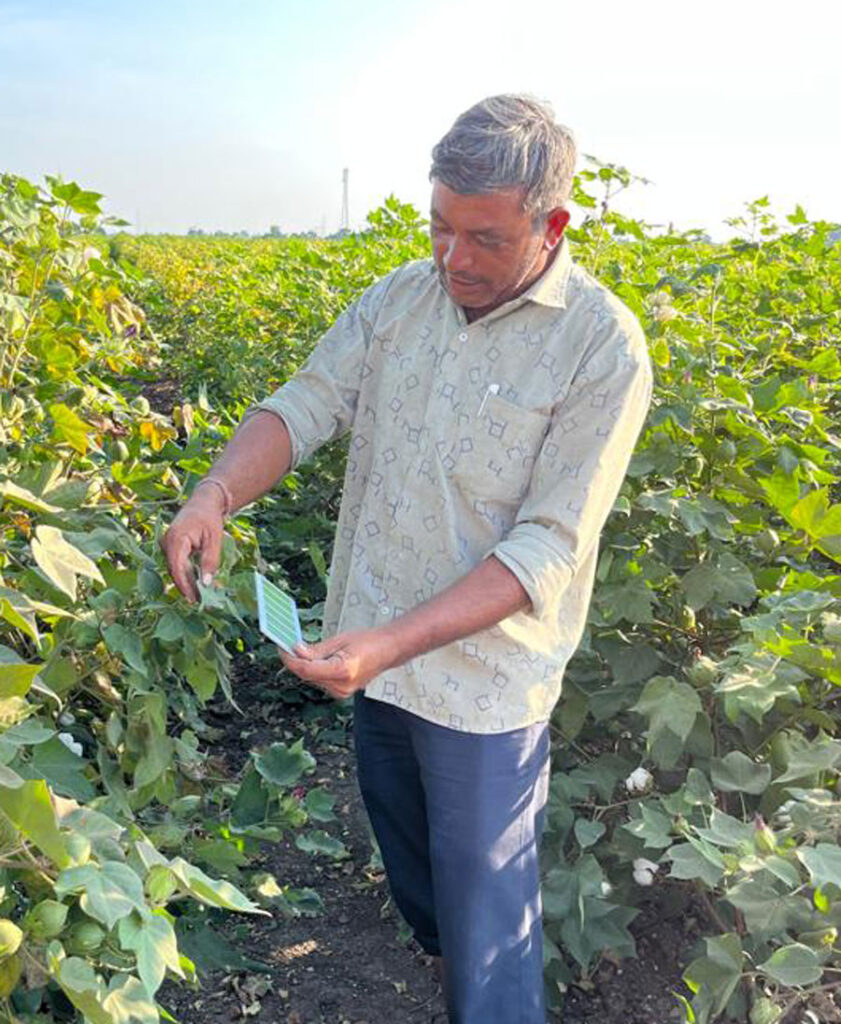
We’re excited to be on the cutting edge of exploring the potential of these climate change mitigation opportunities- like scoping a digital version of Leaf Color Charts to enable the tool to reach a wider scale and Advanced Market Commitments to incentivize R&D for enhanced rock weathering. Our research initiative with IGSD has enabled PxD to identify future activities within each opportunity area to advance climate change mitigation in the smallholder farmer context and we are actively pursuing partnership and funding opportunities to advance these activities.
Learning to leverage research partnerships for scalability
Partnerships have proven to be a critical pathway to increasing impact and scaling evidence-based programs across our project portfolio.
By collaboratively identifying and developing high-impact opportunities with dairy cooperatives in Kenya, PxD has identified a new partnership model in which PxD serves as a technical and analytical partner for innovating and testing service offerings for cooperatives, and builds cooperatives’ capabilities for generating greater impact at scale. We kicked off the partnerships with Lessos Dairy and Sirikwa Dairy by adapting an asset-collateralized loan product for water tanks which has been shown to dramatically increase access to water tanks among dairy farmers in a research study (Jack et al, 2022) and setting up an evaluation to measure its impact on economic and household outcomes.
In Gujarat, India we surmise that identifying low-cost and scalable approaches to crowdsource pest information will require leveraging local organizations and existing social networks for cost-efficient recruitment and training of agents.
To further explore opportunities to support women farmers in Gujarat, we successfully established partnerships that allow us to better understand the constraints women farmers face in engaging in economic activities and their access to information and other services. These partnerships allow us to design and implement group-based digital services to address those specific constraints.
Insights to shift and refine our approach
Our scoping activities allowed us to identify when a change in approach was needed or when interventions did not turn out to be as promising as we had hoped.
In the dairy sector in Kenya, we learned that existing market and coordination failures, such as credit constraints, need to be addressed to create an environment in which digital advisory can effectively improve smallholder dairy productivity.
In testing social learning mechanisms in Kenya, we did not find evidence that the designed intervention increased farmers’ knowledge or the likelihood of adopting recommended practices, despite finding that peer learning was effective at increasing both engagement with PxD’s service and communication between group members.
While subsequent qualitative interviews suggest that some farmers visited the farm fields of their peers and experimented with the recommended practices in a small portion of their plot, developing the digital peer group advisory further is likely to require a substantial investment in basic research to understand farmers’ social learning process and identify creative ways to reduce the relatively high costs associated with forming peer groups.
Finally, we learned to exercise caution in working with established women’s groups in Gujarat in a way that does not exacerbate local power dynamics within communities to ensure PxD’s services are designed in a sensitive way to promote the inclusion of marginalized groups that may face particularly challenging digital access gaps.
Looking forward to continue building our evidence base
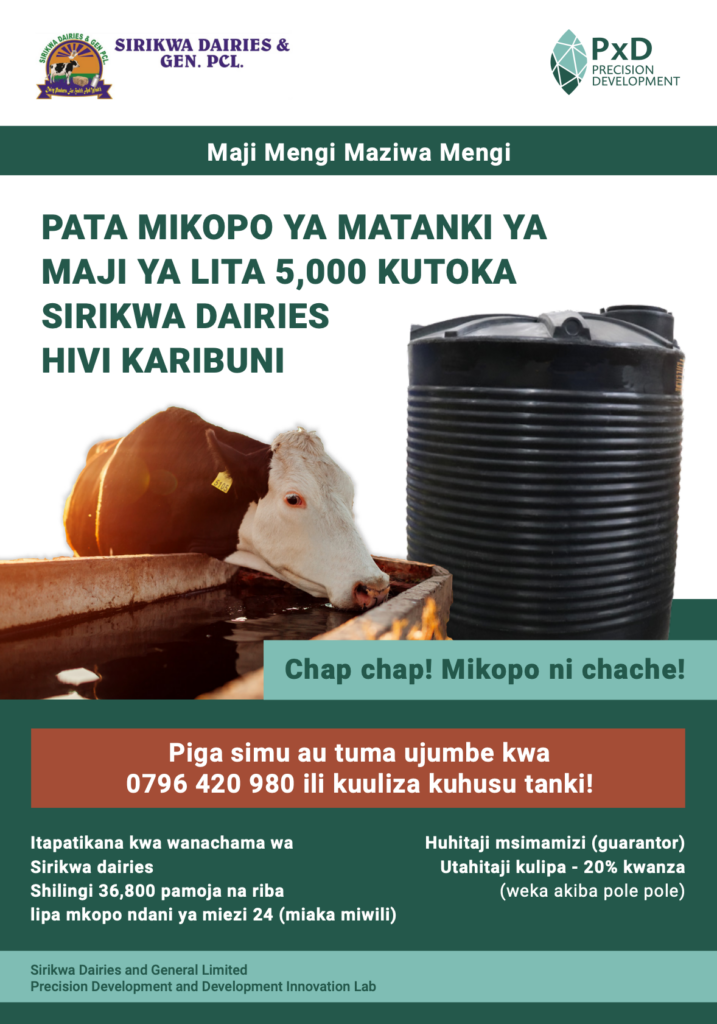
In the coming year we are looking forward to continuing to build our evidence base with forthcoming insights on PxD’s impact on farmer welfare from several large-scale RCTs in India, Uganda, and Kenya.
For the impact evaluation of our largest service offered to date for rice farmers in India, endline data collection and analysis are expected following the second season of implementation in 2023. In addition to outcome data on farmers yields and profits, we’re excited to generate additional insights on scalable measurement options for detecting yield changes among rice farmers using remote sensing data.
In Uganda, our work with coffee farmers enabled PxD to explore several dimensions of digital advisory, including comparing a stand-alone digital advisory service to the provision of digital advisory as a complement to in-person training and studying social spillovers from our advisory services. An endline analysis of the effects of this program will be forthcoming in 2023.
We are also excited to generate initial insights on the impact of asset-collateralized loans for water tanks on economic and household outcomes among dairy farmers in Kenya. Using frequent administrative data from dairy cooperatives on milk production, we’ll be able to understand how improved access to water tanks helps farmers mitigate productivity shocks and domestic water shortages as farmers adapt to more dry spells from a changing climate.
In addition to evaluation research with rigorous RCTs, we look forward to building out our research innovation agenda in the coming year. We are exploring a variety of new, evidence-based high-value product innovations that can build on our agricultural impact for smallholder farmers, such as interventions to facilitate market linkages and access complementary financial services. We are committed to using rigorous evidence and deep user research to identify and prioritize which ideas to pursue.
We look forward to sharing new insights with you throughout 2023! If you’d like to learn more or partner with PxD on specific areas highlighted please get in touch!
A new PxD report details fee-for-service private sector collaboration to support free digital extension service delivery to farmers in poverty
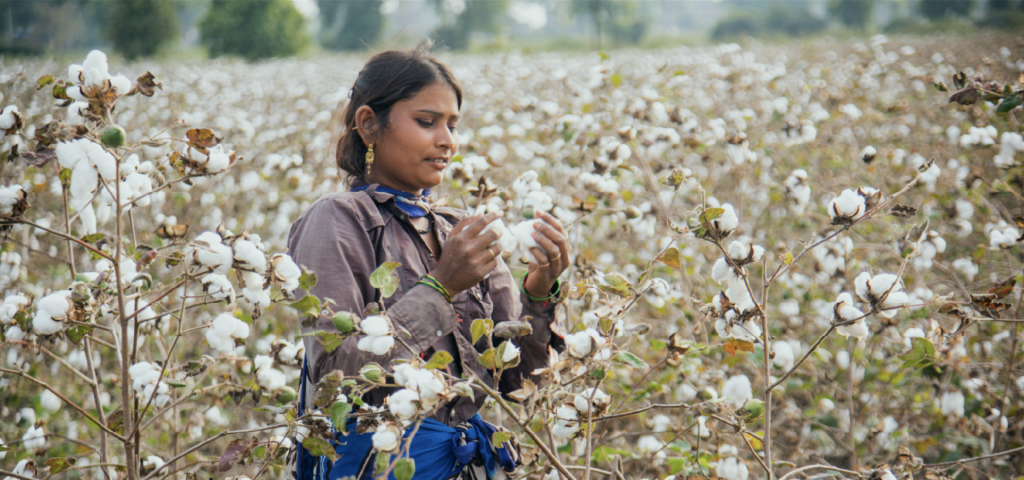
With support from the Swiss Re Foundation, PxD investigated the viability of new forms of partnership with private sector firms to offset the costs of delivering digital advisory information to poor smallholder farmers at no cost to the end-user. PxD initiated a series of pilots that, for a fee paid by private sector partners, connected farmers to agricultural services offered by the same private firms. The pilots investigated the potential for fees derived from partnerships to offset the cost of delivering free information to farmers.
Platforms built and supported by PxD provide scientifically validated and customized digital advice to poor smallholder farmers. This information helps our users make more informed decisions to improve productivity, yields, and incomes, and advance more resilient livelihoods. A majority of our users receive information via platforms we have built in partnership with governments and non-governmental organizations. The overwhelming majority of our users pay nothing to receive information from these platforms. But that does not mean that the information is free of costs. We rely on funding from donors and governments to cover the costs of the service, and sustainable service delivery.
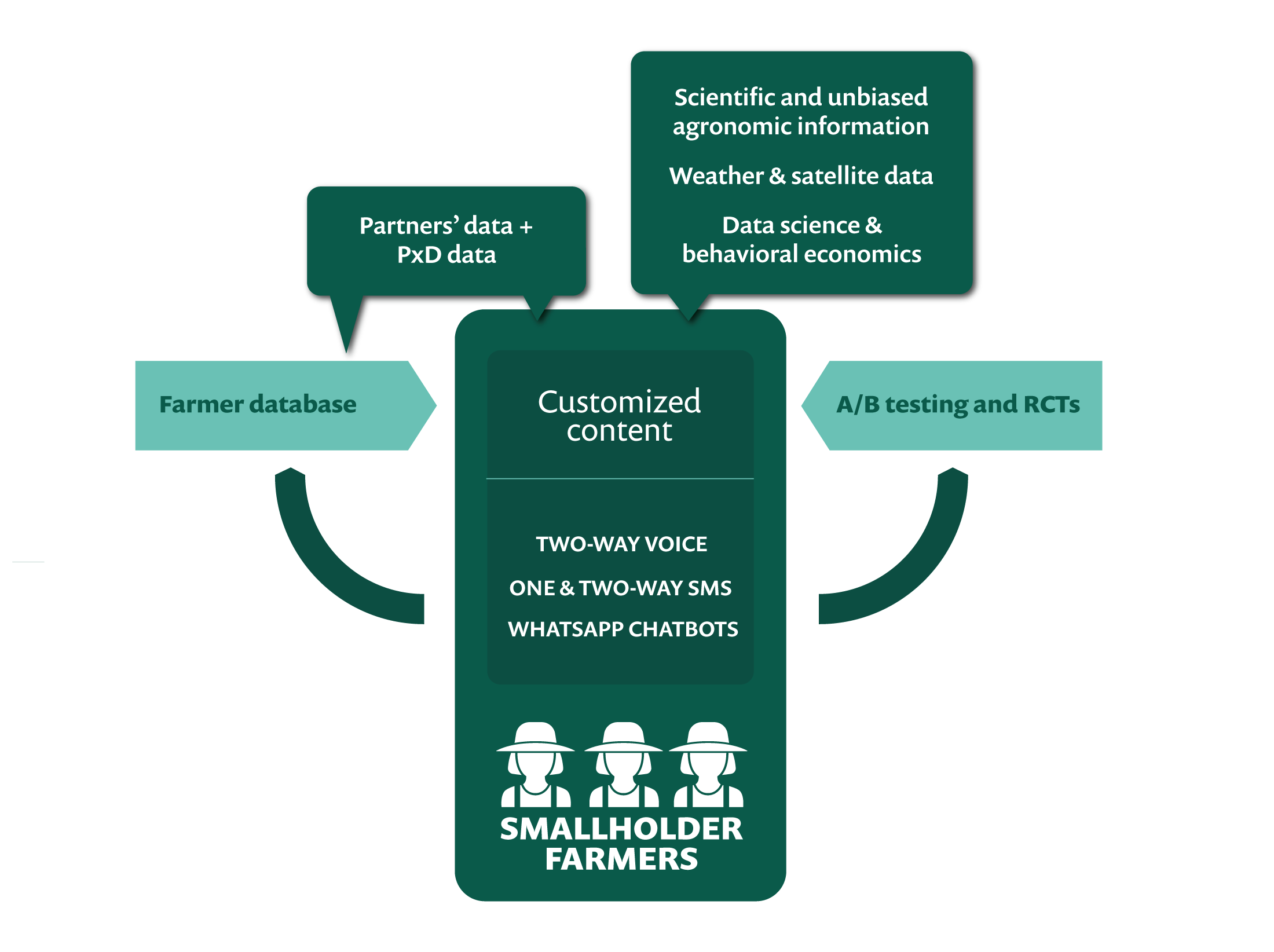
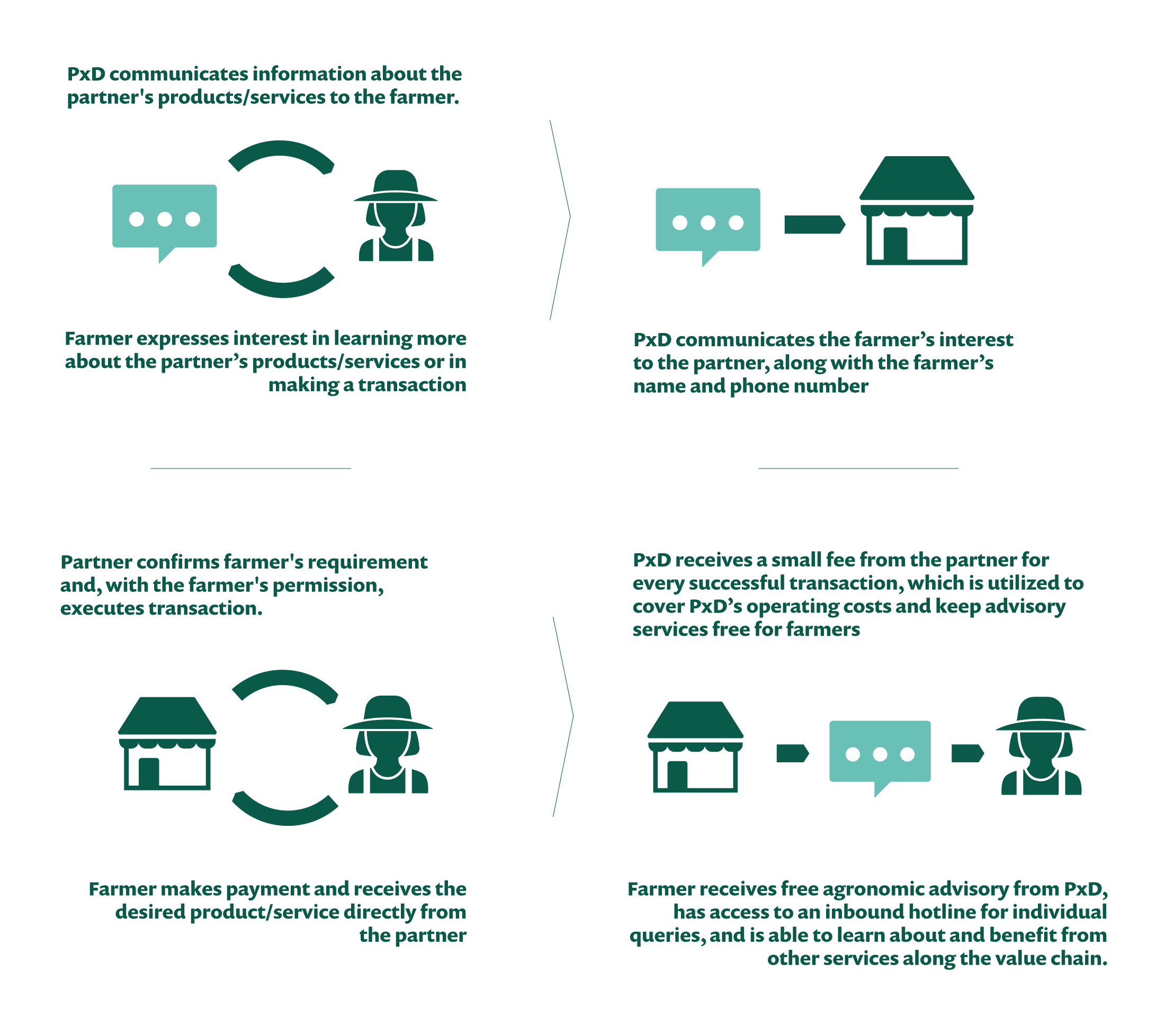
A new report by PxD presents the findings of these investigations. Support from the Swiss Re Foundation enabled PxD to uncover new insights about models of private sector collaboration with the potential for revenue generation at scale and a range of insights about the effectiveness of these services and the viability of new models for partnership. The project also enabled PxD to grow Krishi Tarang, our existing wholly-owned digital advisory service in Gujarat, India, to over 100,000 farmers.
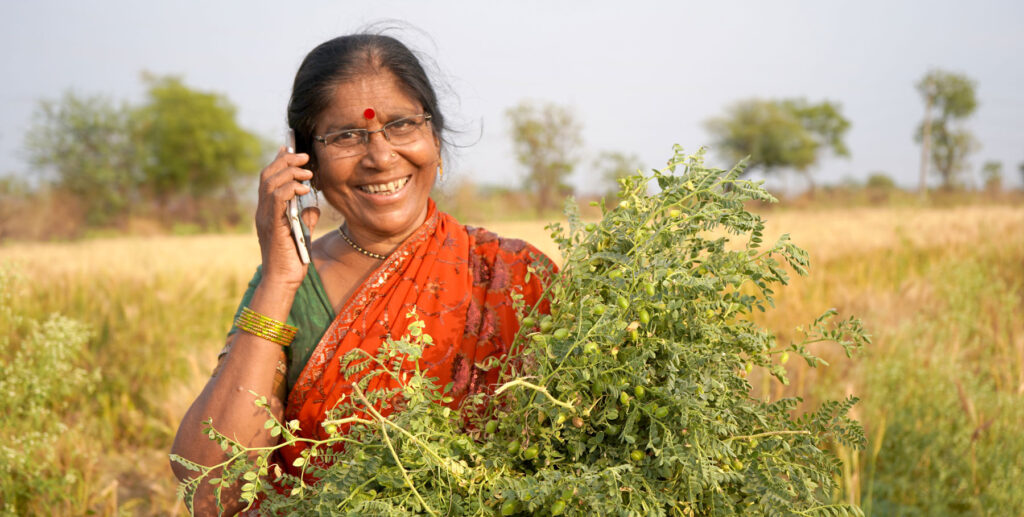
On 1 August 2022, PxD completed the transition of the management and operations of Ama Krushi – our largest digital service – to Tatwa Technologies Limited, a third-party firm that won a competitive government tender. This post reflects on Ama Krushi’s journey from concept to a fully-fledged digital advisory service providing customized agronomic advice to over three million farmers, and recounts some of the hard truths, lessons learned, and innovations uncovered.
The successful handover of Ama Krushi to Tatwa is bittersweet, marking the culmination of years of work to build a sophisticated digital extension service from scratch. But the transition also means the end of a remarkable journey and a farewell not only to a service we are justly proud of, but also to longstanding colleagues who have transitioned with the service to new management.
In 2018, PxD (then Precision Agriculture for Development) – in partnership with the Department of Agriculture and Farmer Empowerment (DAFE), the Bill and Melinda Gates Foundation (BMGF), and the Abdul Latif Jameel Poverty Action Lab (J-PAL) – launched “Ama Krushi” (“farmers’ friend” in Odia, the most commonly spoken language in Odisha State). Ama Krushi was envisioned as a digital farmer-advisory platform to deliver timely, customized digital advice free of charge to smallholder farmers in the state of Odisha via their mobile phones. Conceived as a build, operate, and transfer (BOT) project, its design envisaged the transition of the management of Ama Krushi to the government of Odisha at the conclusion of the implementation and scaling period. The partners imposed an ambitious target for Ama Krushi: by March 2021, the service would have leveraged research and evidence to build and scale a cost-efficient, statewide digital extension service to serve one million farmers.
As is often the case with well-laid plans, PxD’s journey was very different from what was envisioned in 2018. The initial transition timeline to transfer day-to-day management of the service in 2021 was revised as the impacts of the COVID-19 pandemic were felt.
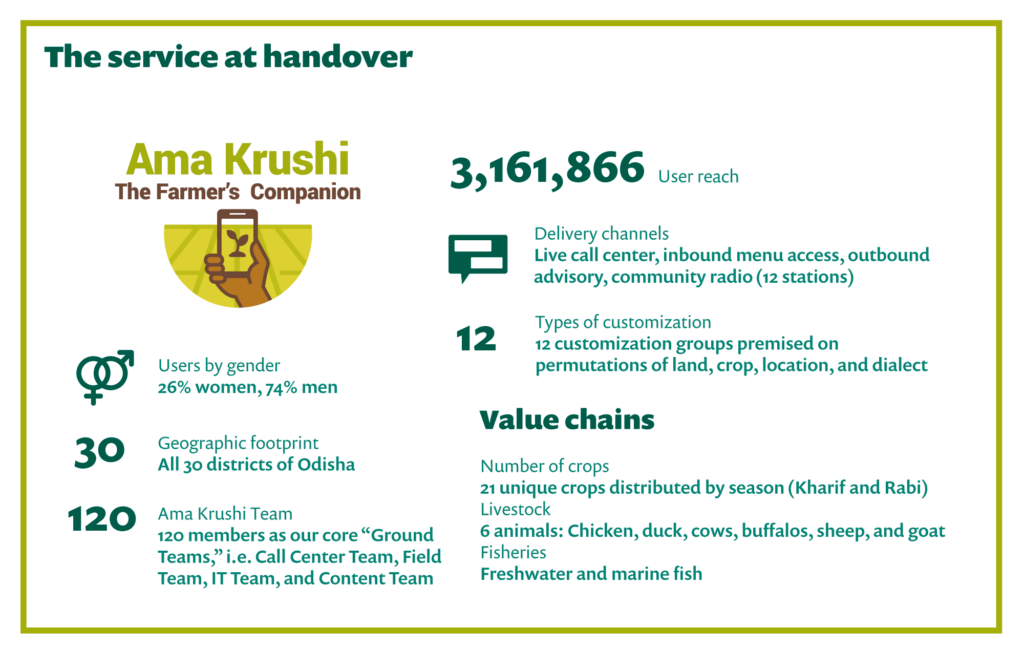
The formal transition ultimately commenced on 1 April 2022 with the initiation of an intensive capacity-building and transfer plan. Tatwa began operating Ama Krushi independent of PxD on 1 June, with continued technical support from PxD staff. Tatwa assumed full responsibility – with PxD becoming entirely hands off – on 1 August. At transfer, Ama Krushi was actively servicing over 3.1 million farmers.
The early days
During the first two years of project implementation, Ama Krushi grew to provide advisory and information for 16 crops across all 30 districts of the state of Odisha. After consenting to be registered, each farmer added to the service was profiled by enumerators. In profiling, a cropping profile for each farmer was created and was populated by our call center team or by our field team on the ground. An accurate profile enabled the service to direct customized content to each farmer, timed to align with critical decision points on the agricultural calendar.
In the early years, the team focused on building out Ama Krishi’s core service: an interactive voice response (IVR) push call service that delivered weekly advisory information tailored to each farmer’s profile information, and a complementary farmer hotline. By placing a missed call to the hotline, farmers received a free return call, enabling them to access a library of advisory information and frequently asked questions, and the option to leave messages to be serviced by agronomists via a recorded push call within 48 hours (typically fulfilled within 24). While any farmer could ask a question, only profiled farmers received weekly advisory.
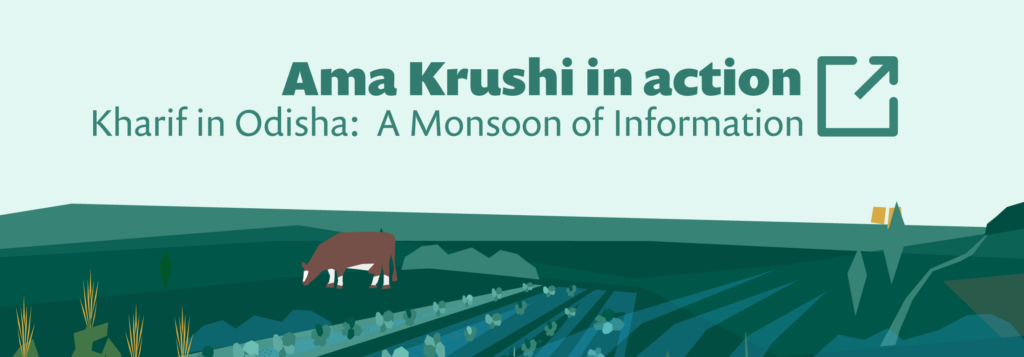
By analyzing trends in engagement and directly interacting with users during field visits and focus groups, we gather information to inform new products and service innovations that are relevant to the needs of users. Two prominent examples include the integration of Kitchen Garden Advisory, aimed at women who engage in subsistence farming, with our regular programming, and the expansion of our advisory to include non-crop-related value chains, specifically livestock and fisheries. During the first two years of operation, the Ama Krushi team explored different avenues for expansion while deploying A/B tests to iteratively improve modes of information delivery. At the end of 2019, Ama Krushi was serving over 620,000 farmers.
Similarly, in response to demand from farmers and our partners at DAFE, PxD added new digital channels to expand our reach to smallholder farmers. Radio remains an important medium for information dissemination in rural India. Accordingly, PxD piloted advisory dissemination via a local community radio station in early 2019. By September 2020, the pilot had evolved into a formal collaboration with the Community Radio Association of Odisha, with Ama Krushi broadcasting weekly advisory across 12 community radio stations. Community radio enabled us to reach many more farmers who were not registered on the service and advise them on how to register to receive the full suite of AK digital services.
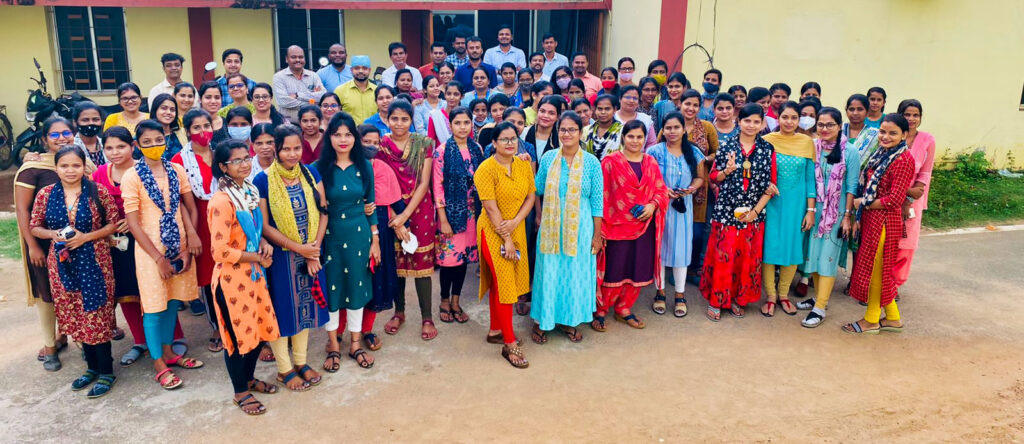
We also added a live call center (LCC) in December 2019 so that farmers could call in to be connected to a live agent. Given farmers’ limited digital literacy, we observed that many farmers had trouble navigating the inbound hotline. To make the service more accessible, DAFE requested that we build out an LCC to help reduce the technological burden on farmers. Propelled by the government of Odisha’s request to have all services offered by Ama Krushi available under one short code, the LCC was added to the main menu in February 2021 – now, should the farmer wish to, they can call 155 333 and choose whether or not to engage with a live agent to have their concerns addressed. This is supplemented by an escalation system that ensures that the farmer receives the answer on the spot or through a push call within 48 hours.
In early 2019, PxD also ramped up the training and onboarding of extension workers and other village-level champions, which allowed us to grow the number of agents that could sensitize farmers on the Ama Krushi service. It also meant that content could be disseminated via a hybrid model to these groups (e.g. IVR and district-level WhatsApp groups).
Scaling through the pandemic
At the start of 2020, in consultation with our colleagues at DAFE and BMGF, we formulated a transition plan to transfer day-to-day management of the service to a third party in 2021, as per the initial BOT agreement.
No sooner had the execution of the transition begun, however, than our plans were upended by the COVID-19 pandemic, which presented challenges that we (and most organizations across the world) did not have the experience or knowledge to contend with. We reconfigured our operations to continue offering the service while adapting our operations to work-from-home.
The move to a fully remote, work-from-home operation underscored a cornerstone advantage of digital extension services: the ability to operate at times and places that traditional extension services cannot reach. In the first month after the pandemic, we transitioned our hundred-strong call center team to work-from-home arrangements, established a system to service agriculture-related distress calls (for example, being stopped by police when taking perishable crops to market after the issuance of a statewide authorization communique) and questions from farmers during the nationwide lockdown, and assisted the government of Odisha to deliver key agriculture-related updates to remote areas. The Ama Krushi team demonstrated remarkable resilience, maintaining and then building their capacity to serve farmers. The Ama Krushi service was available every day of the nationwide lockdown and subsequent phases of physical-distancing protocols, .
Despite significant operational adjustments imposed by the pandemic, Ama Krushi surpassed its target of servicing one million farmers in November 2020, five months ahead of DAFE’s initial target. Bolstered by Ama Krushi’s success, the government of Odisha issued a directive defining new targets and goals in March 2021. With additional support from BMGF, we received approval to launch advisory channels to support livestock and fisheries on the Ama Krushi platform. The government of Odisha also revised the end goal of onboarding 1 million farmers by March 2021 to 2.5 million farmers by June 2021.
While these requests reflected the Odisha government’s faith in Ama Krushi and our team, the revised targets and deadlines presented challenges for the handover of the service. COVID-19-related concessions had allowed for the extension of the original transition timeline from March 2021 to September 2021, but the addition of livestock and fisheries went beyond the scope of the original agreement and required us to test, launch, stabilize, and hand over a new version of the service within six months.
Undeterred, the Ama Krushi team quickly commenced piloting and testing to support the development of livestock and fisheries advisory, launching the two new advisory channels in January and April 2021, respectively. Concurrently, we continued to leverage research and user feedback to improve the service and began preparing operations and management materials in preparation for the handover.

Collating and organizing information about the service and the platform operations was an extensive exercise that required the creation of a large vault of documents. These documents detailed how the service worked (even as the service continued to change), outlined a framework to facilitate capacity building to support the transition of workstream ownership from PxDs’ team to government officers, and created a learning agenda to document and monitor the transition and inform future efforts.
Transition
Coordinating with the government during the pandemic was challenging – understandably, as their focus had shifted to the resolution of pressing issues. Coupled with the adjustment to work-from-home arrangements and personnel changes in critical official roles, discussions, and decisions to guide the Ama Krushi transition slowed.
At a meeting in March 2021, the government committee, chaired by the then Principal Secretary, met to decide what form the Ama Krushi transition would take. Early considerations had included embedding government staff within the Ama Krushi team, but given the complexity of operations, the government indicated a strong preference for a procurement process to contract out management of the service to a third party, while retaining government oversight and ownership. Naturally, this development led to a series of internal considerations. What form would the transition now take? How would the third party engage with the government and the program? What would happen to program staff who had been trained with a view of being transitioned to government management? How would the service remain government-owned and -funded in the long term?
After exploring the route of procurement via impaneled agencies with the Government of Odisha, PxD and DAFE came to the conclusion that, given the size and complexity of Ama Krushi and its teams, the identification of a new implementing partner would require a full public procurement process facilitated by a request for proposals (RFP). 1An RFP is essentially an open tender:an advertisement for a service that the government requires (in this case, the management of the Ama Krushi program) is put out for a minimum period of time with a set of eligibility criteria. It invites bidders to submit a tentative budget and uses a careful scoring system to identify the best-qualified party for the task. In July 2021, the government published an RFP inviting candidates to take up the tender. The plan of transitioning the service in 2021 seemed unlikely.
The PxD team running Ama Krushi was funded by both BMGF and DAFE and comprised “ground teams” running everyday operations like profiling, content delivery, fieldwork, and IT maintenance, in addition to a dynamic data and management team. The RFP proposed a different model: the entire program would now be funded by DAFE, with the management team comprised of a Program Lead – to be filled by a government official – in charge of a program management team staffed by the organization identified through the tender, who in turn would manage the work of the ground/operational teams. We had expected that the ground teams would remain in place given that they are critical for program continuity, but there was no guarantee that the new entity would absorb the existing operational team. Suddenly, the future of our 120-people strong operational team looked uncertain.
Handover to Tatwa
Given the repeated delays and shifting parameters of the transition, we agreed with DAFE and BMGF to further extend the transition timeline to 31 March 2022.
At the conclusion of the RFP process, the government appointed Tatwa Technologies Limited as the third-party firm to take over Ama Krushi’s management and operations. Following the announcement, PxD facilitated an extensive capacity-building program premised on in-person workshops and intensive shadowing. Tatwa wisely chose to retain the program’s existing ground teams, ensuring that Ama Krushi’s operations would run smoothly, with little to no inconvenience to Ama Krushi’s now 3.1 million farmers. On 31 May 2022, PxD successfully transferred the day-to-day management of the Ama Krushi program to Tatwa Technologies. After an additional two months of technical support, PxD is no longer involved in the delivery and development of Ama Krushi’s services.
Needless to say, building and then handing over the program has been an immense learning experience. Odisha farmers relied on traditional knowledge for generations to navigate challenges associated with drought, cyclones, and other input-based complexities. Ama Krushi attempted to complement this traditional knowledge with an agricultural digital extension service capable of delivering credible, scientifically validated, and evidence-based digital information to improve decision-making, agricultural productivity, and smallholder livelihoods. We scaled a program from 50,000 farmers in 2018 to over three million in 2022, from one crop to 29 value chains spanning crops, livestock, and fisheries – all with the support of a growing team of content experts, field coordinators, and surveyors. Today, we can proudly say that Ama Krushi is an entirely government-funded and government-owned service running at scale. The transition formally concluded on 31 July 2022.
A fond farewell
Building a successful digital extension service like Ama Krushi and overseeing its successful handover was the product of years of hard work and effort. The learning curve has been steep, with unexpected accelerations in the ascent, as well as detours and changed plans. No success would have been possible without the active and sustained support of the BMGF and all of the government officials from DAFE. As a team, we learned to consistently check our assumptions and biases, systematically plan for contingencies, tailor our communications, manage expectations, and make ourselves more attuned to context-specific nuances. We will catalog these learnings as part of the post-transition monitoring exercise to inform future transition efforts (both internal and external) and provide insights for different use cases. We hope to leverage active learning from this transition to identify best practices for laying a foundation for a successful transition during the build and operate phases of development, and for successfully executing transition as the fulfillment of the build, operate, and transfer design.
Accurate, medium-range weather forecasting information can help mitigate smallholder farmers’ exposure to climate-related risks. PxD is in the process of launching new products to assist smallholder farmers to make more informed and timely decisions based on weather information. In this post, we outline the contours of our exploratory research to integrate weather forecasts into Coffee Krishi Taranga (CKT), our existing digital advisory service for small coffee farmers in India.
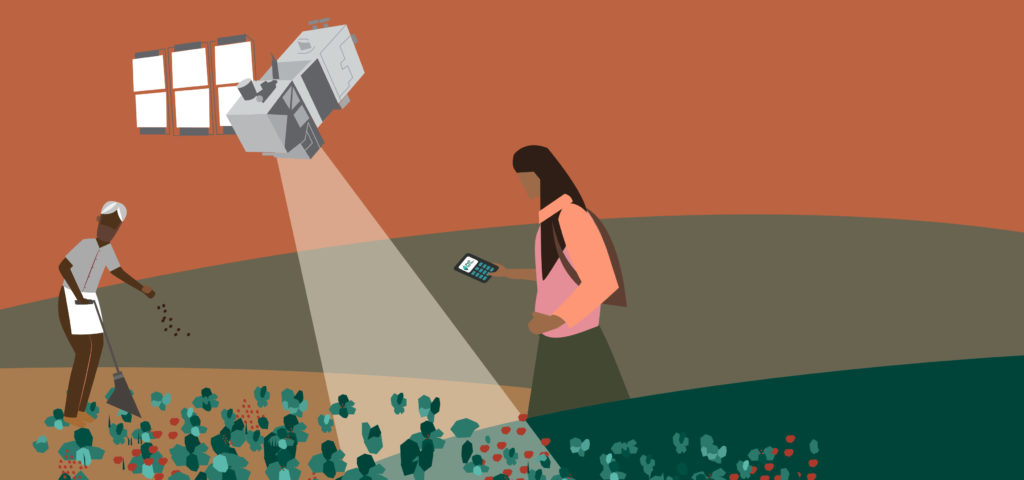
Coffee is a notoriously fickle crop. For example, heavy rainfall can damage crops, result in premature fruit-drop, increase the incidence of pests, and wash away fertilizer with negative implications for plant nutrient levels. Increasing weather variability and the incidence of extreme weather events associated with climate change will have significant negative effects on coffee producers. Given the sensitivity of the crop — and yields — to fluctuations in the weather, coffee farmers are likely to derive meaningful benefits from accurate and timely weather forecasts. Insights from our CKT learning agenda will be used to inform the design of a larger evaluation of the weather-integrated service and to scale an enhanced service to over 150,000 coffee farmers across four Indian states (Karnataka, Kerala, Tamil Nadu, and Andhra Pradesh – an expansion state).
The motivation
PxD delivers CKT in partnership with the Coffee Board of India and with support from the Walmart Foundation. Since 2018, CKT has delivered a two-way interactive voice response (IVR) service with two principal components: an outgoing push call service that provides regular advisory to coffee growers via their mobile phones, and an inbound hotline that farmers can call to access free information services. In April 2022, CKT reached just over 70,000 smallholder coffee farmers in Karnataka, Kerala, and Tamil Nadu.
More accurate information about medium-term rainfall — with a lead time of up to 15 days — will enable farmers to make informed decisions about applying nitrogen fertilizer and increase the likelihood that they apply this input during dry spells to reduce run-off and leaching. Similarly, if farmers are alerted to impending heavy rain, they can leverage this information to alter harvesting times or take other precautionary measures to protect crops and insulate yields.
Speaking to farmers to inform design and process
In interviews conducted with coffee growers in August 20211 Described further in an earlier blog post that outlined findings from the landscape analysis of coffee production in Karnataka and Andhra Pradesh relating to sustainability, market linkages, and gender., only 16% of respondents reported accessing forecasts (N=73). Integrating weather information into CKT’s existing services will broadcast weather forecasts to farmers tailored to their specific contexts and complement these forecasts with agronomist-designed advice. Exploratory and pilot research will be implemented between May and December 2022 in three important coffee-growing districts in Karnataka: Chikmagalur, Hassan, and Kodagu.
Studies conducted in other contexts find that farmers form subjective expectations about upcoming weather events based on various factors, including their past experiences, local rules of thumb, existing forecast information, the costs and benefits of acquiring such information, and perceptions about how relevant weather-related risk is to their incomes2As demonstrated in Giné, X., Townsend, R.M., & Vickery, J. (2015). “Forecasting When it Matters: Evidence from Semi-Arid India.” Working Paper.. These expectations inform behavior over the course of the coffee crop cycle as farmers make decisions relating to input and investment choices, the timing of activities, and so on. The sum of these decisions, in turn, influences outcomes that farmers (as well as researchers and practitioners) are interested in – notably plant health, yields, costs, and profits. The goal of this research is to understand each of these elements through measurement and service pilots, A/B tests, qualitative interviews, and in-person workshops with farmers, agronomists, and extension agents.
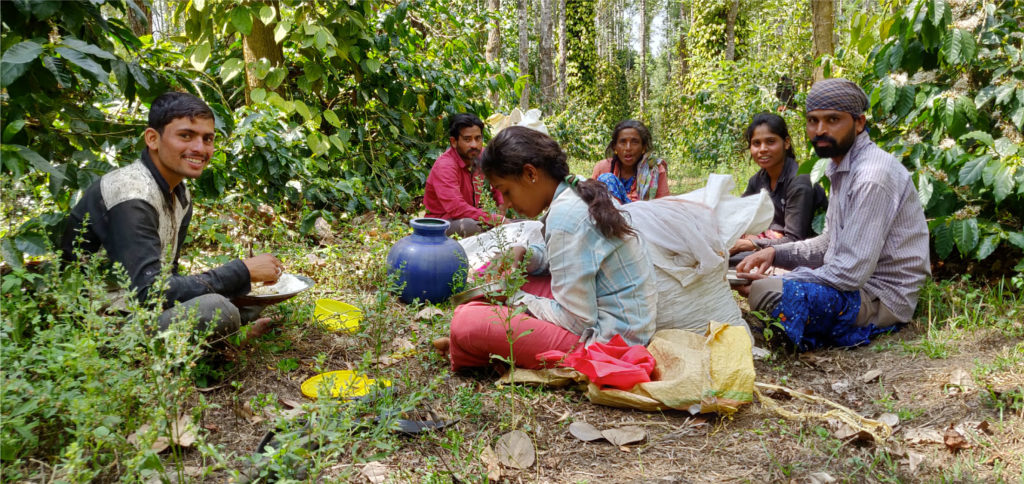
Coffee laborers having lunch on a coffee farm.
Iterating relevant service design and a weather service at scale
Commencing in May 2022, we will conduct multiple rounds of in-depth qualitative interviews with men and women coffee farmers. The sample will include farmers working a range of landholding sizes and will include both smartphone and feature-phone owners. The objective of the first set of interviews is to better understand how coffee farmers make decisions relating to the timing of agronomist-identified, weather-dependent coffee activities: fertilizer and lime application, coffee pruning, shade regulation, and harvesting. We hope to identify how weather fits into these decisions and what other factors influence the timing of these activities. If other limiting factors (such as the availability of an input) impact timing to a greater extent than the weather, forecast information with short lead times may not help farmers optimally time their practices without access to complementary inputs or information. These interviews will also help us identify how farmers interpret weather forecasts they already have access to, what impact incorrect forecasts have on their activities and on their trust in forecasts and the extent to which farmers discuss their expectations of upcoming weather with other members of their communities.
As detailed in previous blog posts about our weather-related work, PxD is partnering with leading private forecast provider CFAN (Climate Forecast Applications Network) to develop calibrated custom forecasts. Using weather forecasts from CFAN provides access to a continuous stream of information, which includes the numerical quantity of a rainfall event being forecast, numerical probabilities associated with a forecasted weather event, and error margins on the quantity of rainfall forecast for each of the upcoming 15 days3Read more about our collaboration in this previous blog post. Building on the first set of qualitative interviews, we plan to assess (1) whether farmers comprehend and have an appetite for probabilistic and uncertain information; (2) whether specific forecast attributes or lead times meaningfully change farmers’ expectations of upcoming weather; and (3) which combinations of attributes and lead times aid decision-making for each weather-dependent activity. We plan to gauge farmers’ understanding of probabilities and uncertainty in a second set of in-person interviews to whittle down the forecast formats that will be most useful in this context.
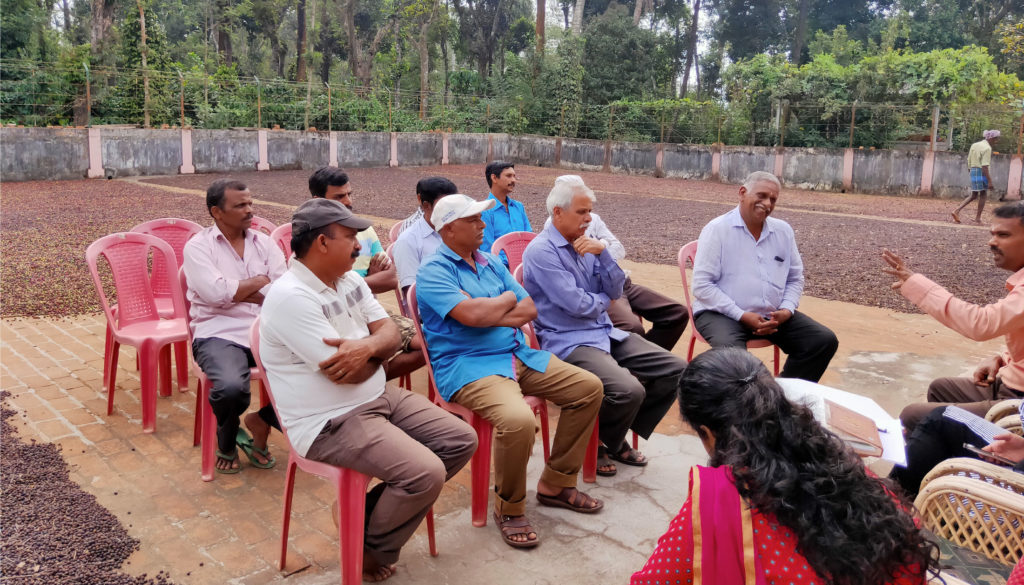
PxD facilitated Interviews with coffee growers.
Coffee farmers in a subset of villages in our three study districts will then be invited to participate in in-person workshops, where they will interact with different forecasting formats. The workshop will be in the form of a ‘lab-in-the-field experiment’, where participants engage with an interactive platform that presents weather forecasts together with incentivized agricultural decision-making scenarios. Utilizing participants’ decisions on the platform, an ‘in-scenario’ weather ‘realization’ will be simulated, allowing participants to accrue a higher payoff for a ‘better’ decision. The best-performing forecast will accrue the highest cumulative payoff across participants and will inform our understanding of which forecast formats most effectively aid decision-making. The ‘best-performing’ customized-to-context weather forecast will then be piloted in the field among a sample of existing CKT users to evaluate whether it improves decision-making in a real-world setting.
Delivering an effective weather-based advisory service via mobile phone also requires that we ensure that users engage with and use the information being delivered. To this end, we plan to run A/B tests to optimize the frequency with which weather forecasts are delivered, the length of messages, and other service features.
We are optimistic about the utility of weather forecasting information and its potential impact on smallholder farmers — and their productivity — as they make what we hope will be more informed decisions. We are excited to deploy this information and make it actionable for smallholder coffee producers on our CKT service. Watch this space!

Precision Development (PxD) has completed a landscape analysis to more systematically understand the challenges faced by users of the Coffee Krishi Taranga (CKT) service, with a focus on three core areas, namely, sustainability, market linkages, and gender. This work was funded by a grant from the Walmart Foundation.
As part of the landscape analysis, we conducted multiple rounds of farmer interviews, an extensive review of the literature, an analysis of our existing farmer database, and interviews with sectoral experts. In this blog, we share some key findings and information about what we’re looking to do next.
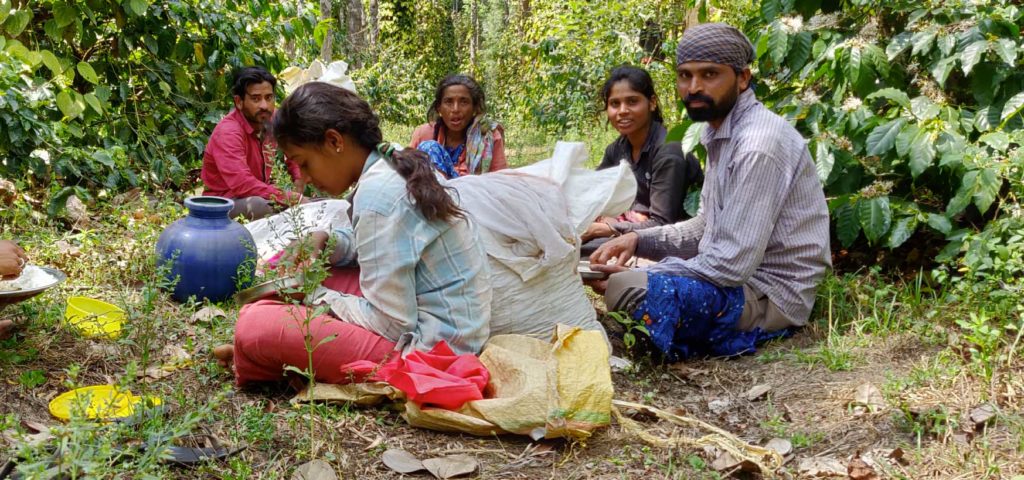
Coffee Krishi Taranga
Since August 2018, PxD has partnered with the Coffee Board of India to provide the CKT service to coffee growers. The CKT service is modeled on PxD’s flagship two-way Interactive Voice Response (IVR) service, which comprises an outgoing service that provides regular advisory to growers on their mobile phones and an inbound hotline that farmers can call to access free information services, including market-related information, and leave messages to be answered by agronomists. As of April 2022, the CKT services approximately 74,000 coffee growers across the states of Karnataka, Tamil Nadu, and Kerala. The team plans to expand the reach of the service to growers in Andhra Pradesh soon.
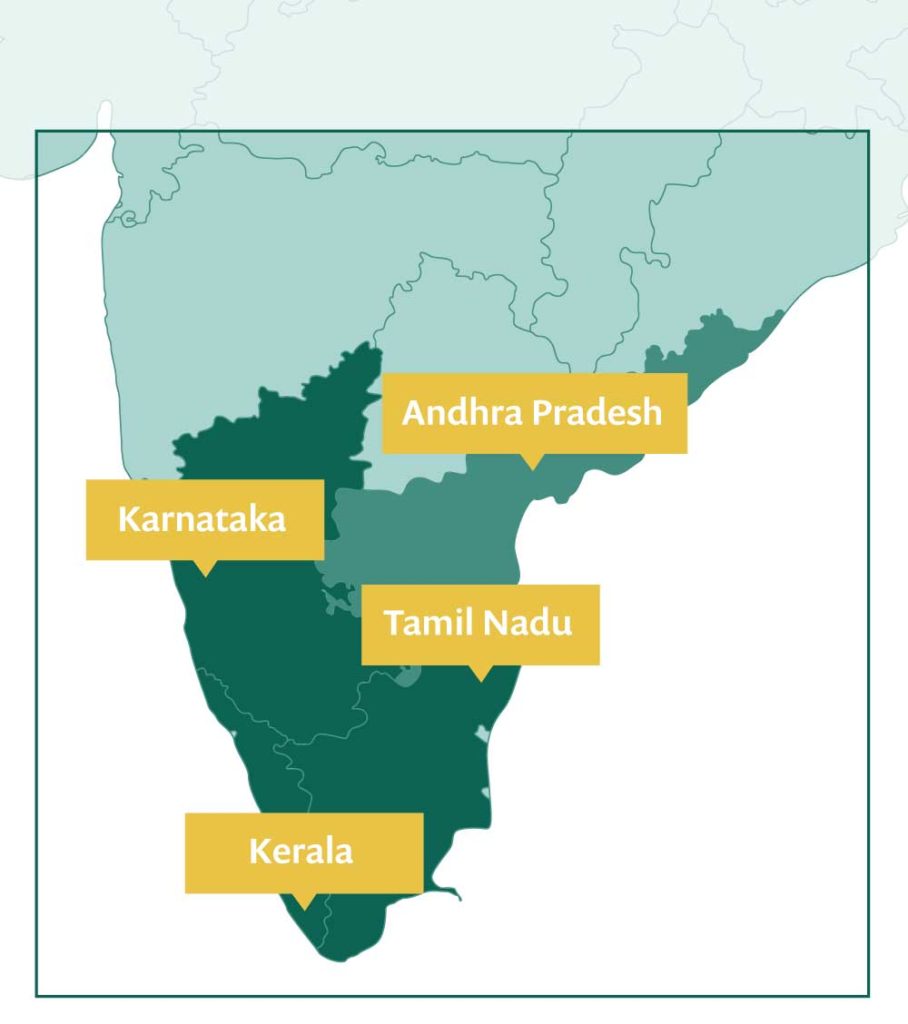
Key findings
Sustainability
Coffee growers in India face multiple risks linked to weather unpredictability, a challenge that has been exacerbated by climate change. Coffee is a sensitive crop, and heat and rainfall are widely considered to be the two most important factors for coffee growth1Haggar, J. and Schepp, K. (2012). Coffee and Climate Change Impacts and options for adaptation in Brazil, Guatemala, Tanzania and Vietnam. National Resources Institute Working Paper Series: Climate Change, Agriculture and Natural Resources, [online] No. 4, pp.1–50. Available at: https://www.nri.org/publications/working-paper-series/4-coffee-and-climate-change/file [Accessed 14 Sep. 2021].. In farmer interviews conducted in September 2021, 92% of farmers (N=83) said they had faced a weather-related challenge in the past year2Haggar, J. and Schepp, K. (2012). Coffee and Climate Change Impacts and options for adaptation in Brazil, Guatemala, Tanzania and Vietnam. National Resources Institute Working Paper Series: Climate Change, Agriculture and Natural Resources, [online] No. 4, pp.1–50. Available at: https://www.nri.org/publications/working-paper-series/4-coffee-and-climate-change/file [Accessed 14 Sep. 2021].. Weather can negatively impact the cultivation of coffee in a variety of ways, including crop damage at sensitive times such as blooming3Pokiya, T. (2021). Interview: Agronomist, PxD. 16 Jun. , increased incidence of pests and disease, increased soil erosion, and more.
What are we doing?
One obvious solution to mitigate the risks of weather variability is weather forecasts, in particular providing customized weather forecasts or real-time weather information, potentially coupled with relevant agronomic recommendations. However, access to high-quality forecasts is limited. In our farmer interviews, only 16% (N=73) said they have access to forecasts4 Krishi Taranga coffee growers (2021). Qualitative farmer surveys: Round 5. 24 Sep.. Our team is currently in the process of putting together a pilot to test the impact of providing customized weather forecasts on key agricultural practices (if you’re interested in learning more about PxD’s weather-related learnings, check out this recent series of blogs).
“The weather imbalance leads to severe black rot and we cannot use spray at the right time.”
Interview with D.S. Sathish, Basrikatte, Chikmagalur
The increase in average temperature and erratic rainfall also exacerbates risks associated with certain pests5 Watts, C. (2016). A Brewing Storm: The climate change risks to coffee. [online] The Climate Institute, pp.1–14. Available at: https://www.juntospelaagua.com.br/wp-content/uploads/2016/09/Pesquisa-sobre-caf—The-Climate-Institute.pdf [Accessed 14 Sep. 2021].. The impact of climate change on pests varies, but overall heavy rain and warmer temperatures are likely to increase the conditions in which several pests thrive. These pests can cause varying levels of damage — some can be devastating, resulting in crop losses of up to 70% if not treated timeously and effectively.6Machenahalli, S., Ranjini, A. P., Madhu S., Giri, Sudha M., Daivasikamani, S. and Surya Prakash Rao N. (2019). Disease of Coffee during monsoon season and their management. [online] Planter’s World, May, pp.4–7. Available at: https://krishi.icar.gov.in/jspui/bitstream/123456789/23682/1/coffee%20disease%20during%20monsoon.pdf [Accessed 14 Sep. 2021].
To explore ways to provide more targeted and actionable recommendations for pest management, we ran an A/B test in November 2021 that looked at the impact of sending multiple reminders on farmers’ knowledge and adoption of high impact practices. We focused on the treatment of white stem borer, an increasingly common pest for coffee growers in India. The results from this test will be shared shortly!
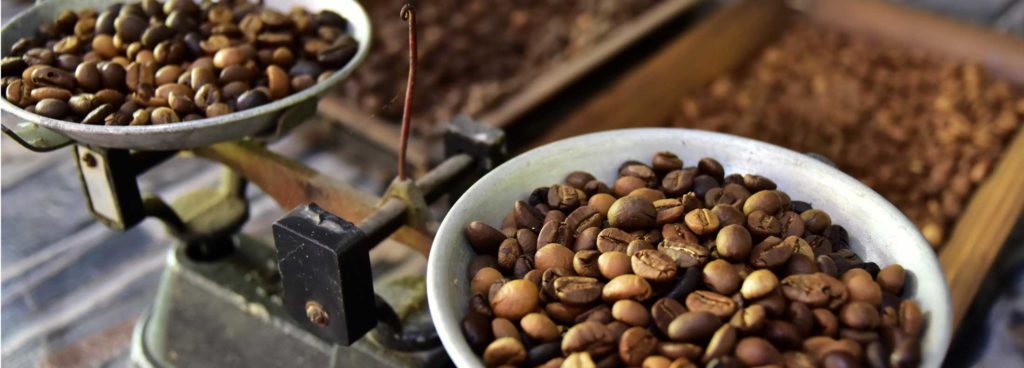
Markets
Smallholder coffee growers sell their produce in fragmented and exploitative local markets. A survey from Chikmagalur and Hassan districts (Karnataka) found that over 90% of growers sold their produce at the farm gate7 Babu, P. (2019). Value Chain Upgrading Strategies for Integration of Indian Small Coffee Growers in Global Coffee Value Chain. Economic Affairs, 64(4).. In our interviews, we found approximately 50% of farmers (N=140) sell their coffee to local traders or markets8Krishi Taranga coffee growers (2021). Qualitative farmer surveys: Round 1. 6 Jul.. There are several reasons why these selling conditions are less than ideal. This includes a lack of infrastructure: smallholders, who deal with relatively small amounts of coffee, usually sell directly to a local trader or agent who pays them on the spot and bears the costs of transporting the coffee to the curing agent. This is where smallholders often lose value on their coffee as local traders set the price for the farmers’ produce.
Another concern is high price variability and lack of transparency. Local traders set coffee prices according to international coffee trends. When buying from farmers on the ground, this price is adjusted based on the quality of the product, which is measured by moisture and out-turn tests. However, the degree to which prices are adjusted based on these metrics is not always clear, leaving farmers feeling frustrated.
“Traders will not buy coffee at existing coffee prices. When traders provide information about prices [they say] it will be more, but [when it comes to] selling the coffee, traders fix a certain [lower] rate and give the unnecessary reason that the moisture content is not good.”
Interview with A.G Nannaiah, Virajpete, near Madikeri
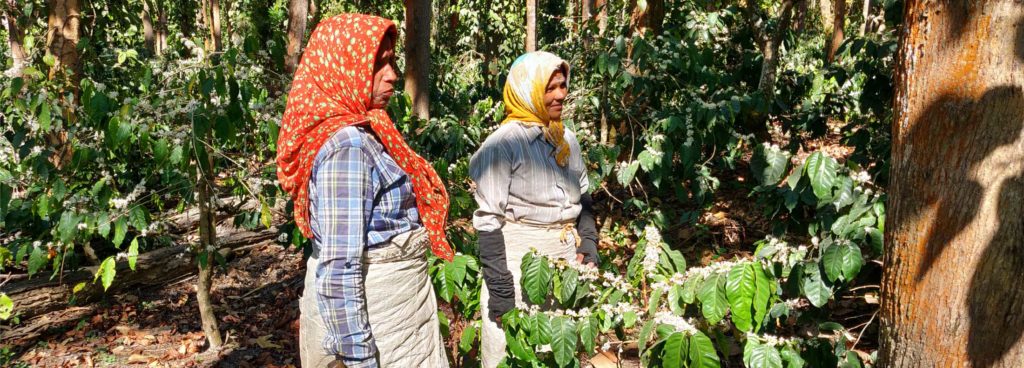
What are we doing?
As part of the CKT hotline, we offer a free price feature which farmers access to listen to daily local and international price information. This is our most used feature, indicating interest in price information. However, overall usage of the hotline is low. We are currently exploring alternative ways of delivering price information to our farmer base, in the hope of reducing frictions and increasing the use of market price tools and information. Lines of relevant inquiry include exploring the use of WhatsApp and SMS to provide price alerts.
To explore ways of reducing price variability, which contributes to income volatility and uncertainty, the PxD team is running a market linkages pilot with the Sustainable Trade Initiative (IDH) in Karnataka. IDH will facilitate contracts between interested buyers and smallholder growers, in which buyers commit to purchasing produce (granted it meets certain quality conditions) at a fixed price. PxD will support growers in meeting these conditions by disseminating relevant agricultural information.
Gender
“My wife visits the estate whenever it is necessary, for example if I am away from the station she looks after things, and after the harvest and the coffee is dried, she weighs it and keeps a record of the quantity of coffee available after it has dried.”
Interview with Virajpete Madhayya, Madikeri
As per India’s Census 2011, coffee plantations were major employers of women workers in Karnataka; out of a total of 480,000 average daily workers employed in coffee plantations, 62% were women. Women appear to be employed for specific activities such as coffee picking, weed management, and applying manure and chemical fertilizers 9Joy, C.V. (2004). Small Coffee Growers of Sulthan Bathery, Wayanad Kerala Research Programme on Local Level Development Centre for Development Studies Thiruvananthapuram. [online] Centre for Development Studies, Kerala, India: Centre for Development Studies, pp.1–43. Available at: http://www.cds.ac.in/krpcds/publication/downloads/83.pdf [Accessed 29 Oct. 2021].. In our interviews with women, we found that women are heavily involved in specific coffee-related activities, including weeding and coffee picking. While women are generally not primary decision-makers for most activities, they appear to be included in the decision-making process. We also learned that women are often part of community groups including self-help groups like “Swasahaya Sangha” (for more information, see our blog post on women’s groups).
What are we doing?
We would like to explore the role of women’s groups and whether these can be leveraged to increase engagement with, and provide relevant support to, female farmers. Evidence from our other programs and the literature suggests that women can increase their collective knowledge and engagement through participating in community groups. The fact that many women in our service are generally involved in day-to-day decision-making suggests that there is room to cater specifically to the areas in which women work. This includes exploring value chains adjacent to coffee cultivation where women may have more involvement, for example, intercrops like spices.
Looking forward
The landscape analysis helped our team gain a broader understanding of the range of challenges and opportunities that exist within the coffee sector in Southern India. In doing so, we have been able to strategize and set evidence-based priorities. This includes focusing on addressing weather-related risks through a pilot to test the impact of providing customized weather forecasts to coffee growers, and a market-focused pilot with IDH.
At the same time, we are also scaling our program with the support of the Walmart Foundation. This includes expanding to another coffee-growing state, Andhra Pradesh. Coffee growers in Andhra Pradesh are different from those in Karnataka, as they are primarily based in tribal regions and practice more traditional farming. We are excited to learn more about coffee growers in this region and adapt our existing service to address their unique information needs.

Precision Development (PxD) recognizes that the informational needs of poor women farmers, and the challenges they confront, are unique. As a consequence, our services must be tailored to reach and be relevant to the needs of women users. Driven largely by the onboarding of women active in livestock-related activities, the number of women farmers active on platforms built by PxD increased by approximately 46% over the course of 2021. This included the onboarding of over 150,000 women farmers to our Ama Krushi (AK) service, which we deliver in partnership with the Government of Odisha, India. As we mark International Women’s Day, we reflect on efforts we have made to improve our understanding of gendered divisions of labor and bargaining power within Odishan smallholder households, and steps we are taking to assist women farmers make more informed decisions.

Scoping work undertaken by PxD suggests that women farmers spend more productive hours on livestock farming than men. However, women farmers disproportionately lack access to mobile phones and, by extension, digitally conveyed information. Perhaps the largest impediment to increased engagement with PxD’s advisory on the part of women farmers is access to information, and patterns of information sharing within households. This could have knock-on effects that undermine women’s productivity and bargaining power within the household. To further understand these dynamics, we explored if sending messages encouraging information sharing within households can assist in breaking this cycle.
The motivation
Gendered roles in livestock farming
In June 2021, we conducted a survey to improve our understanding of gender roles in livestock farming in Odisha. The sample consisted of 5,354 AK farmers who have subscribed to livestock-related advisory, practice cow-rearing, and had received at least one livestock advisory message via the AK service. The sample included equal numbers of male and female users and was stratified by the farmer’s district. Of this sample, we successfully surveyed 1,475 AK farmer users.
We found that, on average, women AK users allocate more time to livestock rearing and household chores than male AK users (Table 1). Relative to male AK users, women spend less time on cropping activities and on other non-livestock-related income-generating activities.
The survey also found that men AK users are significantly more likely to perform—and be the primary decision-maker for—livestock-related tasks that require travel outside of the home. These types of activities include veterinary visits, purchases of livestock-related inputs, selling milk, and sourcing fodder. Women, on the other hand, are more likely to be involved in livestock-related activities performed at home, such as cleaning sheds, feeding, and milking animals. Given the heavy involvement of women farmers in livestock-related activities, it is important that livestock advisory broadcast via our AK service is communicated to women household members if it is to be practical.
Importantly, many income-related improvements in livestock outcomes—such as increasing milk yields and successful breeding—depend on the coordination of multiple tasks performed by both men and women within a household. For example, successful breeding requires the completion and timely sequencing of tasks and processes, including the provision of sufficient nutrition, deworming, heat detection, and accessing artificial insemination (AI) services. To achieve these ends, it is important that livestock advisory reaches both women and men in the household, and that intra-household communication is sufficient to coordinate improved livestock outcomes and household welfare maximization.
Barriers to information for female farmers
Reaching female farmers through mobile phone extension services is challenging as men farmers are more likely to be the primary owners of mobile phones in the household (OECD, 2018; Baroni et. al., 2018). Evidence suggests that women registered as subscribers to PxD’s mobile advisory services have shared access to phones and male partners are the devices’ primary users. PxD uses polling surveys to maintain and improve quality service delivery, and to source feedback from users. Women AK users polled for our May 2021 livestock survey self-reported lower pick-up rates than male respondents. However, actual outbound AK administrative data does not reflect a gendered disjuncture in pick-up rates. An explanation of this could be that the household member who picked up the phone when an AK call was placed to a women farmer was not the registered woman user. Similarly, during this gender survey in Odisha, we asked the respondent who picked up the phone if they were the registered AK user. In the case of registered women AK users, someone else picked up the call 12% of the time, compared to only 5% in the case of registered men AK users. This difference is statistically significant at the 1% level. This suggests that when a phone is being shared, registered users that are women have less time with the phone than men. Given the greater engagement of women in livestock-related activities, this gendered barrier in mobile phone extension services is a significant challenge.
To gather more evidence on AK users’ individual access to mobile phones, we asked about a quarter of the AK users in the Gender Scoping Survey (n=370) about their typical access to mobile phones between 6 a.m. and 9 p.m. every day. Women AK users reported less availability at all times of the day (Figure 1). However, the difference is only statistically significant at the 10% level for the 3 p.m. to 4 p.m. period (both in the full sample and the married-only sample). Due to the smaller sample size, we may be underpowered to detect other differences.
Figure 1: Gender differences in individual access to phone
Interestingly, when we restrict the analysis to household heads only, women report higher average access to their mobile phones than men. The Gender Scoping Survey finds that the time-use patterns of women heads of households closely follow those of men heads of households (Table A1), there are a few possible reasons for this deviation in self-reported access to mobile phones. A possibility is that male heads of households are more likely to share their phones with their spouses or children. By contrast, the Gender Scoping Survey found that women heads of household are typically unmarried (or widowed, separated, or divorced) and therefore may not need to share their phones as much as men heads of household.
Consistent with the evidence above, the Gender Scoping Survey finds that men AK users are significantly more likely to cite Ama Krushi as a primary source of livestock information than women AK users (Table 2), while the polling survey finds that women AK users are significantly less likely to answer knowledge questions based on livestock advisory sent in the month preceding the survey correctly.
Importantly, AK users seldom cite their spouses as a source of livestock information or as someone they discuss new livestock information with, a gap in intra-household information transfer that PxD could potentially influence. Improving intra-household communication can potentially increase the reach of PxD’s advisory to existing registered women AK users who may not be picking up the outbound advisory, but also extend the reach of our advisory to the wives and women children of men registered as AK users on the livestock service.
Adoption: Individual vs joint access to information
To better understand intra-household dynamics of information transmission and adoption, we asked respondents to the Gender Scoping Survey if they find it easy to convince their spouses to adopt new livestock practices when they receive such information. Of the respondents, 76% replied yes to this question, and we found no significant differences by gender. This percentage increased to 90% when we asked if listening to the advisory jointly with their spouses on the phone’s speaker would make it easier for them to adopt the recommended practices. A gendered analysis of this increase did not detect a statistically significant difference between men and women users.
Therefore, we find suggestive evidence that getting livestock recommendations to female farmers is the primary barrier to increasing the benefits accruing to our digital advisory. When women farmers receive advisory, they may be just as likely to influence adoption decisions as men farmers. Additionally, increasing the shared knowledge of the spouses has a greater potential to increase adoption rates than individual access to information.
Calibrating solutions
The phone’s speaker
One possible solution to reach more women farmers and promote information sharing among spouses is to encourage respondents who pick up advisory calls to use their phones’ speakers to listen to the advisory with other household members. We wanted to pilot a nudge to male livestock farmers to listen to advisory messages with their speakerphone turned on with other household members engaged in livestock-related activities. However, we first needed to know if farmers could use their phone’s speaker. We conducted a speakerphone feasibility survey to understand:
- Whether farmers can use their phone’s speaker by themselves.?
- If not, can we deliver simple instructions during the phone call so that farmers can use the phone’s speaker?
- Whether we need to build in a time allowance for farmers to activate their speaker and listen to advisory with their household members.? If so, then how much time?
- Whether farmers are willing to use their phone’s speaker and listen to the advisory with other household members.?
Of the 90 respondents who consented to the survey, 76.67% could turn on their phone’s speaker without any instructions (67.92% of feature phone users and 89.19% of smartphone users). Following simple instructions on how to use their speaker, 84.44% of respondents could do so. Overall, 89.19% of respondents were able to turn on their phone’s speaker within 10 seconds of being asked to do so, and of those, 96.2% were willing to use their phone’s speaker to listen to future AK advisory with their family members. As a consequence we are confident there are no large technical or aspirational barriers to adopting the nudge and we moved to pilot it in different forms.
Assessing potential interventions
These results encouraged us to test nudges in three ways for one month:
- A separate IVR nudge asking users to call into our inbound service for joint-listening over their speakerphone (n=600);
- A text 20 minutes before the weekly livestock advisory asking them to turn on their phone’s speaker and listen to the advisory with members of the household involved in livestock-related activities (n=500);
- An additional script at the start of the weekly livestock outbound with the same nudge as in Method 2 (n=500).
All the nudges were sent between 6 and 8 pm based on the findings on joint availability in the gender survey. Before implementing an A/B test to measure the effectiveness of these interventions, we conducted small pilots to select the most promising methods.
In the pilot, we did not find that nudging farmers to use the inbound services (Method 1) was very successful. We sent a nudge call to 600 farmers, asking them to dial a toll-free number to listen to the livestock advisory on the speakerphone with their family. A total of 12 people (and 14 total calls) dialed into the service within a week of the nudge, but none accessed the feature to listen to the livestock advisory. While this does not eliminate the possibility that nudged farmers discussed the call’s content with their spouses, we did not pursue this method to achieve the specific objective of joint listening.
For farmers who were nudged through an SMS (Method 2), using a short survey, we found that only 4% of respondents recalled the nudge’s content (n=126). We concluded that this method was unlikely to translate into increased joint-listening or improved knowledge and adoption.
Using another short survey, we found that farmers who were nudged in the introduction of the weekly livestock outbound advisory (Method 3) were 22 percentage points more likely to report having listened to the advisory message jointly with household members than those who received the regular outbound advisory (ntreatment = 61; ncontrol=45). As this method showed the most promise, we conducted an A/B test deploying it to 17,000 farmers over ten weeks starting in late October. We are currently reviewing data from this test and will share the learnings when they are available.
The authors would like to thank Qi Xue, PxD Intern, who offered valuable assistance in executing the surveys and preliminary analysis underpinning this post, as well as Niriksha Shetty, Tomoko Harigaya, and Otini Mpinganjira for their insights and guidance.
Appendix:
Accurate weather forecasts would reduce uncertainty for farmers, yet they are under-supplied and under-studied in developing countries. Government and market failures reduce the quality and reach of weather information in rural regions, reducing its value for households. To address these gaps, Precision Development (PxD) is piloting the provision of improved forecasts to farmers in India and Pakistan. The pilot will investigate how farmers interpret and use weather information, including the cognitive and informational barriers that constrain adoption.
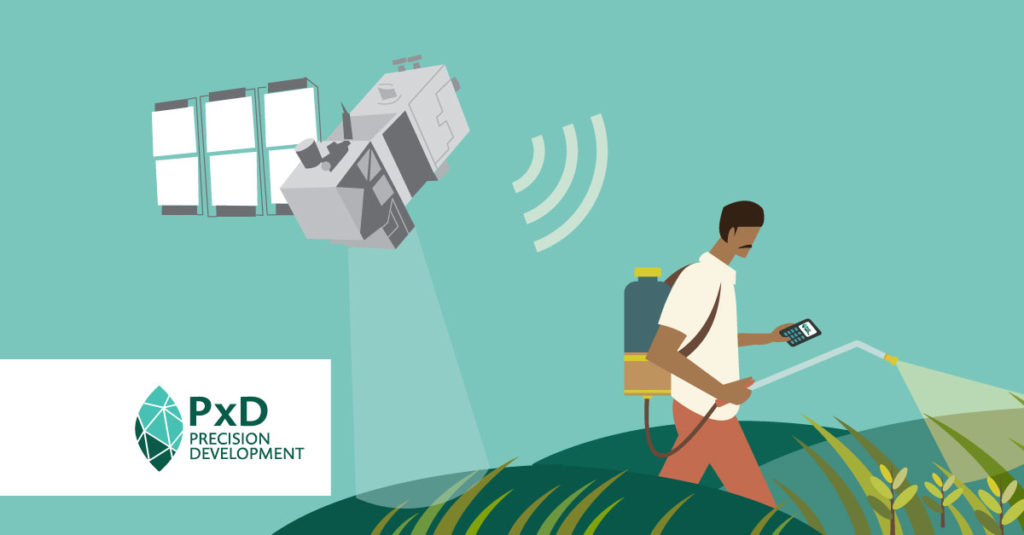
The costs of weather uncertainty
Smallholder farmers live with copious amounts of risk, leaving them vulnerable to income variability and losses. Weather uncertainty is a major source of this risk. A survey of farmers in poor, southern districts of India, for example, found that 73% of respondents had abandoned their crop at least once, in the ten years prior to being surveyed, after misjudging the onset of the monsoon; and one quarter had replanted (Giné et al., 2015). These activities are costly: the authors rank farmers by the accuracy of their monsoon predictions and show that the gross agricultural income of those in the 25th percentile is 8-9% lower than those in the 75th percentile. Other research documents how farmers respond to weather uncertainty by reducing investments in technologies or complementary inputs, which lowers their average profits (Zimmerman and Carter, 2003; Rosenzweig and Binswanger, 1993).
Because weather variability can be disastrous for poor households and is increasing with climate change, economists have dedicated much attention to products that mitigate its consequences, including index insurance and climate-resilient crop varieties. While effective in increasing farmers’ investments and profits, many of these innovations incur high distribution costs that limit their scalability (Cole & Xiong, 2017). PxD is therefore exploring an alternative solution for farmers that face increasing climate risk: accurate, phone-based weather forecasts.
Forecasts have a high potential for cost-effectiveness and scale. By reducing uncertainty over future conditions, they allow farmers to make better production decisions throughout the season. Long-range forecasts of conditions over one to three months can enable farmers to make more informed decisions about how much to invest or which crops to grow, while shorter-range products can be used to determine the best time to conduct activities like fertilizer application. These decisions have the potential to generate meaningful yield impacts; PxD’s agronomy team in India estimates that transplanting rice seedlings from the nursery to the field at the right time can generate yield increases of up to 10%, relative to transplanting too late. Moreover, the marginal cost of delivering phone-based forecasts is low relative to other products that reduce risk, meaning that the returns to their provision would increase with scale.
Currently, however, rigorous evidence on weather forecasts’ effects on farmer outcomes is sparse. Part of the reason may be the limited availability of accurate, useful forecasts in many developing countries. Producing high-quality weather predictions is costly and complex: state-of-the-art observation infrastructure, rapid data transmission systems, high-performance computing, and specialist staff are all required (Rogers et al., 2019). Cash-strapped public providers often lack this capacity, while the private sector has few incentives to serve poor consumers. As a result, the forecasts that smallholders can access are typically well behind the technology frontier.
The limited evidence base suggests that these quality shortfalls reduce forecasts’ value for farmers. For example, an observational study in India found that state-provided seasonal forecasts do increase agricultural profits, but only in the few areas where forecasts happen to be accurate (Rosenzweig and Udry, 2019). Additionally, in Ghana, preliminary results from an experimental evaluation of 48-hour, SMS-based forecasts, found effects on farmer behavior but not on profits (Fosu et al., 2018). Short lead times and a lack of complimentary advice may explain the lack of impact: a review of farmer-focused forecasts in developed countries finds that these factors reduce take-up and usefulness (Mase and Prokopy, 2014).
Unlocking the potential of weather forecasts
PxD’s new pilot aims to build the evidence on the benefits of improved forecasts for smallholders. We have partnered with the Climate Forecast Applications Network (CFAN), a private provider with expertise in developing innovative weather information tools in South Asia, to deliver hyper-local forecasts and related advisory to smallholders in India and Pakistan. CFAN’s products are anticipated to improve on existing forecasts in the region in terms of accuracy, lead times, and precision. Importantly, they can also be calibrated to predict weather phenomena that are particularly relevant for agricultural decision-making, such as prolonged dry spells suitable for fertilizer application or monsoon onset dates.
PxD’s pilot activities will test the efficacy of different intervention designs in both contexts, laying the groundwork for a large-scale randomized evaluation of weather forecasts’ effects on agricultural outcomes that we hope to implement in 2023. Some of the questions we will explore during this preliminary phase include:
- To what extent do farmers update their subjective weather expectations in response to different forecasts? What role do informational, cognitive, trust or other barriers play?
- How do farmers interpret probabilistic weather information? Do forecasts with a numeric probability of a weather event and a qualitative likelihood of the same event affect their beliefs differently?
- For which agricultural decisions could improved forecasts generate the greatest returns?
- Does improved weather information spread among farmers within and across villages?
The findings of the pilot and subsequent evaluation will have policy implications at PxD and beyond. For example, improved understanding of the returns to information products that reduce agricultural risk will inform PxD’s prioritization of new services, such as pest prediction models. The project will also seek to provide policymakers with evidence and incentives to increase funding to improve forecasts in regions that are under-served by governments and markets.
Many thanks to Sam Carter, Jonathan Faull and Yifan Powers for their excellent comments and suggestions on an earlier iteration of this post
Can e-commerce address constraints that inhibit growth and productivity among Indian smallholder farmers? Rohit Goel, a Research and Operations Associate on PxD’s India Team, investigates and traces the contours of an exciting PxD pilot in Gujarat which aims to connect smallholder farmers to online vendors and marketplaces.
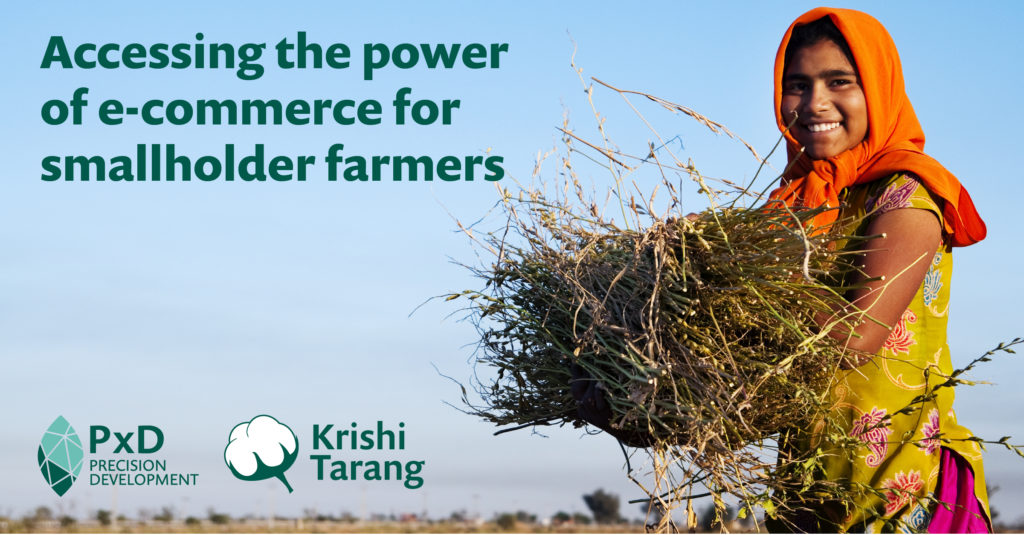
E-commerce – the buying and selling of goods and services over an electronic network – has transformed business operations in India. In 2020, the market size of e-commerce in India was assessed at 64 billion USD in 2020 and is expected to rise to 200 billion USD by 2027. This rapid growth in e-commerce has the potential to address long-standing deficiencies in the Indian agricultural sector, and transform Indian agriculture – a sector that accounts for 18.3% of India’s GDP (2020) and is the primary source of income for a majority of Indian households. This opportunity presents itself at a time when the sector is declining in productivity due to a range of challenges including a constrained supply of inputs, inefficient sales markets, and low levels of competition among intermediaries across supply chains. However, India’s agriculture sector is poorly positioned to capitalize on the opportunities presented by e-commerce due to challenges confronting smallholder farmers in rural areas, such as low levels of digital literacy, poor ICT infrastructure, a lack of familiarity with digital transactions, and inequitable access to smartphones and/or the internet.
Precision Development (PxD) is well-positioned to assist firms and farmers overcome these and other access and market-related challenges. With support from the Swiss Re Foundation, we are utilizing our voice-based, two-way information exchange service – dubbed Krishi Tarang – to pilot an initiative to inform farmers about, and connect them with, a variety of businesses that address unmet needs at different points across the agricultural value chain – including, but not limited to, input suppliers, crop offtakers, lending agencies, crop insurance providers, soil testers, and carbon traders. Krishi Tarang operates using Paddy, PxD’s in-house communications platform, and is compatible with very basic mobile phones that lack internet capabilities. The pilot will also explore revenue generation opportunities to support the scaling of free, customized, and timely agricultural advisory services to smallholder farmers and endeavors to complement the work of other not-for-profit organizations working to improve farmer livelihoods so that their farmers can take advantage of these new partnerships too.
Creating an online ecosystem for smallholder and village farmers
With support from the Swiss Re Foundation, PxD is working to holistically address farmer needs by creating an ecosystem of private partners along the agricultural value chain. Moreover, we are investigating ways in which new partnerships can generate revenue to support free digital agricultural advisory services for smallholders. The successful implementation of an integrated service offering at scale has the potential to reduce farmers’ overall costs while enhancing their revenues. We also hope that this initiative will generate new insights that help us to make our advisory service more relevant and, by extension, improve adoption rates of PxD’s recommendations among farmers.
Since December 2020, PxD has run a pilot project with farmers registered on our Krishi Tarang advisory service in Gujarat. As part of the pilot, PxD contacts farmers via channels, such as automated and live calls, to promote the services of our partners. Farmers who show interest in a particular service are then connected to service providers. PxD takes a nominal commission on every successful transaction initiated by Krishi Tarang farmers and, in certain instances, a fixed fee for connecting each new farmer. In this way, PxD’s farmers can connect with a series of legitimate e-commerce partners to access various goods and services such as business development and market linkages, agricultural inputs, financial support, and field-level technology. Since the farmers do not need an internet connection or smartphone to access these services, we can circumvent some persistent barriers to entry and access, and connect marginal and smallholder farmers to online vendors. We hope that competition among vendors will improve and draw an increased number of users and service providers to the village and smallholder marketplace.
E-commerce’s transformative potential
In 2016, 59% of India’s workforce was employed in agriculture. In rural areas, dependence on farming activity is widespread, with 70% of households relying on agriculture to support their livelihoods. According to the Food and Agriculture Organization (FAO), 82% of India’s farmers are small and marginal farmers. Despite the importance of agriculture for so many Indian households, the contribution of agriculture to GDP has fallen precipitously in recent decades, declining from 41.3% in 1960 to 18.3% in 2020. Given the large share of Indian households that continue to depend on agriculture to support their livelihoods, and the number of poor households dependent on the fortunes of the sector in particular, declining productivity and profitability in the sector is a significant concern.
E-commerce has the potential to address several challenges constraining the performance of India’s agriculture sector by creating new links between participants along the agricultural value chain. Examples of potential benefits include:
- Waste reduction: According to the Food and Agriculture Organization (FAO), a third of food produced for human consumption is wasted. A study by the Indian Council of Agricultural Research in 2016 reported losses of approximately 5.5% for cereals, pulses, and oilseeds, and approximately 11% for fruits and vegetables, due to waste during harvesting, post-harvesting, handling, and storage. Agriculture e-commerce services can reduce post-harvest waste by minimizing the number of intermediaries farmers need to liaise with, improve access to more efficient transportation, and quicker access to quality storage facilities. At the aggregate level, these effects can substantially reduce the time it takes for produce to reach consumers.
- Overcoming information asymmetries: There is some evidence that mobile phones improve farmers’ access to information with potentially positive implications for their incomes, although the findings are mixed. Muto & Yamano (2009) found that increased phone coverage in rural Uganda, between 2005 and 2009, was associated with a higher probability of banana sales and an increase in the sale price of bananas. However, this pattern was not evident for maize, a non-perishable crop, suggesting that price information may be more important for products with a shorter shelf life. Jensen (2007) found that the introduction of mobile phones in Kerala was associated with an increase of 8% in fishermen’s profits, driven by reduced wastage. However, other papers have found little impact of ICT on farm prices and farmer income. For example, Aker and Fafchamps (2015) examined mobile phone expansion in Niger, and Futh and McIntosh (2009) examined the introduction of village phones in Rwanda. Neither evaluation found evidence that increased access to phones was associated with price changes.
- Financial inclusion: When agricultural e-commerce platforms store transaction records, they may offer farmers an opportunity to build a “digital history” that could, in turn, allow them to demonstrate farmers’ creditworthiness to financial service providers. Francis, Blumenstock and Robinson (2017) identified credit scores, captured from the historical user data using mobile phones, as one of the major factors leading to creating a digital credit system. Digital credit lowers transaction time and reduces costs compared to conventional credit, and borrowers generally do not need collateral to be approved for digital loans. According to GSMA’s report, in 2018, 866 million people have mobile money accounts processing 1.3 billion USD daily. Sub-Saharan Africa accounted for 45.6% of the mobile money activity in the world; and technology companies, credit bureaus, and banks are opting for smartphone digital credit scoring for their business.
- Improved cost and market efficiency: The potential economic benefits of agriculture e-commerce may serve as an incentive for farmers to increase their on-farm investments and productivity. In addition, farmers may gain access to higher-quality inputs through online suppliers than they can find in their local markets. For example, Bergquist and McIntosh (2021) find that the introduction of a mobile phone-based marketplace for agricultural produce in Uganda led to increased trade flows and reduced-price dispersion across markets, generating a cost-effective increase in farmer profits.
Ongoing Challenges
Agritech startups and other private firms are leveraging technology to provide farmers with access to new input suppliers and improve linkages to output markets. The market for digital agriculture services in India has grown rapidly in the past few years, with companies like Ninjakart, Big Basket, Grofers Agrostar, and BigHaat raising millions of dollars in start-up capital.
Despite the actions of these and other stakeholders, and evidence of benefits associated with e-commerce, the take-up of e-commerce services to support the agricultural sector in India has been limited. Key challenges include:
- Rural India lacks infrastructure for e-commerce. 70% of the rural households do not have an active internet connection, and only 4.4% of rural households own a computer.
- Middlemen continue to play a dominant role in agriculture markets and rural economies. Poor market linkages increase transaction costs and post-harvest losses. Poor market development enables middlemen to dominate critical roles and transactions across the supply chain in such a way that only a very small share of the final sales price reaches smallholder farmers. Moreover, middlemen and money lenders at the local level may function as local monopolies, further depressing farmers’ bargaining power and the prices paid for produce.
- Underdeveloped cold chains and long transportation times limit the transport of perishable goods, increase post-harvest losses and constrain market development.
- Farmers are unable or reluctant to adapt to online opportunities. PxD conducted qualitative interviews with 119 farmers registered on PxD’s service in Gujarat and Haryana in March, April, and May of 2021. Ninety-six percent of respondents reported that they bought their inputs locally, citing the quality of the inputs received, trust in the seller, and credit availability as their reasons for doing so. Only 13 farmers (11%) had ever purchased agricultural inputs online.
- In 2018, more than 19,500 languages or dialects are spoken by Indians as their mother tongue. The diversity of spoken and written languages and cultures makes it difficult for small firms to scale their services.
- While access to financial services has increased throughout the country in recent years – in 2017, 80% of adults had an account at a bank or other financial institution, more than twice the rate of account ownership in 2011, which was 35% – access to credit remains limited. And, while credit does not seem to be the primary constraint hindering farmers’ profits, credit products that are specifically designed to address farmers’ unique needs have been found to increase agricultural investment, output, and revenues (though impacts are affected by contextual factors like unpredictable price fluctuations and farmers’ relationships with traders). Limited borrowing ability may prevent farmers from taking advantage of the opportunities that e-commerce presents.
- Small, early-stage firms may struggle to enter and survive in the market. MicroSave Consulting highlights three key challenges confronting start-ups in India: Investors have limited willingness to offer long-term capital in a context in which agricultural investments typically take time to offer returns. Second, agricultural e-commerce may require partnering with the banks or government players, which impose operational hurdles. Third, agriculture-related data, required for many start-ups to identify and reach the farmers who might benefit from their services, can be difficult for new players to access.
Promising progress!
Leveraging this pilot, PxD aims to more systematically understand opportunities for, and constraints to, establishing an ecosystem of free agricultural advisory with a spectrum of agricultural and allied private organizations and service providers. By October 2021, PxD had signed partnership agreements with three input supply companies (BigHaat, Agrostar, and Behtar Zindagi), three market linkage organizations (Agri10x, Impagro, and Fruitfal); and we are actively discussing partnership opportunities with six other private sector firms that cater to different farmer needs across the cropping cycle from pre- to post-harvest.
There is growing interest among other farmer-facing non-profit organizations to join PxD so that farmers enrolled in their structures and services can benefit from this expanding ecosystem of private sector partners. In the medium term, we hope that government entities focused on improving agricultural outcomes will support similar models of engagement. We are confident that the development of such an ecosystem of non-profit, non-governmental, private, and public organizations will be effective in holistically addressing farmer needs in a cost-effective and more impactful manner.
Vaishnavi Surendra, Post-Doctoral Researcher, and Revati Vaidya, Process and Product Innovation Associate, mark the International Day of Rural Women
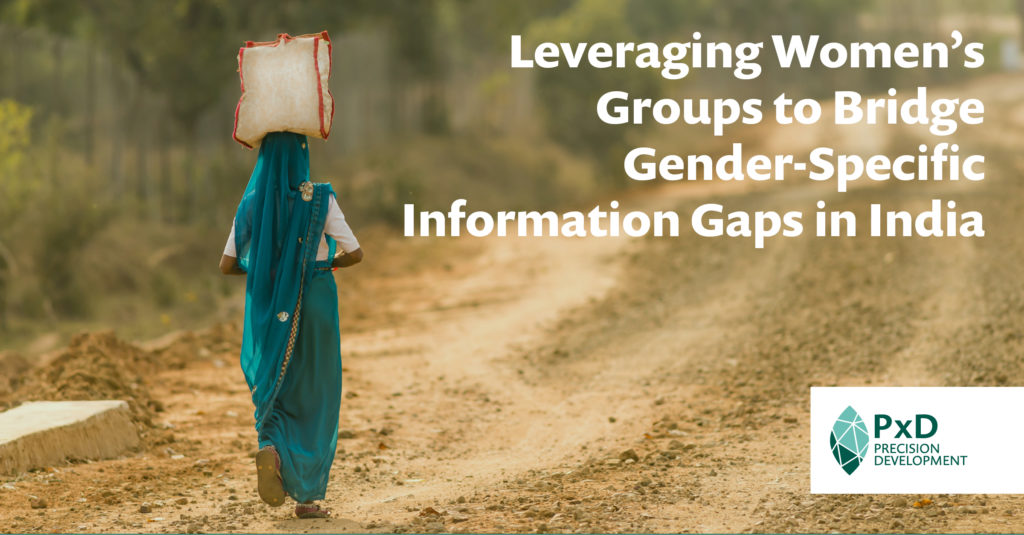
At PxD, we aim to generate research and design products and services that bridge information gaps for people living in poverty. On this International Day of Rural Women, we reflect on our efforts to understand the unique challenges confronting rural women, and how PxD’s digital services can complement the work of women’s groups to empower and serve the needs of rural women.
Gendered constraints and PxD’s existing services
How does one design products and services for women that meet their unique information needs in a scalable manner?
Cultural norms and socio-economic structures often restrict women’s autonomy, mobility, and economic opportunities. When women seek financial service, healthcare, entitlements, or other livelihood-enhancing products and services, they are likely to confront a number of constraints. In addition to the barriers associated with lower levels of literacy, digital literacy, education, autonomy, or mobility that inhibit demand and restrict women’s opportunities, many rural contexts offer a limited or nonexistent supply of products and services designed to meet women’s needs.
Unsurprisingly, women’s access to and engagement with our mobile phone-based services lags that of their male peers. We estimate that 23% of our 4.4 million current users are women. To make our existing services more accessible and relevant to women, we are iterating both the content of our advisory services and ways in which users can access them. For instance, in Odisha, we recently conducted a gender-scoping survey to more effectively understand how access, time use, and division of labor vary by gender. We found that women farmer-users, inter alia, are more likely to be engaged in livestock rearing, the cultivation of horticultural crops, and the tending of kitchen gardens. As a consequence, we now provide advisory tailored to these activities to increase women’s engagement with our services.
A more complex challenge is that women often don’t have access to mobile phones. PxD’s services generally rely on users having direct access to a mobile phone to scale the dissemination of information. Gender gaps in mobile handset ownership, and cultural norms that constrain women’s access to and use of mobile phones, complicate our ability to meet the needs of women using digital information dispensed via mobile phones. In India, for example, only 38% of women own mobile phones, compared to 71% of men (Barboni et al., 2018). This gap is likely to be even larger in rural areas. We are currently exploring whether nudging male users registered on our Ama Krushi service in Odisha to switch on their mobile phone’s speaker when they receive advisory calls to facilitate greater women’s engagement. An additional line of inquiry – about which we are particularly excited – is to interact with women users via women’s groups rather than attempting to serve individual women directly.
Women’s groups in India
In many contexts, women’s groups are a popular approach to empowering women and addressing gender gaps. While the specific structure, membership, and goals of these groups vary across contexts, they generally share the following features: (i) voluntary membership; (ii) members’ contribution of time, money, or other assets; and (iii) regular face-to-face interaction among members (Biscaye et al., 2014; Dìaz-Martin et al., 2021). Women’s groups typically aim to provide members with knowledge, training, access to financial products, or access to agricultural input and output markets to facilitate improved livelihoods, financial inclusion, better literacy, and numeracy. In all instances, greater access to information has the potential to complement and enrich these offerings.
In India in particular, policymakers and practitioners increasingly view women’s groups as effective platforms capable of scaling the delivery of a range of interventions at a relatively low cost per person (Gugerty et al., 2019). Moreover, women’s groups are perceived to effectively leverage social interactions among group members to improve the impact of each intervention. In India, women come together in women’s cooperatives, farmer producer organizations, entrepreneurial marketing organizations, women’s labor collectives, microfinance groups, and most commonly in self-help groups (SHGs). Currently, there are over 7.2 million SHGs registered with the NRLM, the largest such program in the country. Areas in which women’s groups are active in expanding access and use of services and resources include access to financial services (e.g., the National Rural Livelihoods Mission (NRLM)), community health and access (e.g., the Swayam Shikshan Prayog program), and livelihood training (e.g., the National Bank for Agricultural and Rural Development’s (NABARD) Microcredit Innovation program).
Existing evidence indicates that women’s groups have been successful in facilitating greater financial inclusion (for instance, in Hoffmann et al., 2021; Banerjee et al., 2015), and some evidence suggests that their activities have had moderate effects on small business investments and profits (such as in Banerjee et al., 2015). Certain women’s groups have also successfully improved women’s political (Prillaman, 2021), economic and social empowerment (Brody et al., 2015) while others have demonstrated no such impacts (for instance, in Joshi, Palaniswamy, and Rao, 2015; Hoffmann et al., 2021). Most relevant to our use-case, in a study of 1,000 women across five states in India, Raghunathan et al. (2019) find that the provision of agricultural extension services through self-help groups improved women’s access to information and their participation in some agricultural decision-making, but that this had limited impact on agricultural practices or outcomes.1
We are confident that women’s groups in India can be effectively leveraged in ways that enable more women to access mobile phones within their groups, and engage with mobile-based services more meaningfully, than what might be possible utilizing strategies targeting individual women users. Moreover, we believe that such groups might help women access relevant information in a friendly and supportive environment since they tend to be spaces that foster and rely on camaraderie and trust. A demonstrated strength of women’s groups in India (SHGs and otherwise) is their ability to scale and bring the benefits of scale to members at the grassroots level. This is demonstrated, for example, by efforts to federate SHGs by consolidating them across villages, blocks2, and districts under the NRLM; and through the structures of SEWA, a national federation of ‘organizations of women working in the informal economy’.
Moving forward
We see women’s groups as an opportunity for PxD to reach more women with information that has the potential to improve their lives and empower them as community leaders. Examples of initiatives we are exploring are:
- Using our existing IVR-service to connect to one phone in each group during group meetings to provide technical assistance relating to agricultural practices; to facilitate training for improved access to and meaningful use of digital services (e.g., digital finance); and/or deliver nudges and encouragement to assist women with planning and management of things like individual or household finance, educational investment, or entrepreneurship. In addition to encouraging group members to share the phone, and therefore increase the reach of PxD’s digital information delivery, we also anticipate that disseminating information in groups may facilitate “social learning” among group members; for example, early adopters of PxD’s recommended agricultural practices may encourage their peers to adopt similar approaches by demonstrating positive results.
- We also see women’s groups as being effective vehicles for facilitating the aggregation of information from markets or communities through crowdsourcing, and the potential to set up a directory or repository of agglomerated information that can be accessed across user-groups. For instance, in contexts where women have limited access to information on market conditions (such as input availability, the price of inputs and of outputs, what services are available and useful, job opportunities close to their homes, etc.), a PxD service may be effective in facilitating the sharing of leads or information within and between groups during meetings. By implication, a service or platform like this is more likely to have information relevant to the needs and interests of women.
- Finally, we also see being able to complement the existing goals of many such groups and collectives by affirming women as community leaders. Part of this may entail delivering specific digital training to women’s groups or helping women become resource persons for their local communities. This might be useful in areas such as pest identification and management, or for information about community natural resources and their management. The group structure may also assist more women to access relevant information and training than if it was limited only to women with access to phones. The perception of additional leadership credentials, or the facilitation of greater leadership agency, may accrue as a consequence of women acting as “agents” who can connect with PxD’s services and deliver information to community members who lack mobile phone access.
We are excited by the potential of these channels for improving women’s economic outcomes, increasing their bargaining power, and affirming women leaders — and facilitating leadership roles — within their communities. We are actively looking for partner organizations to work with us to iterate our ideas and bring them to fruition. We look forward to keeping you posted as we proceed!
References:
- Banerjee, Abhijit, Esther Duflo, Rachel Glennerster, and Cynthia Kinnan. 2015. “The Miracle of Microfinance? Evidence from a Randomized Evaluation.” American Economic Journal: Applied Economics. 7(1): 22–53.
- Barboni, Giorgia, Erica Field, Rohini Pande, Natalia Rigol, Simone Schaner, and Charity Troyer Moore. 2018. “A Tough Call: Understanding barriers to and impacts of women’s mobile phone adoption in India.” Evidence for Policy Design: Harvard Kennedy School.
- Biscaye, Pierre, Zoe True, Christopher Clark, Katie Panhorst Harris, Leigh Anderson, and Mary Kay Gugerty. 2014. “Self-Help Groups in Development: A Review of Evidence from South Asia AndSub-Saharan Africa.” EPAR Brief 283.
- Brody, Carinne M, Thomas De Hoop, Martina Vojtkova, Martina, Ruby Warnock, Megan Dunbar, Padmini Murthy, and Shari Dworkin. 2015. “Economic Self-Help Group Programs for Improving Women’s Empowerment: A Systematic Review.” Campbell Systematic Reviews 19.
- Dìaz-Martin, Lucia, Akshara Gopalan, Eleonora Guarnieri, and Seema Jayachandran. 2021. “Greater than the Sum of the Parts? Evidence on Mechanisms Operating in Women’s Groups.” Working Paper.
- Gugerty, Mary Kay, Pierre Biscaye, and C Leigh Anderson. 2019. “Delivering development? Evidence on self-help groups as development intermediaries in South Asia and Africa.” Development Policy Review, 37(1): 129–151.
- Hoffmann, Vivian, Vijayendra Rao, Vaishnavi Surendra, and Upamanyu Datta. “Relief from Usury: Impact of a Self-Help Group Lending Program.” Journal of Development Economics, 148: 102567.
- Joshi, Shareen, Nethra Palaniswamy, and Vijayendra Rao. 2015. “Impact Evaluation Framework and Results: Odisha Rural Livelihoods Project.” The World Bank.
- Prillaman, Soledad Artiz. 2021. “Strength in Numbers: How Women’s Groups Close India’s Political Gender Gap.” American Journal of Political Science, forthcoming.
- Raghunathan, Kalyani, Samyuktha Kannan, and Agnes R. Quisumbing. 2019. “Can women’s self-help groups improve access to information, decision-making, and agricultural practices? The Indian case.” Agricultural Economics, 50: 567–580.
1 Diaz-Martin et al., 2021 provides a comprehensive overview of the evidence.
2 In India, a block is a subsidiary administrative unit below a district.
Tarun Pokiya, Lead Agronomist, Prasanna Kumar, Senior Software Engineer, Hannah Timmis, India Research Manager, Tushar Singh, Research and Operations Associate, Srinivas VT, Senior Associate, and Revati Vaidya, Process and Product Innovation Associate, collaborated on this blog post to illustrate how a synthesis of workstreams – across agronomy, technology, research, and operations teams – inform our Ama Krushi Kharif digital advisory campaign.
From the foothills of the Himalayas in the west to Vietnam in the east, hundreds of millions of farmers’ eyes turn each June to the sky in anticipation of the monsoon. The coming of the rains marks the commencement of the Kharif planting cycle, the region’s primary growing season.
The quality of the monsoon season impacts the livelihoods of hundreds of millions of farming households, and – by extension – the caloric intake of billions of people. Kharif is disproportionately important for poor, smallholder farmers – the primary users of PxD’s services. Kharif is the season for growing rice – a critical staple and subsistence crop – and the rains benefit the land indiscriminately, whether you have resources to fund irrigation equipment and infrastructure, or not. But relying on the heavens to provide is risky: the monsoon is notoriously fickle, and unpredictable – the rains may come early, or late and progress consistently or haphazardly; climate change is shifting weather patterns and escalating the frequency and intensity of extreme weather events; and, as ever, pests and diseases lurk with unpredictable triggers.
Overview of PxD Initiatives in India – Q1 2021
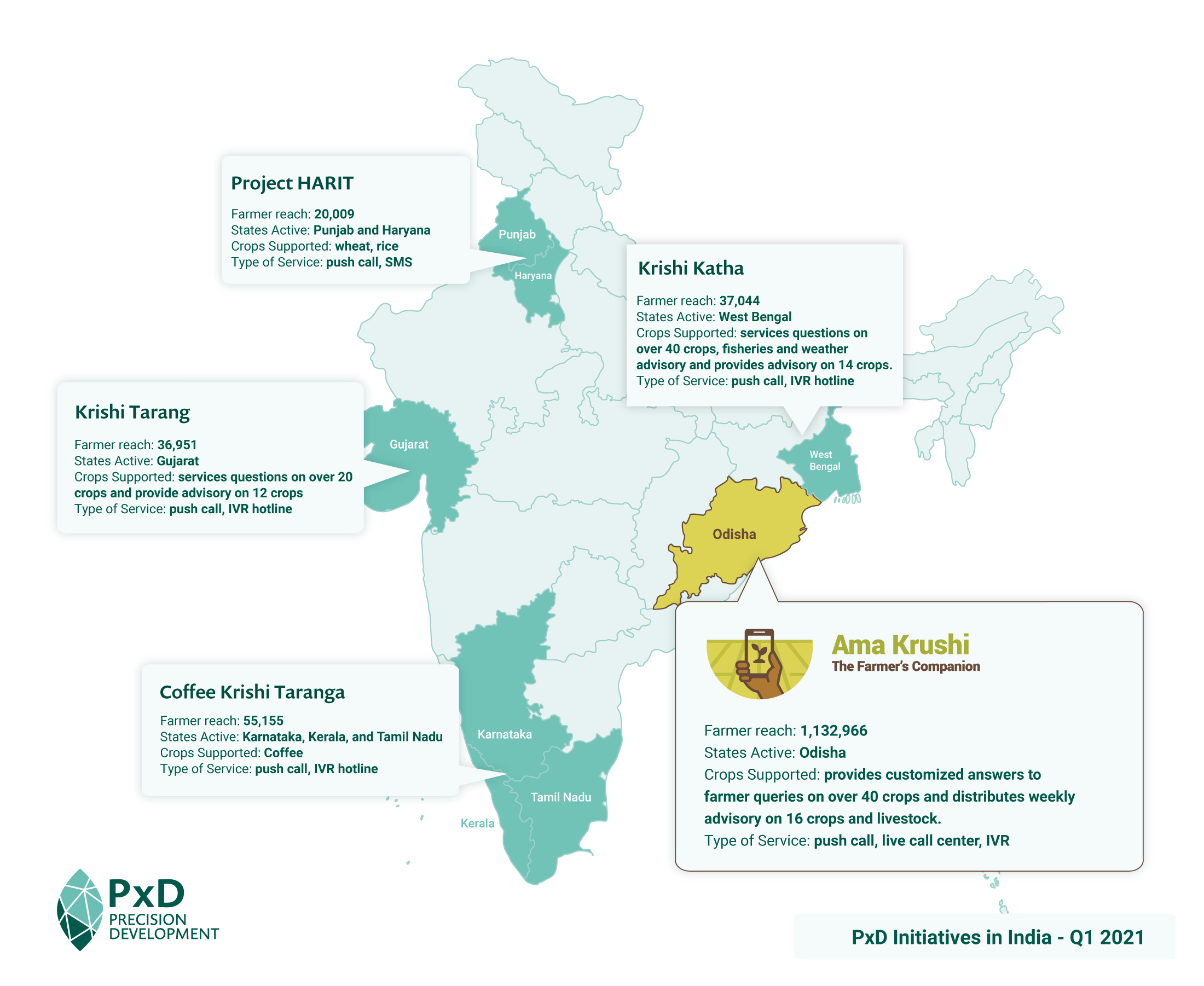
Agronomy
At PxD, the core of our work is to provide actionable information to people who need it, when they need it. All of our current services in India provide agricultural information to farmers timed to the crop cycle. Agricultural productivity can be significantly impacted by the timing and quality of critical decisions. As a consequence, the timing of information delivery is critical and is intended to maximize its value for farmers as they make key decisions and initiate activities in their fields.
In a typical year, South Asia’s monsoon season commences in the third or fourth week of June. At PxD, our teams in India have been hard at work preparing for the onset of the rains. In the second week of June, we commenced sending advisory information to over 1.4 million farmers, 1.3 of whom are served by our Ama Krushi service in Odisha. We will provide farmers with information on nineteen different crops.
In the monsoon-drenched east of the country, “paddy” (what people in the region call rice) is king, both in terms of the number of farmers who plant it and as a critical source of nourishment. In Odisha, 97 percent of farmers on the Ama Krushi service, plant rice during the Kharif season.
In the first weeks of June, our agronomy teams prepare paddy pre-planting and seed selection advisory to be sent to farmers ahead of the first rains. This information is intended to help farmers make more informed decisions and actions about purchasing inputs, the preparation of soils, and planning planting schedules. Pre-planting advisory is followed by advice on optimal planting practices, nursery management, fertilizer management, and pests and disease management.
As the Kharif growing season begins to wane in November, the team will commence pushing advice to farmers about when and how to harvesting non-paddy crops, and other post-harvest topics, such as best practices for storage and information about market prices. Rice stays in the field longer than most Kharif crops; in a typical year, the Odisha paddy harvest commences in December and can last well into January.
Tarun Pokiya, PxD India’s Lead Agronomist, explains the day-to-day work of the agronomy team and its importance:
At the peak of the Kharif season, our Ama Krushi team may broadcast up to 24 different messages in a week, depending on customization permutations. Kharif is by far and away the most important growing season for our farmers. While all farmers grow Kharif crops, only about 60 percent of Odishan farmers grow crops during Rabi, the sub-continent’s winter growing season. This is in part because most Rabi crops are irrigation-dependent, and many poor farmers have no access to irrigation infrastructure and equipment. The weather is also far more predictable. In the Rabi cropping cycle, the weather varies only a little year on year. By contrast, cyclones and other extreme events can wreak havoc on Kharif farmers, and the onset of the rains varies wildly by year and location. Kharif is a much more technical and complex planting season, and our farmers stand to gain much more from well-timed information, customized to their location and conditions.
Customization
A key advantage of digital extension is the ability to customize content to make it more relevant to individual farmer’s conditions, choices, and needs.
In Odisha, farmer users of the Ama Krushi service receive information customized according to the following dimensions:
- Location (by district) – the onset of monsoon can be very different in the west compared to the coastal belt, and crop calendars are customized accordingly; customization is also calibrated according to current weather conditions throughout the growing season.
- Dialect preference – Sambalpuri and Oriya
- Crops planted – paddy, blackgram, greengram, cotton, bitter gourd, bottle gourd, cabbage, cauliflower, groundnut, maize, pointed gourd, redgram, ridge gourd, brinjal, tomato, okra, and sugarcane.
- Paddy farmers receive further customization based on the type of land they work – low, medium or upland – which significantly impacts seed choice and growing conditions
- Irrigation status – has irrigation/does not have
Content preparation and process
PxD’s team of eight agronomists, one livelihood expert, and one fisheries expert, engages in systematic preparation ahead of each planting season. Given Kharif’s disproportionate importance, and the complexity of interwoven and potentially countervailing factors, the teams commence planning months in advance of the first message being sent to farmers.
- Our agronomists initially engage in an overall season scoping activity: prioritizing crops, laying out provisional timing for advisory content based on crop cycles, etc.
- Following the initial process, the teams prepare formal crop calendars for each crop supported. They layout parameters for the commencement and conclusion of cropping cycles, identify and prioritize topics and critical behaviors for promotion, etc.
- Thereafter agronomists are assigned crops and topics and begin drafting advisory content focussing on a package of practices for each crop.
- The team then assigns weekly advisory topics for drafting – agronomists prepare draft scripts in English based on the crop calendar and plan.
- The draft advisory is then submitted to a content review committee (local experts and officials) for approval.
- Following approval of the script in English, it is translated into the local dialect.
- Priority messages are field-tested to improve relevance and impact (see the section below)
- Voice messages are then recorded. A senior agronomist will then check the recording to ensure that the quality of the audio and translation is sufficient for broadcast.
- Messages are checked one last time by the Content team lead before they are uploaded to the system for broadcast.
Steps 4 through 8 are conducted on a rolling basis, whereby the content for the second week of June is prepared in the first week of June; for the third week in the second etc. This allows us to adjust the cycle of content as the weather shifts, and accommodate urgent advisory messages, for example in response to extreme weather events, or pest infestations.
Our teams are in constant communication via WhatsApp and a rotation of organizational meetings. We have to keep a constant eye on the weather and other conditions.
Cyclone advisory to farmers in Odisha ahead of Cyclone Amphan (May 2020)
Namaskar. Welcome to Ama Krushi, the free Agriculture Information Service of the Department of Agriculture, Government of Odisha. Some specific information for the farmer: Most of Odisha is likely to receive light to moderate rainfall over the next 24 hours due to the cyclone system and the resulting low pressure in the southeast of the Bay of Bengal and along the Andaman coast. This system is likely to gradually condense and take the form of cyclone. As a result, coastal districts are likely to receive moderate to heavy rains and strong winds. Following the rain, remove all excess water from your fields: paddy [rice], sesamum, jute, brinjal, chili, okra, gourds, and flowering crops. Cut paddy seedlings that are ready to be harvested and store them in a safe place. In your vegetable fields following the rain, stop any irrigation and refrain from applying insecticides. If mango, banana, and papaya are ripe, harvest them before the wind blows them from your trees. If cashew nuts ready for harvesting, pick the nuts and let them dry. Put in storage sufficient dry food and water for your livestock. Please contact Ama Krushi’s free hotline 155 333 for more information. Thank You.
Prasanna Kumar, PxD’s Senior Software Engineer, explains how we program calls and push calls through Paddy, our in-house technology stack (not the crop!).
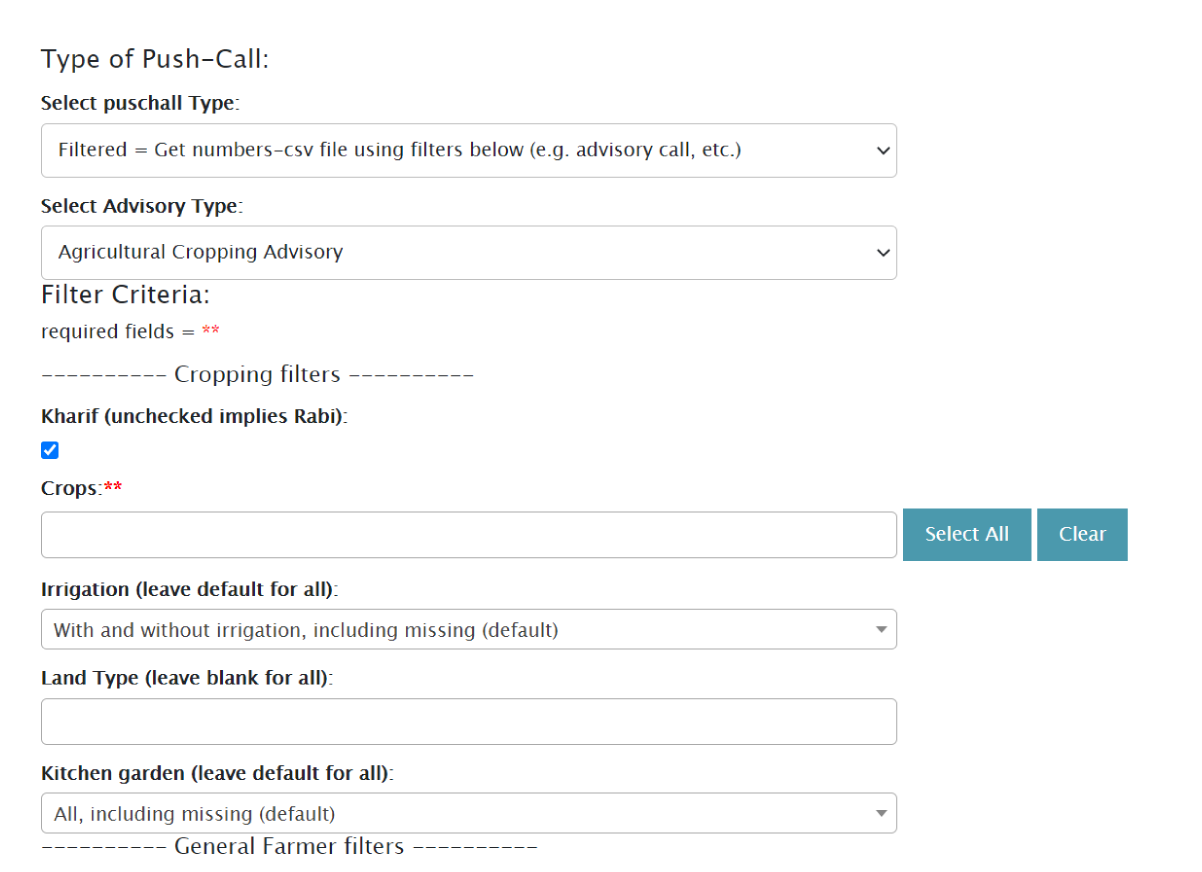
Our tech platform – Paddy – incorporates a high degree of automation and can run on a variety of backends, such as SMS platforms, IVR platforms, or chatbots on WhatsApp or Telegram. Our Ama Krushi, kharif platform is a Push Call platform.
Scheduling push calls can be complex in a project of the scale of Ama Krushi. As detailed above, our agronomist team sends out crop-specific, season-specific, and livestock-specific messages to farmers. To maximize their relevance to farmers’ needs, messages must take into consideration a farmers’ geography (district), topology (high land, low-lying land), the availability of irrigation, and – in some cases – the gender of the farmer receiving information.
To make the job easier for agronomists, we provide a Graphical User Interface (GUI) to schedule push calls. The GUI allows agronomists to apply filtering criteria (such as crops, season, irrigation, gender, district, etc.) which are then applied to each message. The message is then programmed to correspond to all the corresponding profiles in the database and returns only those profiles that satisfy all the filters.
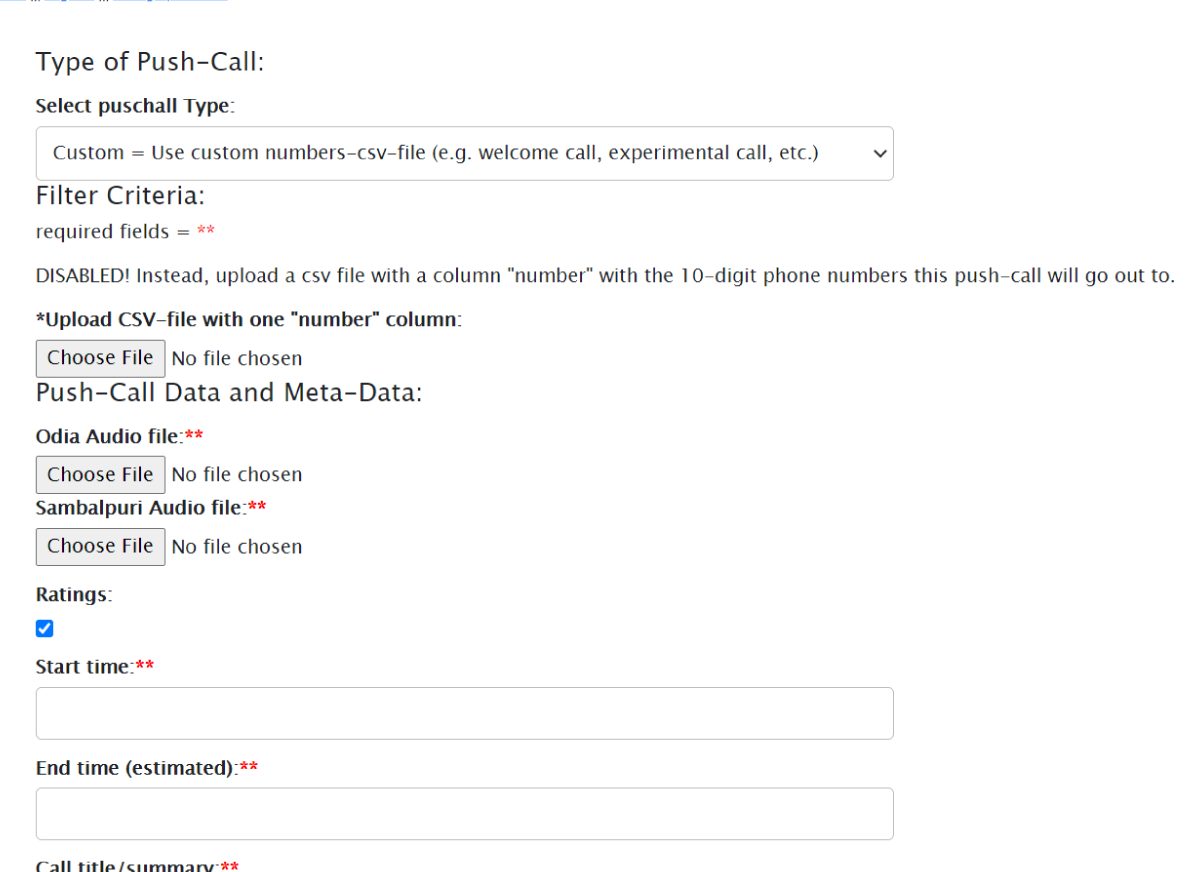
Our Graphical User Interface is designed to make it easy for our agronomists to apply filters and program calls
The agronomist then uploads the message audio to be sent. Our platform supports sending messages in different languages to farmers based on their stated language preferences. Hence, audio files for all supported languages have to be uploaded. Paddy (our backend system) then automatically assigns the language preference for a farmer from his profile and schedules the correct audio. The agronomist then picks the date and time at which the scheduled messages will start getting pushed. This completes the scheduling process.
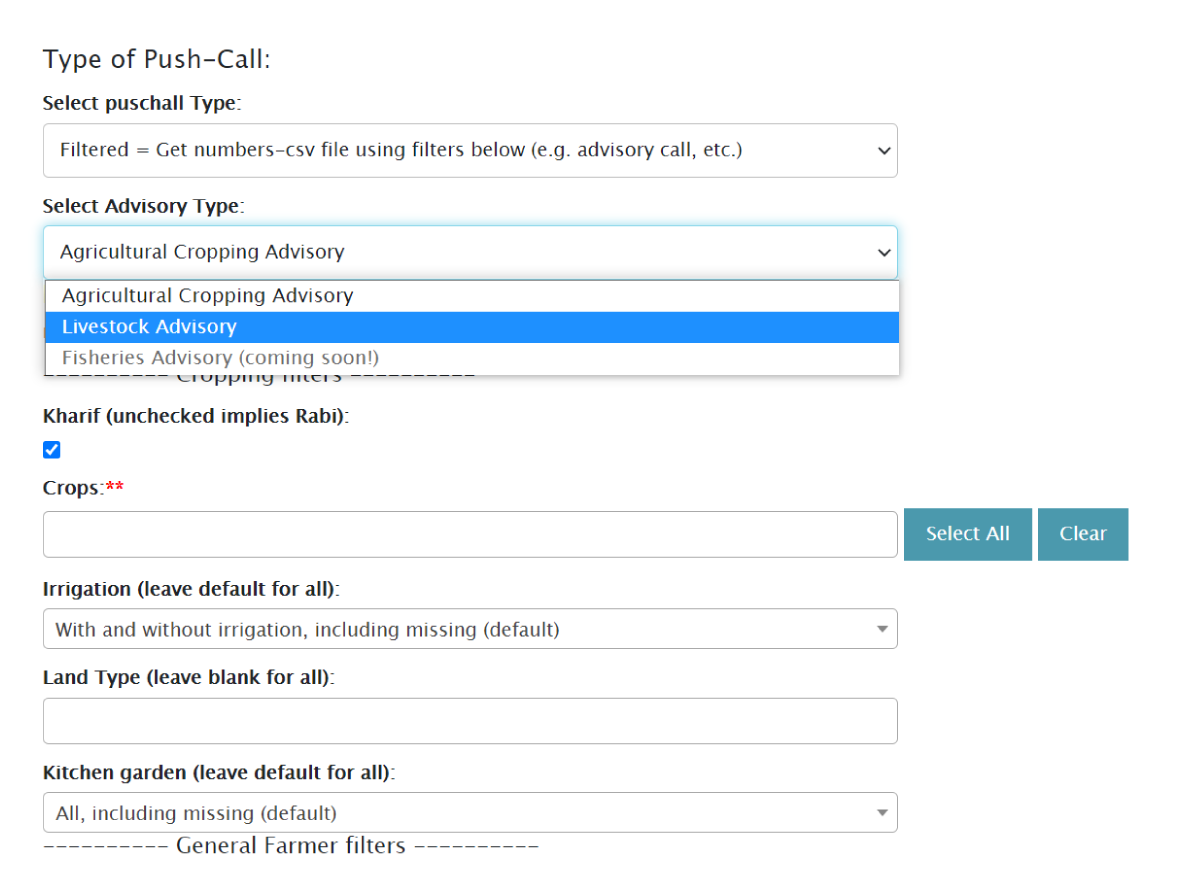
Our Ama Krushi push call service sends advisory on multiple topics, including cropping cycles, and livestock husbandry. We will be incorporating fisheries advisory shortly.
Our scheduling interface also allows for special cases. Here I will mention two:
Firstly, we need to schedule calls for farmers who may not have been fully profiled yet and for whom we have insufficient information in the database. The system allows for the uploading of phone numbers in comma-separated values (csv) format and then schedules messages to all the numbers in the list. Since these numbers are potentially un-profiled, no filters can be applied to them and a default language is assumed for all farmers (Odia in the case of Ama Krushi).
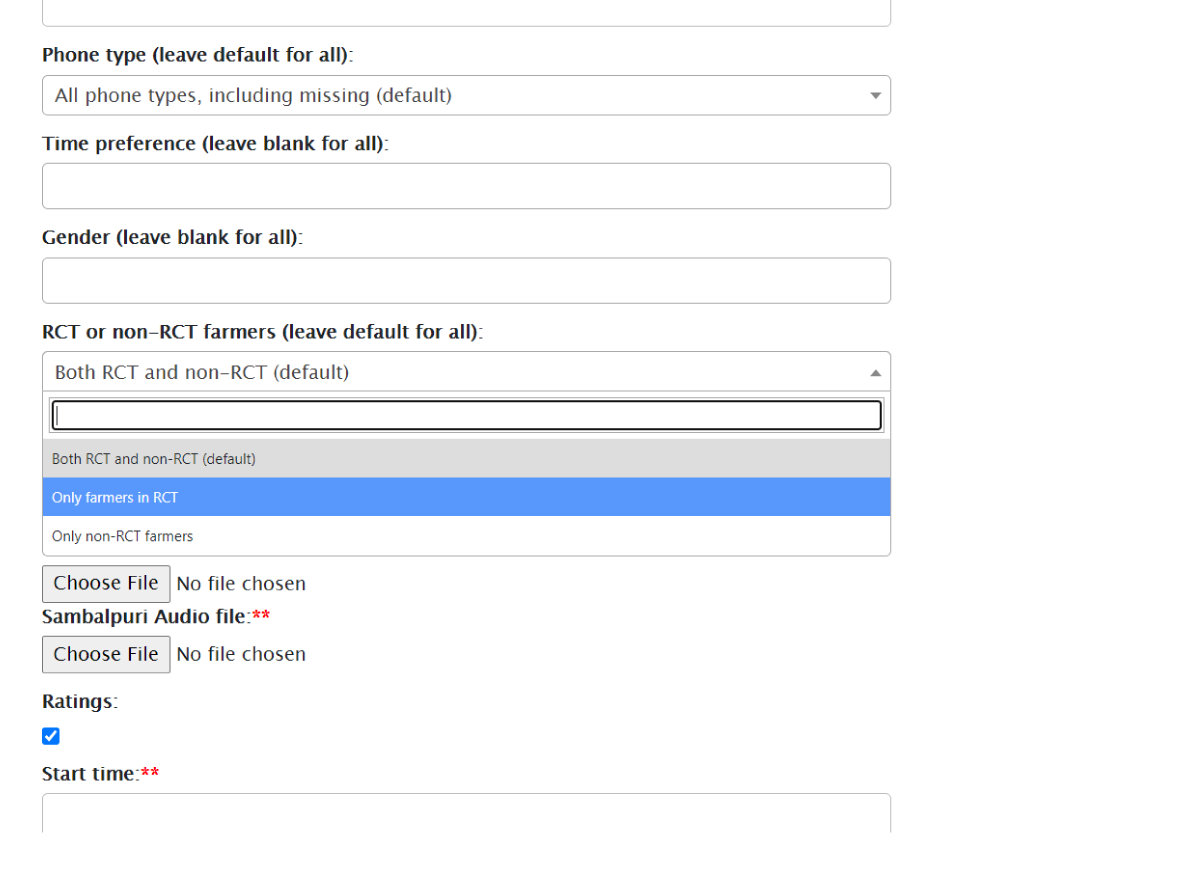
Paddy is designed to support and facilitate our research work. A/B testing. RCTs and other research experimentation can be facilitated, and filtered within the platform.
Secondly, to support A/B testing we provide a filter that ensures that farmers who are marked as “Control” or “Test” farmers do not receive the calls. Under special circumstances we allow this to be over-ridden and the same message will then be sent to all farmers (for example if we are warning farmers about an impending natural disaster, or COVID-related messages).
Hannah Timmis, PxD’s India Research Manager, and Tushar Singh, Research and Operations Associate, explain how we use field testing to drive product development, innovation and improved service delivery:
From resource constraints to limited access to capital and agricultural inputs, small-scale farmers in Odisha confront uniquely challenging barriers that limit their ability to close the yield gap. In this context, the objective of providing locally relevant and actionable information, customized to a farmer’s specific needs, is by no means simple.
To promote efficiency and the relevance of our content, we are piloting a two-step process for content design. This process aims to identify a long list of recommendations with the potential for high impacts on productivity and yields and frame these recommendations as messages that can be easily understood and acted on when they are communicated to farmers.
Step 1: Improve Content Prioritisation & Scheduling
Initially, while designing advisory content for the season, we identify and focus on farming practices that are low cost, low risk, and are evidenced to increase yield for small-scale farmers. We gather information from agricultural experts, our agronomist colleagues, and complementary literature, about the importance of key practices, expected yield increase, and information about complementarities across practices. To understand better what set of behavior changes and practices we can meaningfully influence, we use farmer data to estimate baseline adoption of targeted agricultural practices, farmers’ knowledge of these practices, perceptions of costs and actual costs.
For more complex farming practices, we collect more detailed data and insights to fill potential blind spots about farmer practices and perceptions, generate new, or different, hypotheses, and identify potential constraints to adoption. We also collect information to estimate the lead time farmers require to adopt new or amended practices. We ask farmers when they make their most relevant decisions and critical investments, and assess the extent to which changing behaviors would incur a time cost (e.g. travel time, procurement time, etc.).
Step 2: Improve Content Communication
When an advisory message is too long or too detailed, farmers may not have the time or bandwidth to process all the information. Delivering a compelling message helps to grab and maintain the attention of farmers, and helps to ensure that farmers connect with and internalize the information conveyed. Once we have identified priority content that can help farmers stabilize, or increase their production, we draft outbound messages using a message development template to increase the consistency and clarity of the framing. This template is one of the tools that help our team think about message design in a more structured way:
| # | Message Component | Maximum Length | Rubric | Notes |
|---|---|---|---|---|
| 1 | Welcome | sentence | Who is this message from? | Greeting and clearly identifying the sender of the call. E.g. “Namaskar, welcome to ‘Ama Krushi’, the Government of Odisha’s free agriculture information service.” |
| 2 | Topic | 1-2 sentences | What is this message about? | State advisory topic and briefly state concrete recommendation. E.g. “Today, we would like to tell you about an important practice called “seed treatment”, which means mixing your seeds with fungicide before planting. It is an essential precautionary measure to manage pests and diseases in crops. ” |
| 3 | Recommendation (Less technical) | 1-2 sentences | How should I act in response to this message? | A clear and if possible non-technical statement of the key recommendation. Ideally, there should be one recommendation per message. E.g. “In today’s advice, we recommend using either Carbendazim or Carboxin + Thiram to treat seeds before sowing. These seed treatment products are low-cost and widely available. ” |
| 4 | Rationale | Max. 3 sentences | Why should I change what I’m doing? | A brief explanation of the rationale behind the recommendation. E.g. “They protect crops from seed and soil-borne diseases and also help to produce healthy seedlings.” |
| 5 | Recommendation (More technical) | Max. 3 sentences | How should I act in response to this message? | A clear and more detailed technical statement of the key recommendation. E.g. “Seed treatment can be done in many ways, but here we will suggest two. You can use one or another. The first way is by mixing 2 grams of Carbendazim, also sold as Bavistin or Dhanustin, in every kilogram of seeds. The second way is by mixing 3 grams of Carboxin + Thiram, also sold as Vitavax power or Vaccinator power, in every kilogram of seeds.” |
| 8 | Thanks & followup | Max. 1 sentence | How to follow up for more information? | “Thank you, and remember that if you have questions about this advisory or need more information, you can call the Ama Krushi hotline on 155333” |
The template is intended to help us condense our main recommendations, emphasize their most essential components, and cohere message design.
If, for example, we find that farmers misperceive the efficacy or cost of a practice, we can emphasize the yield benefits and resource requirements in the recommendation rationale. When baseline knowledge and adoption are low, or the advice includes complex terms, we may determine that recommendations require additional reinforcement. In such cases, we can develop nudges and reminder messages focusing on critical aspects of the recommendation.
Lastly, the template helps us to document the evidence we use to generate our advice, thus improving the “evidence-based” nature of the content we develop. In addition to using the message template, we leverage behavioral insights and use framing tips and techniques to deliver the value proposition optimally. To ensure there are no discrepancies between the English and Odia versions of the message, another Odia-speaking member of the team will review translations and audio recordings before the dissemination of the message.
In the final section of this blog post, Srinivas VT, Research and Operations Associate, and Revati Vaidya, Process and Product Innovation Associate, provide an overview of our recently developed dashboard which allows for more effective and precise monitoring of program performance.
The objective of our dashboard is to provide a real-time view of program performance through Key Performance Indicators (KPIs) that:
- Minimize the need for longer data extraction processes;
- Allow us to quickly view the health of the program and identify issues via available trendlines; and
- Provide visual representation of data to put things in perspective.
Before we developed the dashboard, we needed to run long queries on pgAdmin to extract metrics. Now, we can select our parameters, press “compute”, and the dashboard pulls from the backend data tables which give us the metrics we need in an easy-to-read format. These dashboards have been developed using an R-shiny web application.
The Odisha dashboard is split into six operational sections. Data in each section can be filtered according to time and other parameters relevant to the section. For farmer data, for example, this includes demographic filtering (gender, district, smartphone ownership, etc.).
- Call Activity: Provides a quick view of the number of outbound calls that have gone out recently to farmers.
- Helpdesk: Contains the complete list of the questions that farmers have asked via the hotline. Recordings of the question/responses are embedded into the helpdesk tab so that we can listen to the recordings by pressing a play button.
- Profiles: Overview of Ama Krushi farmers, total registered, their demographic distribution, etc.
- Call Centre: Details on Call Centre productivity that include profiling rate, conversion rates, hourly productivity, etc.
- QnA Backchecks: A tab where the team can generate and listen to a random sample of Farmer Questions and Answers provided by the content team for quality checks (i.e to ensure proper tagging has been done, no valid calls have been rejected, etc.)
- Usage Data: This section is where ‘the meat’ of data on farmer engagement lies. This is, in turn, bucketed into three sub-sections:
- Outgoing: This sub-section allows us to look at farmer engagement with our outbound calls – primarily how many farmers pick up our calls, how long they listen, etc. The screenshot below, depicts metrics for outgoing calls over the last six months:
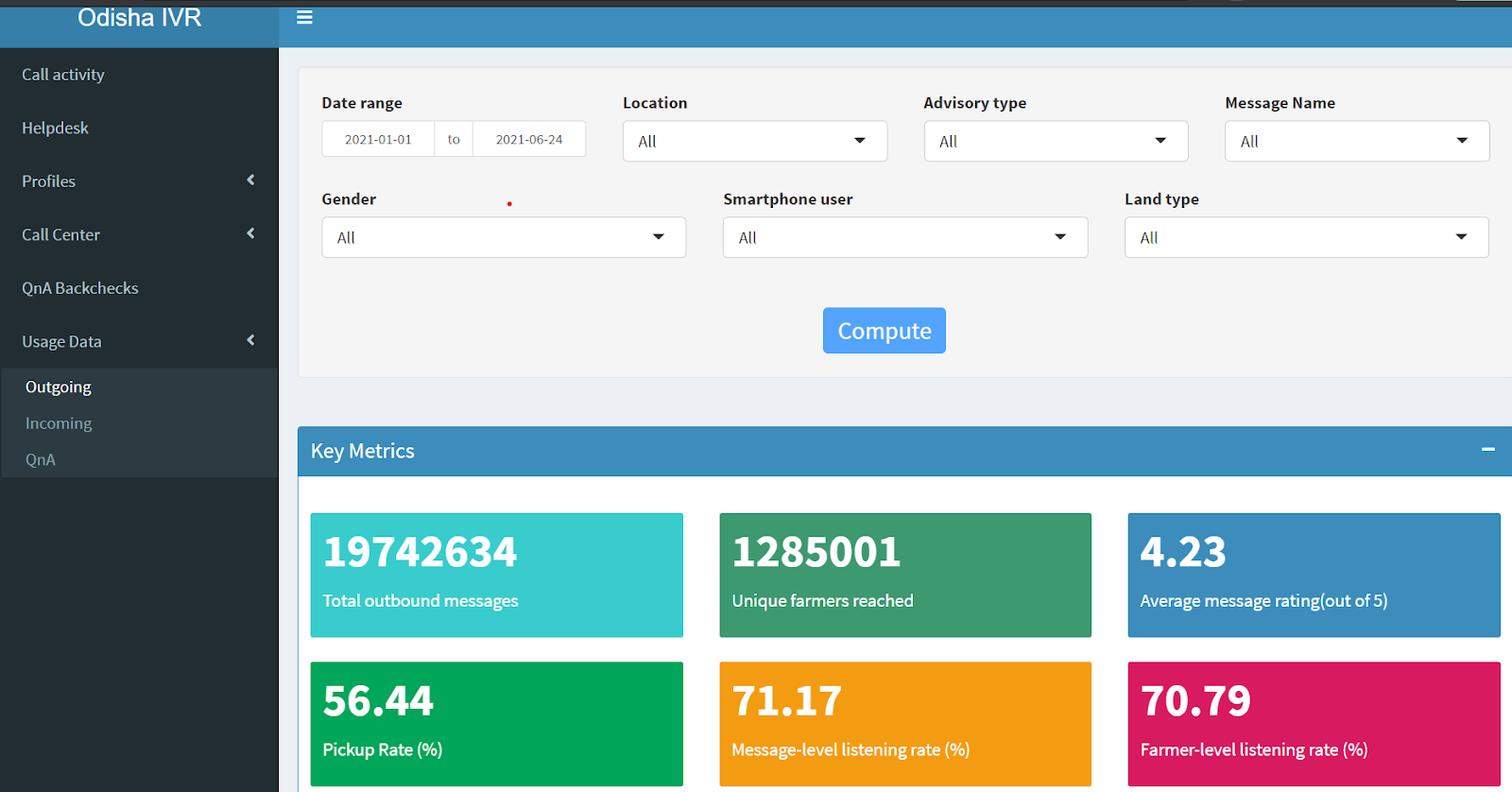
- Incoming: The sub-section provides us with details on (i) inbound engagement (how many farmers are calling in, how many of them are registered, how long they spend on the call, etc.) and (ii) what farmers do when they call in – i.e what part of the menu they go to. The screenshot below depicts inbound metrics for non-smartphone owning women farmers over the last six months:
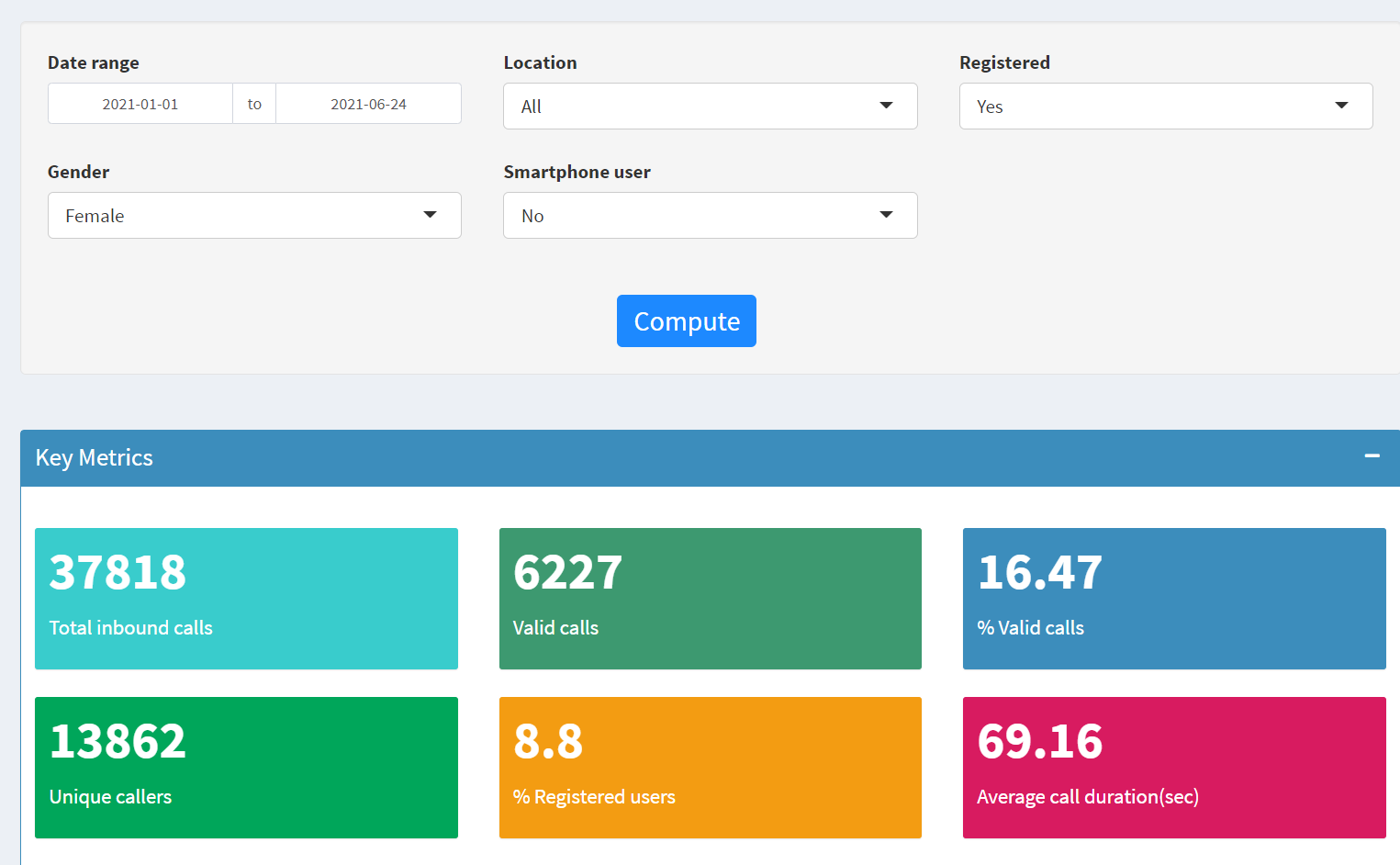
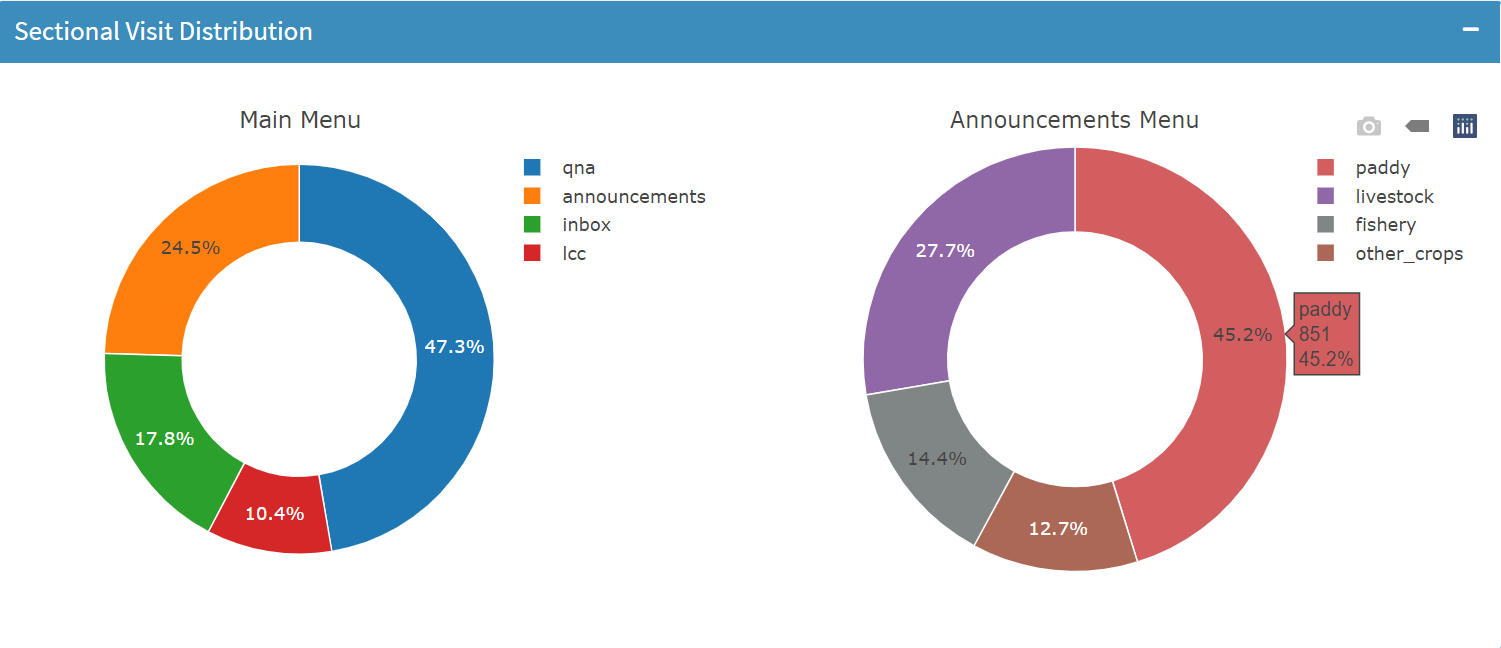
- Q&A: This sub-section specifically focuses on farmer questions allowing us to see:
- Key metrics looking at basic numbers (how many we are receiving, how many and how quickly we are responding to them); and
- Details on the types of questions (determined by how they are tagged).
The screenshot below presents data on farmers that have asked questions relating to crop-based advisory over the last six months:
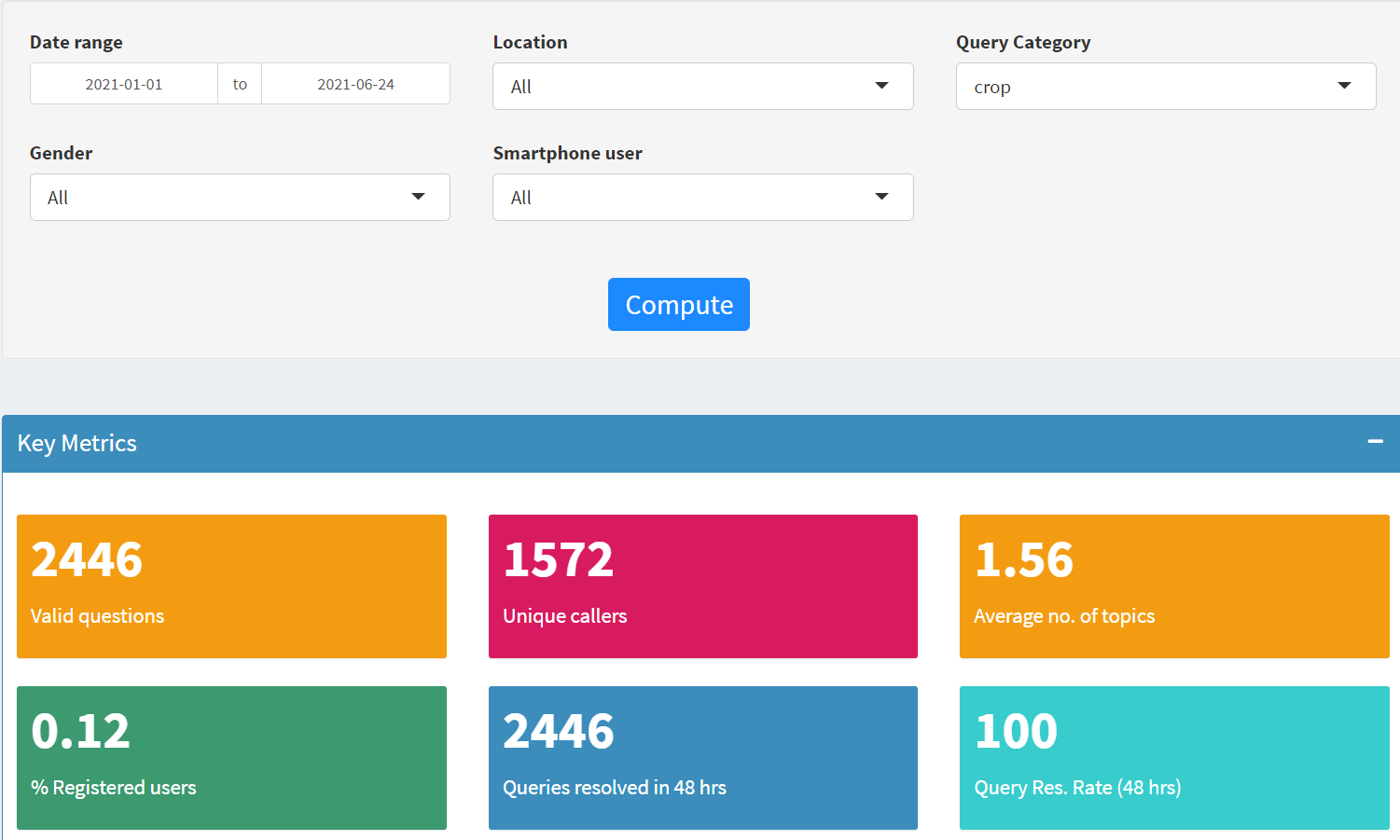
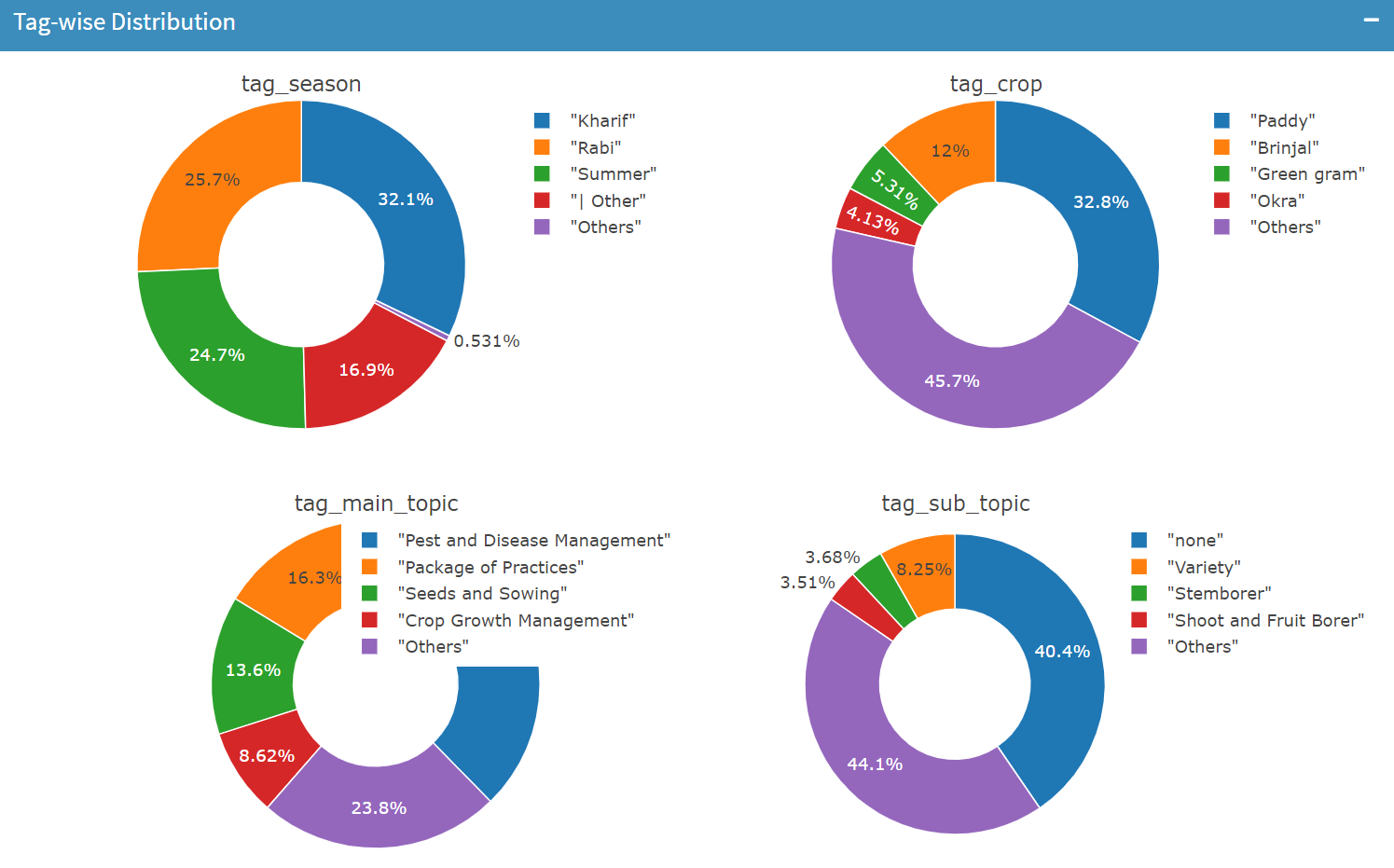
All backend data has now been linked to our Odisha dashboard (a West Bengal dashboard is also up and running and undergoing further development!). As more teams begin using the dashboards regularly, we want to make sure that the experience is as seamless as possible. We plan additional UI/UX improvements in the coming weeks to optimize user experience and ensure the dashboard is doing what it is designed to do – giving us the data we need with ease, speed, and accuracy (and some fun aesthetic!). We eventually want to replicate the improved template across all project locations to create a centralized PxD`India dashboard.
As our teams and farmers navigate July’s unpredictable weather, the workstreams above are complemented by – and work in concert with – carefully calibrated and informed actions on the part of colleagues at our (remote) call centers, our government partners, and traditional extension agents. We hope that the synthesis of our activities and actions will support our farmers to make more informed and more productive decisions as they navigate a fruitful and bountiful Kharif season.
For more information about our work, or to explore potential partnerships, contact communications@precisionag.org
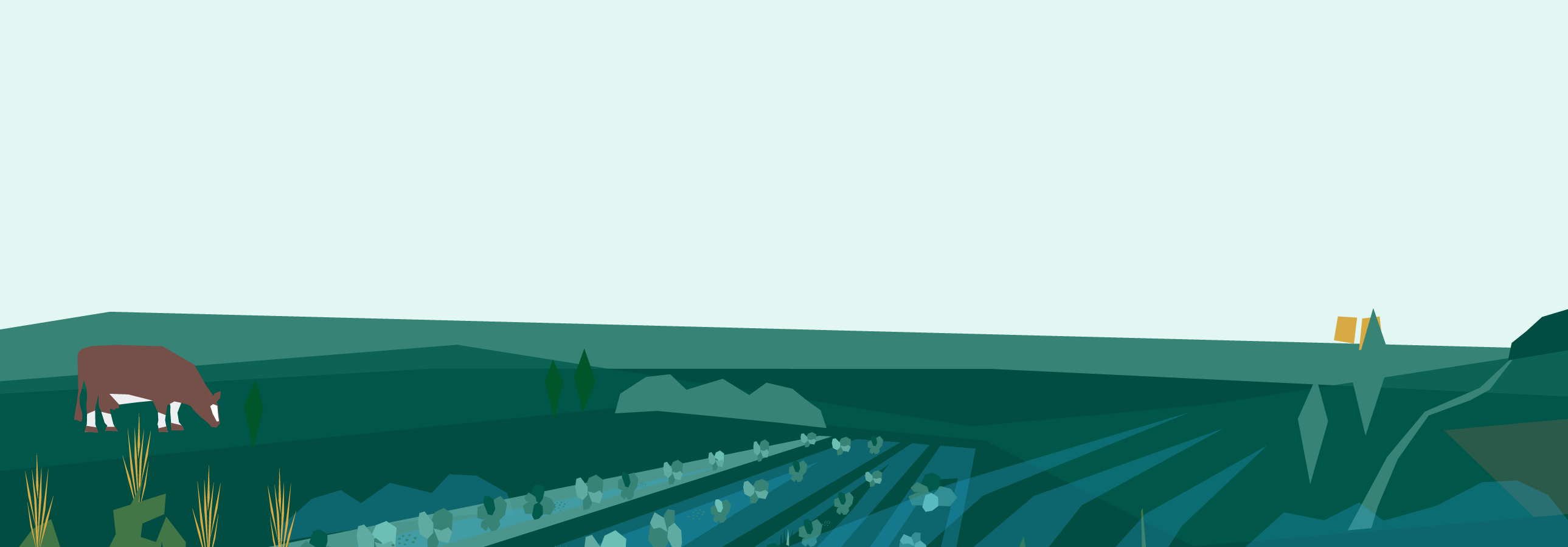
Sam Carter, Revati Vaidya, Simon Rubangakene, Georges Poquillon and Habtamu Yesiget recount how we improved our content and services by learning about our end-users response to messages recorded with men’s voices and women’s voices.
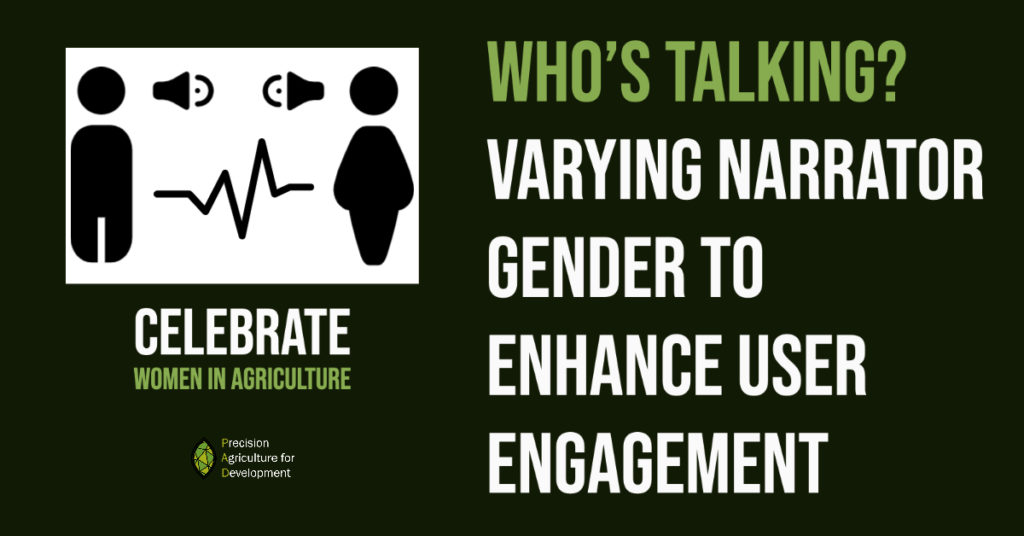
Do farmers act differently when they hear a woman’s voice giving them agricultural advice? How much does this matter in the nine different countries where we operate? These are questions we often ask ourselves since interactive Voice Response (IVR) and push calls are the bread and butter of our outreach to smallholder farmers.
Rigorous research is in our DNA, since PAD was born out of a study proving that mobile-phones can cheaply deliver actionable agricultural advice to farmers. We routinely test and evaluate different versions of our service to identify the best way to engage farmers with our services and, ultimately, turn our advice into action. We’ve tested the length of voice calls, the order in which menu options are presented, and use of urgent language in our messages among many others.
In Uganda, Ethiopia, and India, PAD has conducted A/B tests to understand whether the gender of the person narrating the advisory content has an impact on farmers’ pick-up and listening rates. In Uganda, we found that switching from a male to female narrator increased farmers’ engagement with PAD content, and as a result, we will use a female narrator for all new content developed for that program. In Ethiopia, on the other hand, we found that both pick-up and listening rates were higher when content was voiced by a male narrator than a female narrator. Meanwhile, in the Indian state of Gujarat, we found no statistically significant difference in engagement rates based on the gender of the narrator. Taken together, these results suggest the need for a nuanced, contextually-grounded approach to understanding the role that the narrator’s voice plays in determining farmers’ engagement with our service.
This blog post presents a summary of each experiment design and its results, and teases out the implications of these results in time and place:
Uganda
Simon Rubangakene, Project Associate and Georges Poquillon, Senior Research and Operations Manager
PAD’s service in Uganda
In Uganda PAD delivers digital training to smallholder farmers as part of an initiative run by Uganda Coffee Agronomy Training (UCAT) – a program implemented by the non-profit organizations Hanns R. Neumann Stiftung and TechnoServe – which delivers training to approximately 60,000 farmers in western Uganda via Farmer Field Schools. UCAT aims to train farmers to implement Good Agronomy Practices (GAPs) to increase yields and – by association – livelihoods.
PAD provides digital training to 4,000 UCAT farmers who are participating in a randomized evaluation in which farmers receive standalone and reinforcement training. The evaluation intends to understand the impact of varied approaches to agronomy training and/or extension services.
PAD’s digital advisory is pushed to farmers’ mobile phones in four different languages (English, Luganda, Runyankole and Rutooro). Standalone farmers who are not part of the UCAT program are also able to call in and record questions, which are answered by an agronomist within 48 hours. Standalone farmers and those attending training run by Hanns R. Neumann Stiftung receive IVR calls on a weekly basis, whereas farmers attending training run by TechnoServe receive advisory messages once a month.
How the A/B test varied the gender of the narrator, and why we decided to test this question
Prior to this A/B test, PAD’s advisory service in Uganda included content delivered by both male and female narrators. Due to the way in which language-use was distributed, few farmers receiving advisory from PAD were receiving advice voiced by a female narrator which made it difficult to identify listening patterns linked to voice. The Uganda team decided to implement an A/B test to better understand how farmers’ listening rates varied based on the voice of the narrator.
The study ran for eight weeks, from October 14, 2020 to December 9, 2020, a time coinciding with the runup to, and active period of the coffee harvest in Uganda. For this A/B test, we randomly assigned the 4,009 UCAT farmers receiving advisory from PAD to one of two groups. Group 1 (2,004 farmers) received content voiced by a narrator whose gender did not match their own. Group 2 (2,005 farmers) received content voiced by a narrator of the same gender. We stratified the sample to ensure that both groups were balanced in terms of language and the organization implementing the in-person training.
Results of this A/B test
Switching the message content from being voiced by a man to being voiced by a woman positively and sustainably increased the probability that female farmers picked up IVR calls, while there was no effect on the likelihood of a male farmer taking a call. With regard to the propensity to listen to most of the IVR call content, switching from a female to a male narrator reduced the listening rate of male farmers, while the opposite held true when switching from a male to a female narrator. However, the effect on the male completion rate was found to be lower over time. In the case of female farmers, switching from a male to a female narrator increased the likelihood that they listened to most of the message, with more long-lasting effects.
The findings suggest that both male and female UCAT farmers are more sensitive to messages voiced by a female narrator. However, the short-term nature of some effects may prevent such a change from generating long-run changes in farmers’ engagement. Moreover, only two narrators of each gender were involved in the recording, so we cannot rule out the possibility that we are capturing a “narrator” effect rather than a gender effect.
Implications for programming and future research
A direct consequence of the findings of this study is that the new UCAT content will be entirely voiced by female narrators. Farmer engagement following the introduction of this new content will be monitored to assess whether any change arises, leading to improved listening and completion rates.
Ethiopia
Habtamu Yesigat, Director of Programs, Ethiopia
PAD’s service in Ethiopia
PAD has collaborated with the Ethiopian Agricultural Transformation Agency (ATA) since 2017 to measure and improve the effectiveness of ATA’s 8028 farmers’ hotline service. The 8028 farmers’ hotline, introduced in 2014, is an IVR service available in five languages which has reached more than 5.4 million farmers. A farmer can call into 8028 – free of charge – and navigate through different menus to reach advisory content on 21 crops and four livestock commodities.
How the A/B test varied the gender of the narrator, and why we decided to test this question
Historically, the 8028 farmers’ hotline content has been narrated by a female journalist. In an international benchmarking study that PAD carried out in 2018, we realized that inbound systems in other settings had tested a variety of techniques to attract more farmers to call in and to encourage users to listen longer. Varying the narrator of the agricultural content (for example, varying the gender of the narrator, varying whether the narrator is a journalist or a subject matter expert, or using the voices of celebrities, agriculture leads, and scientists) is among these strategies.
The evaluation covered 462,000 farmers enrolled on the 8028 farmers’ hotline service and ran during Ethiopia’s primary rainy season in 2019 (June through August). Farmers who participated in the study were growing a variety of crops including wheat, maize, malt barley, sesame, and teff. At the beginning of the study, each farmer was randomly allocated to one of the three treatment arms, and received a series of push calls throughout the season to provide relevant to the farmer’s crop and location.
The three treatment arms were: female journalist narrator, male journalist narrator, and a male agronomist narrator. The study assessed whether there was a difference in the average time a caller spent listening to the service when we changed the gender and profile of the narrator. However, because there was no treatment arm with a female agronomist narrator, we were not able to fully understand the interactions between the perceived gender and expertise of the narrator.
Results of this A/B test
Both the pick-up rate (proportion of farmers who picked up the phone) and listening rate (proportion of the call duration to the total length of the content) were higher for the male journalist narrator and the male agronomist. We saw no significant difference in pick-up or listening rates when comparing between the male journalist and the male agronomist.
| Female journalist | Male journalist | Male agronomist | |
| Pick up % | 33.9% | 34.3% | 34.5% |
| Listening % | 87.4% | 92.3% | 92.2% |
With this evidence, and acknowledging the fact that we didn’t have a female agronomist voice as a treatment arm, we can only speculate as to the mechanisms driving the higher engagement rates for male voices. There is a socio-cultural association between agriculture and men which may contribute to the difference. In addition, we did not include a treatment arm featuring a female agronomist; it may be the case that farmers were more interested in listening to an agricultural expert rather than a female journalist, but that they would have been equally receptive to a female agronomist.
Implications for programming and future research
This evaluation has helped us to think about the multiple factors that must be considered when evaluating a change to the narrator’s voice. When we next implement an outbound call service in Ethiopia (which we will likely do in the next few months), we plan to repeat this experiment with the additional confounding factors in mind.
Gujarat, India
Revati Vaidya, Process and Product Innovation Associate
PAD’s service in Gujarat, India
The Indian state of Gujarat is home to PAD’s oldest program, which began operating in 2016. The service, called Krishi Tarang ( “agriculture wave” or “vibe” in Gujarati and Hindi) currently serves over 36,000 farmers. Krishi Tarang provides farmers with free, customized information in two ways: i) weekly voice messages are pushed to enrolled farmer’s mobile phones (“outbound” service), and ii) farmers have the ability to call into an IVR hotline to record a question and access other information (the “inbound” service). Messages recorded by farmers via the hotline are answered by agronomists via push call within 48 hours. Traditionally, calls from Krishi Tarang have been narrated by a male voice.
How the A/B test varied the gender of the narrator, and why we decided to test this question
At the beginning of the 2016 Kharif season, PAD implemented an evaluation to test four different narrator voices to see how they impacted farmers’ listening rates. Approximately 3,000 farmers, who were registered as Krishi Tarang users at the time, were each assigned to receive calls from one of four different narrators: a male agronomist (who identified himself as an agronomist during the recording), a farmer (generally male, who identified himself as a farmer during the recording), male voice (no occupational emphasis), or a female voice (no occupational emphasis).
This A/B test took place over four weeks during Kharif, from the end of May to the 21st of June, 2016.
Results of this A/B test
No statistically significant differences were observed among the listening rates across the four groups (i.e four voices). No one voice emerged as the best choice.
Implications for programming and future research
Given that there were no statistically significant differences in listening rates observable across the four voices, no changes were made to the service.
Quo Vadis?
To recap: in Uganda, switching from a male narrator to a female narrator led to higher engagement, while in Ethiopia, the opposite was true. In Gujarat, there were no significant differences based on either the gender or the stated expertise of the narrator.
From a social science perspective, these results underline the extent to which gender is a social construct bound by time and place. Gender dynamics are highly context-specific, and findings cannot easily be generalized from one setting to another. The association between a narrator’s gender and their perceived expertise is just one of many important questions that we, as researchers, must try to understand before drawing firm conclusions about the role of the narrator’s gender on listening rates within a given population. At a more general level, these diverging results reinforce the importance of local learning and local knowledge, and the importance of customizing our services and information in situationally-appropriate ways (see for example our recent blog post on more intentionally understanding the needs of female farmers in the Kenyan dairy sector).
From an implementation perspective, these results demonstrate the value of collecting data on the gender of PAD users to improve both individual customization and overall program design. However, collecting detailed information on user characteristics involves important tradeoffs: We need to ask more questions of farmers to deliver personally-tailored services, yet asking too many questions will lead some farmers to drop off. Other farmers may balk at perceived privacy implications. Moreover – as detailed in another recent blog post – in smallholder households, mobile handsets are often shared among adults, so we are not always sure whether the person answering the phone is the person whom we have profiled.
As PAD continues to emphasize gender in our research and program implementation, we anticipate wrestling with difficult questions. For example, what if we find that behavior change is more likely to occur when our content is delivered in a way that reinforces patriarchy or other existing social prejudices (e.g., a narrator whose accent is associated with a particular social class or privileged group)? On the other hand, we have also begun to consider whether our service might be able to specifically target social biases based on gender and other characteristics. For instance, we might test two versions of a message delivered by a female narrator: one that includes an introduction highlighting the narrator’s technical skills, and one that doesn’t, to understand whether emphasizing the narrator’s qualifications might generate additional behavior change.
Tomoko Harigaya, Precision Agriculture for Development’s Director of Research, and Grady Killeen, a former PAD Research Associate, consider the merits of adaptive experiments.
How does one create space to take stock of what we are learning and ensure that high-potential ideas that we have identified are sufficiently resourced and fast tracked for more rigorous testing? How can we ensure that priors and biases don’t lead us to home in too early on a small set of ideas which we *think* will make a big difference leading us to set up many (expensive) trials across a range of sites before we observe results?
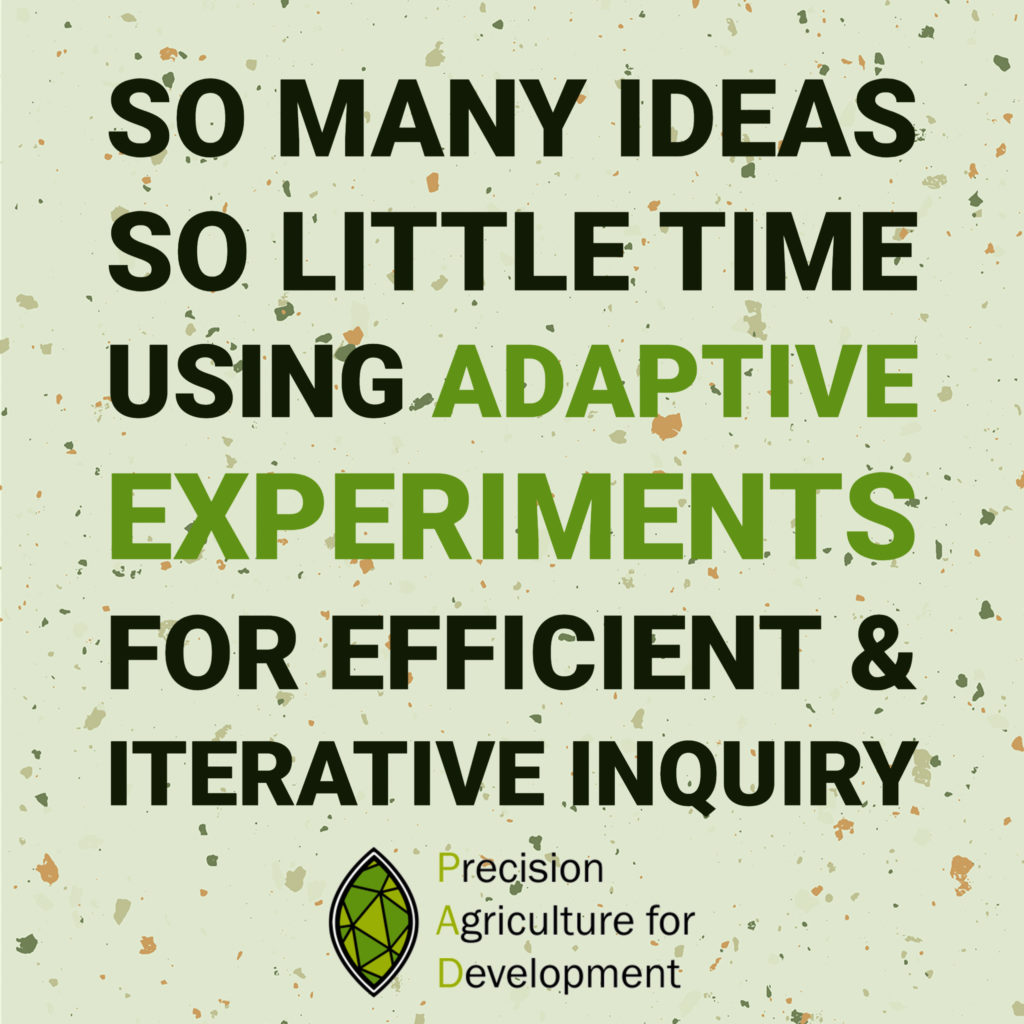
Research design and practice requires the weighing of costs and benefits, as well as potential trade-offs. For an organization like PAD, which pursues both research and development practice, concurrently and in real-time, poor decision-making can be both costly, and hugely inefficient.
When there are an infinite number of ideas and we don’t have a great sense of which ones will have large impact margins one efficient approach is to start with experiments on lots of different ideas in different locations (i.e., testing ideas that seem most relevant for a given context). Over time, ideas that show promising results in one place can be picked up by other teams and adapted/replicated in other settings. Simple tweaks that don’t lead to improved outcomes can be put aside, and ideas that don’t show results but have a solid Theory of Change can be considered for further due diligence, major tweaks, and retesting.
This is similar to the concept of adaptive experiments, a new experimental research design approach advanced by Max Kasy and Anja Sautmann. Adaptive experiments are implemented in the form of A/B tests with many arms, and two or more rounds to enable adaptation. Researchers observe outcomes after early rounds of testing, reduce the sample sizes for the worst performing arms and increase them for the best performing arms. Thereafter, this process is repeated throughout the experiment. The key advantages of this design is that it maximizes the number of beneficiaries receiving the best intervention, and does so empirically and efficiently.
Some of PAD’s programs – characterized by a large user base and quality administrative data on frequent farmer feedback – are very well-suited for efficient learning through the use of adaptive experiments. We worked with Sautmann and Kasy to implement this approach to test how best to increase response rates to the Interactive Voice Response (IVR) profiling survey for a large digital extension system PAD has built and manages in a state in India. We were particularly interested in investigating whether warning respondents that the call would be robotic ahead of time would improve the ability of farmers to respond to the IVR profiling survey. We tested whether doing so far in advance (24 hours) or near the time of the call (1 hour before) was more effective, and whether morning (10 am) or evening (6:30 pm) calls yielded higher responses, a total of six treatment arms, over one month.
The experiment stopped when we reached 10,000 total farmers called, which was a predetermined number. The success rate increased with a morning call and an SMS 1 hour before. Some simple tweaks, such as changing the time of day of the call, increased success rates by several percentage points.
However, even with a relatively basic set of questions, the share of usable recordings was quite poor and, as a consequence, the rate of usable profiles to farmers contacted was low. Consequently, we have stopped using IVR profiling and continue to profile our farmers using agents operating from PAD’s call center. As we do so, we continue to explore other low-cost and more easily scalable profiling methodologies.
Notwithstanding these challenges, we continue to find the research proposition advanced through adaptive experiments compelling as we work to empower poor people with information efficiently and effectively, at low cost and at scale. Watch this space!
Read more about Anja Sautmann and Max Kasy’s experience implementing adaptive experiments with PAD >>> VoxDev
On 16 December, PAD’s CEO, Owen Barder, and India Country Director, Niriksha Shetty, presented an overview of PAD’s work in India, with a particular focus on our work in Odisha, to a group of World Bank staff. The webinar, convened by the Bank’s Agriculture & Food Global Practice under the auspices of the Bank’s State Capacity BBL Series, was formally entitled ‘Building Extension Systems Capacity and Performance using Digital Technologies: Odisha Experience‘
Owen and Niriksha’s presentations were complemented by a presentation by Dr. Saurabh Garg, Principal Secretary of the Odisha State Department of Agriculture And Farmers’ Empowerment, PAD’s partner in delivering the Ama Krushi Service, and a pre-recorded message from Kate Kuo, Program Officer at The Bill & Melinda Gates Foundation’s Agricultural Development (AgDev) Program which supports PAD’s work in Odisha and Ethiopia.
These contributions are followed by comments by Dr. Avinash Kishore, Research Fellow, IFPRI, and Samik Sundar Das, Senior Rural Development Specialist and Odisha State Partnership Coordinator, World Bank, in a conversation moderated by Adarsh Kumar, Senior Agribusiness Specialist, World Bank. The session was chaired and introduced by Mary Katherine Holifield, Manager: Agriculture, South Asia, World Bank.
Incorporating new survey data, and new visualizations, Dashboard 2.0 allows one to observe and compare trends across rounds of surveys and geographies.
Andrew Wang, a PAD summer research associate on the global research team, who was the primary creator of the new dashboard, writes:

The next iteration of our COVID-19 dashboard is here!
Dashboard 2.0 includes new survey data collected between mid-June and September 2020 in Kenya and two states in India. The new data complements, and is comparable with, Round 1 data collected in Kenya and one state in India in April and June. The updated dashboard also includes a new set of visualizations to illustrate temporal trends over the course of the pandemic.
Building on the first round of surveys in Kenya and State 1 in India, our team conducted a second round of surveys (R2) in Kenya between July and August, and in India between June and September. The updated dashboard also includes data from a round of surveys conducted in a second state in India (State 2) between May and July. Across all three regions, a total of 4,166 farmers, of whom 1,070 (25.7%) were women farmers, were surveyed and their responses are included in this updated dashboard. A third round of data collection is planned in Kenya and State 1 in India, and the dashboard will be updated in due course.
While specific trends differ between, and within, countries, there are several notable findings from the new visualizations. It should be noted that these trends are observational and that, on the basis of these survey results alone, cannot be causally attributed to COVID-19.
- Disruptions to labor markets in India appear to have lessened over the course of the pandemic as the Kharif (summer) cropping season got underway and lockdown restrictions eased. In August and September, over 70% of surveyed farmers in State 1 reported hiring at least as much labor as last year, compared to only 50% in May and June.
- However, measures of reported food insecurity rose throughout the summer in India, with over 60% of respondents reporting that they were unable to buy the amount of food their household usually consumed due to increased prices and/or reduced income. Towards the latter half of the summer, a greater fraction of farmers in both Indian states reported reducing their meal frequency or portions.
- In Kenya, the share of farmers reporting challenges with regard to buying food at affordable prices, or accessing markets decreased slightly (but consistently), from 99% in April to 84% in August. This suggests that market conditions may be recovering following the easing of COVID-related travel and curfew restrictions. However, increased household stress associated with diminished incomes is evident in an increase in the proportion of farmers who reported reducing meal frequency and/or the size of their portions.
- Across all three regions, women respondents were more likely than men to report that they had reduced the portion size or frequency of their meals.
- Notwithstanding these food concerns, when asked about COVID-19 related concerns the fraction of farmers who cited “not having enough food for the household” decreased over time in both Kenya and India State 1 surveys.
- During the second round of surveys in Kenya and State 1 in India, fewer farmers reported worrying about family members contracting COVID-19 (a steady decrease is observable from 57% in May to 34% in September). Concerns about personally contracting the disease also dropped in Kenya (53% in September compared to 67% in May), but not in the Indian state (52% in both May and September). This pattern is consistent for men and women farmers.
Further iterations of this work are in the pipeline: A third round of surveys will go into the field in Kenya soon, and we are developing a separate dashboard to visualize the impacts of the pandemic on Kenyan agro-dealers. Stay tuned!
For a deeper dive into the impacts of COVID-19 on smallholder farmers across geographies, gender, and time, take a look at the dashboard and read through our relevant policy notes and blog posts.
PAD’s India Research Manager, Hannah Timmis, and Senior Research and Operations Associate, Maya Woser, reflected on lessons learned for the International Growth Centre’s blog
Niriksha Shetty, PAD’s India Country Director, reflects on a remarkable milestone.
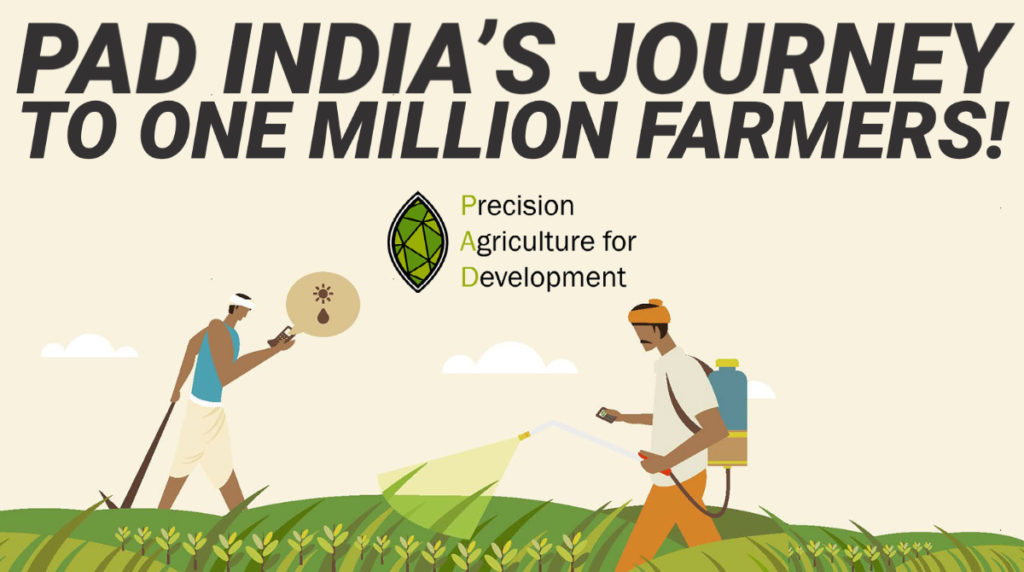
In September, 2020, Precision Agriculture for Development in India* surpassed the 1 million mark for farmers who receive advisory content through our services. This is a remarkable milestone!
What began in 2016 as a small pilot project in one state – Gujarat – serving just 10,000 farmers on one crop – cotton – has since grown to encompass five initiatives across six states in India which cater to a wide variety of farmers’ informational needs. Today we offer customized and scientifically validated advisory information on – at last count – 24 crops and a litany of pests and diseases. In addition to crops, our advisory capabilities in India now also include campaigns to support fisheries, with planned expansions to dairy, and livestock management.
To achieve these advancements, PAD India collaborated with a set of dynamic and committed partners including government, nonprofit, and for-profit entities. Our partners enable us to scale much more rapidly than would have been the case if we had worked alone as they help bring access, resources, and expertise that would be difficult for us to accrue quickly as a start-up organization (farmer databases, government contacts, etc).
Critically, PAD India’s growth trajectory would not have been impossible without the contributions of two key stakeholders: our farmers and our colleagues across PAD. Two-way information flows allow us to communicate and learn from our farmers, refine our content, improve our service and improve our delivery mechanisms. The entire PAD team works tirelessly to learn from our farmers, iterate our services, and implement improvements to push the frontiers of our impact.
The PAD Model
Our team has pioneered a method of service design and delivery that is evidence-led and iterated through learning. At PAD, we best serve our farmers when we use evidence to inform our decision-making and design choices. We believe in continuous testing, iteration, and refinement to build and expand our evidentiary base and learning. Whether our research findings are ‘good’ or ‘bad’, we endeavor to extract insights about what is working and what could be done better.
We gather and interpret data, and apply PAD’s principles of human-centered design and have built our information services from scratch. For example, we have run trials to understand which voice our users preferred for content delivery, and tested whether adding a jingle at the beginning of a message increased engagement (spoiler: it did not). Today, if you visit any of of program offices – in COVID-times, our home offices and ‘Zoom-rooms’ – you will encounter a hive of activity: agronomists recording answers to farmer queries in sound-proof rooms, enumerators collecting farmer data over the phone, and management teams brainstorming strategies to improve user experience or measure impact.
For PAD India, our advisory content is disseminated through a two-way mobile phone-based platform that delivers customized content to farmers in audio form and in their local language. Farmers receive i) a weekly push call with agricultural advisory information that is customized in line with the crop cycle, each farmer’s location, and land characteristics; and ii) access to a hotline where farmers can record questions that are answered within 48 hours by our team of agronomists, with answers disseminated through pre-recorded voice calls. Farmers who dial into our hotline can also choose to listen to a library of advisory messages and, in some instances, access crop and commodity price information.
Ensuring that the information we provide is targeted and relevant to individual farmers is critical to ensuring sustained engagement and the maximization of potential learning and benefits. When we first engage with farmers to register them to our services, we collect farmer-specific information (what crops are they growing, where is their farm located, land type, time preferences for receiving information, etc.). These details allow us to customize messages in line with farmers preferences, conditions and needs, and ensure their relevance and applicability.
Farmers are then grouped into clusters to receive different information. For instance, our work in Odisha spans six varied agro-climatic zones: farmers in Western Odisha – characterized by hot and moist sub-humid weather – receive advisory later than their counterparts in other climatic zones due to late onset of monsoon in that region, while farmers in the East and South Eastern coastal plains receive advisory on post-rain management of crops after periods of heavy rainfall. Similarly, an arabica coffee farmer in Karnataka may receive pest management information for white stem borer, while a robusta farmer may receive advisory for the coffee berry borer which loves to plague that varietal.
Relevance drives engagement. Across all of our initiatives in India our farmers pick up, on average, 66% of the calls we push to them, and – in turn – listen to, on average, 68% of the message content, with higher engagement during peak-activity periods in a given agricultural season. Our farmers value our service: rating our content greater than 4 out of 5, where 5 represents ‘excellent’. In weekly feedback surveys which we administer with a random subset of users, over 90% of farmers indicate that they would be willing to recommend our service to their friends and family.
A/B testing and experimentation are embedded in all of our operations to ensure continuous learning and to inform improvements to service delivery and impact. In West Bengal, we see that training and testimonials increase engagement with the IVR hotline, but don’t show significant effects on knowledge and adoption of recommended practices while in Odisha, we have learned that simple reminder messages are a more effective way of increasing traffic to the IVR hotline than conversational or dramatized messages. Midline analysis from our most recent A/B test to promote flood-resistant seeds in Odisha show that advisory messages that reiterate the benefits of these seeds have a large and significant impact on farmer knowledge.
As we continue to test methods to increase user engagement, we work constantly to improve our platforms and adjust them to farmers’ needs. For example, as more and more of our farmers report that they own smartphones, an opportunity to engage with them via this dynamic new channel becomes more viable. An early experiment is how we are rolling out automatic farmer enrollment through webforms accessible via smartphone.
Highlights of PAD India’s Programming
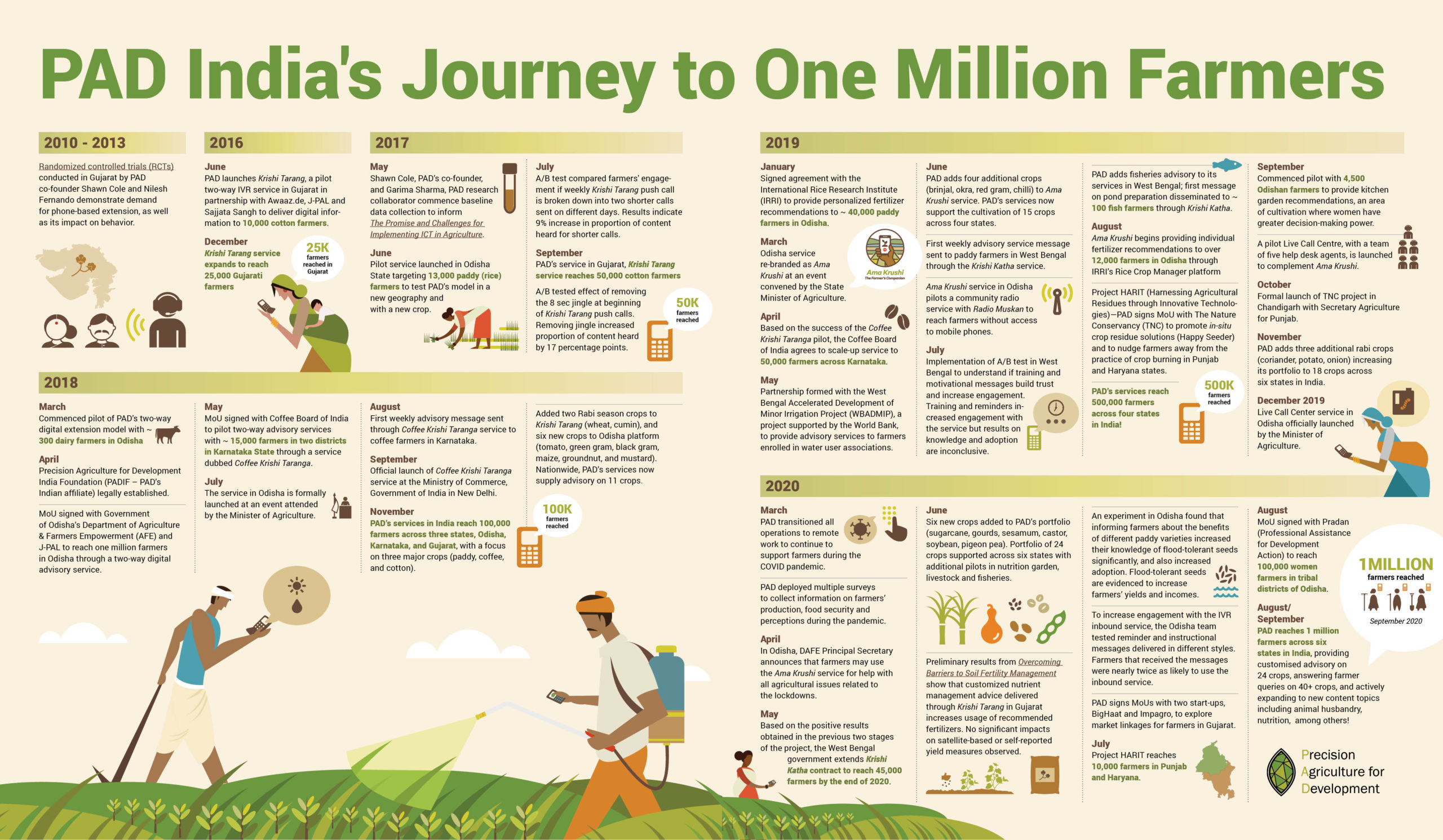
Ama Krushi – Odisha
In Collaboration with the Department of Agriculture & Farmers’ Empowerment, Govt. of Odisha
In 2018, we launched what is now our largest and most sophisticated project in India, the Ama Krushi service in collaboration with the Government of Odisha’s Department of Agriculture and Farmers’ Empowerment and the Abdul Latif Jameel Poverty Action Lab (J-PAL), with support from the Bill and Melinda Gates Foundation. This project was conceptualized as a build-operate-transfer (BOT) project with a target of serving a million farmers within a three-year period. In addition to the two-way IVR platform, Ama Krushi operates a live call center and is making forays into integrating smartphone-enabled tools, community radio and additional delivery channels.
Knowing that a key deliverable is ultimately to hand over the service to government, we have worked to ensure that Ama Krushi is embedded within the government apparatus to build ownership and ensure long-term sustainability: All content is co-created with a committee of government experts and scientists from the local agricultural university, data on farmer engagement and information needs are shared in government decision-making meetings, and critical alerts from the government are shared with the hundreds of thousands of farmers through the service.
Coffee Krishi Taranga – Karnataka, Kerala and Tamil Nadu
In Collaboration with the Coffee Board of India
In July 2018 we launched a pilot with the Coffee Board of India to test our model of agricultural extension in the service of coffee growers in Karnataka state. In this setting, in addition to coffee cultivation advisory content, we tested the use of our IVR hotline to provide price information to farmers. Premised on the success of this initial pilot, known as Coffee Krishi Taranga, this service is now being scaled in additional Indian coffee-growing regions in the states of Kerala and Tamil Nadu.
Krishi Katha – West Bengal
In Collaboration with the West Bengal Accelerated Development of Minor Irrigation Project
In July 2019, we joined forces with the Accelerated Development of Minor Irrigation Project, a collaboration between the Government of West Bengal and the World Bank to promote access to irrigation in the state by creating Water User Associations (WUAs). PAD supplemented the intervention by providing agricultural advisory information to farmers enrolled in WUAs. The initiative, known as Krishi Katha, commenced as a pilot serving 10,000 farmers with information on horticultural crops, including paddy (rice) and vegetables, as well as content on fisheries. Following a very successful first season, the project was initially scaled to reach 20,000 farmers, and will reach 45,000 farmers by the end of 2020.
Project HARIT (Harnessing the power of Agricultural Residues through Innovative Technologies) – Punjab and Haryana
In Collaboration with The Nature Conservancy (TNC), the International Maize and Wheat Improvement Center (CIMMYT) and the Borlaug Institute of South Asia (BISA)
In the northern states of Punjab and Haryana, we are piloting a program to encourage farmers to use an in-situ crop residue solution – utilizing a technology called Happy Seeder – in lieu of crop burning practices that are the primary driver of seasonal air pollution throughout the sub-region. By returning crop residues to the field, the pilot encourages farmers to adopt sustainable residue solutions that promote soil health and the development of soil nutrients, in addition to mitigating crop burning practices.
Krishi Tarang – Gujarat
In Gujarat, we work with close to 54,000 farmers, who have been part of PAD’s oldest program in India. While these farmers primarily grow cotton, we also provide advisory on wheat, cumin, oilseeds and other horticultural crops. This service is operated entirely by PAD, and often serves as a setting for testing innovations and piloting new partnership models. Most recently, we have launched collaborations with two start-ups in the agricultural sector to provide farmers with value-added services in addition to advisory and more effectively connect them to input and output markets.
Navigating COVID
Of course, the impact of the current COVID-19 pandemic has fundamentally affected PAD’s operations across all the countries where we work. We continue to adjust to meet the evolving needs of our “new reality” and the emerging needs among our farmers. For example, PAD India moved all of our operations to work from home in early March in less than one week, as my colleagues document in this blog. In doing so, PAD India continued profiling, training, and surveying activities, and maintained management of research and operational work streams without interruption.
PAD India has also had to adjust quickly to meet farmer and government needs during the pandemic. We conducted several rounds of Covid-19 surveys to systematically understand the challenges that farmers and agro-dealers were facing. We disseminated critical advisory information to farmers to inform them about which markets were open, the prices of crops, government notices and alternate remedies in the event of market shut-downs. All the while, we continued to add new farmers to our services at a time when traditional extension activities have all but come to a standstill.
I am proud to say that our information provision in the service of India’s smallholder farmers has proceeded without interruption. This is something that would not have been possible without the hard work and commitment of our team. Of course there have been some disappointments: we had to cancel an all-India staff meeting (we continue to look forward to it), we had to postpone the roll-out of a long-planned impact evaluation in Odisha and we continue to navigate challenges relating to when we can safely return to in-person work and how to best support our staff during difficult times.
Looking to the Future
Digital interventions can be revolutionary, but they can also leave less digitally proficient farmers, as well as women, indigenous communities and older farmers behind. All of these categories coincide with generational and entrenched fissures in the communities in which we work. We constantly challenge ourselves to work to reduce these digital gaps.
As we have scaled, we have learned – sometimes with difficulty – that a one-size-fits-all approach does not work. Our primary informational delivery channel remains our two-way voice-based service, but we are now also working to provide extension services through other channels; for example, through community radio to farmers who have no access to mobile phones. Another approach is by working with grassroots organizations like Pradan, which works with women in agriculture to nudge and promote information sharing across community networks by targeting group and community leaders. Finally, we have tested content on nutritional kitchen gardens that benefit household consumption, and have promoted advisory on horticultural crops and livestock that are more likely to engage women farmers.
As we look forward, however, we are excited about an ambitious pipeline of activities for PAD India. We plan to integrate PAD’s in-house technology stack (“PADDY”) across the various geographies we work in. To date, we have served our farmers in collaboration with our technology partner, Awaaz.de. We are grateful for the strength of our collaboration, particularly during this COVID-affected transition period. We are also excited to have commenced transitioning Ama Krushi to government management, while simultaneously rolling out baseline data collection for a large-scale randomized evaluation of the service. Across geographies, we are exploring ways in which we can build market linkages for our farmers, be it in collaboration with for-profit companies, or by more effectively connecting farmers to local markets.
A key strategic priority is to build capacity – both technical and operational – to design, test and iterate our services across geographies. By more effectively managing our technology development pipeline, conducting rapid prototyping to identify the value of new features, and more effectively incorporating user feedback (both internal and external) into design, we can further improve our services, and build new offerings to increase the usability of the information we provide to farmers. Excitingly, we are involved in active conversations with several new partners to expand our services in agriculture, and in new sectors, across India.
A Remarkable Achievement!
As we look back to our journey to a million farmers, the strong partnerships we have built on the ground have been an important catalyst. Our farmers, who engage with our services, remain our most important partners. Every day we learn from them: they patiently share information with us through the various surveys we conduct, provide feedback on everything from service design to content accessibility, to the availability of specific inputs in their vicinity, or simply share information with their friends and family about our services. These data, and the intensity and nuance of farmer engagement, are our most important tools for improving our services.
I do not doubt the capabilities of our team and our broader collaboration with partners and farmers. I’m privileged to be along for this fascinating, important, and impactful journey. Together, onward to the next million, and more!
*PAD’s activities in India are implemented in partnership with Behavior Change Advisory Services (BCAS) LLP
Otini Mpinganjira, Odisha State Lead, & Vineet Keshaw, Senior Implementation Associate, pay tribute to a remarkable team effort that has kept farmers informed in unprecedented times.
Precision Agriculture for Development’s Ama Krushi digital extension service was officially launched in 2018 with the ambitious target of reaching one million, predominantly poor, smallholder households in Odisha in just three years. Given the scale of the objective and the ambition of the delivery timeline, the culture of the Ama Krushi team is one that is accustomed to chasing down milestone achievements while adapting quickly to new challenges.
Generations of Odisha farmers have navigated challenges associated with drought and the cyclones that regularly rumble in off the Bay of Bengal. At the beginning of 2020, neither the Ama Krushi team nor the farmers we serve, could have anticipated the scale of the crisis associated with COVID-19, or the operational jiu-jitsu required of us to maintain – and grow – our digital extension service in the cross-hairs of the pandemic.
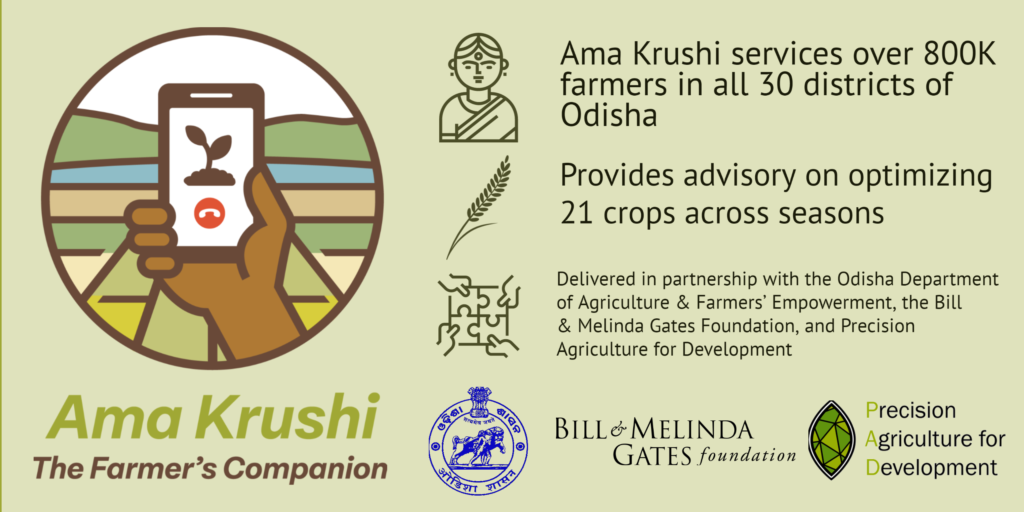
Two years along our delivery path, the two-way interactive voice response (IVR) system pioneered by Ama Krushi reaches over 800,000 farmers across all of Odisha’s districts. Our overarching task has always been clear: to deploy PAD’s iterative and human-centred approach to design, and to deliver actionable and impactful information to farmers via their mobile phones to secure and improve farmer livelihoods.
On a normal day (read: open office, no pandemic), a step into the programme office is welcomed with a buzz of activity akin to a lively bee colony: you hear the enthusiastic voices of approximately 100 call centre agents speaking to farmers handling a variety of tasks (onboarding new farmers, answering queries, coordinating remote training and remote surveying etc.). This buzz is contrasted by the soundproofed quiet of the content generation space with its pristine white walls and our team of agronomic experts going about their work responding to farmer queries or recording new messages.
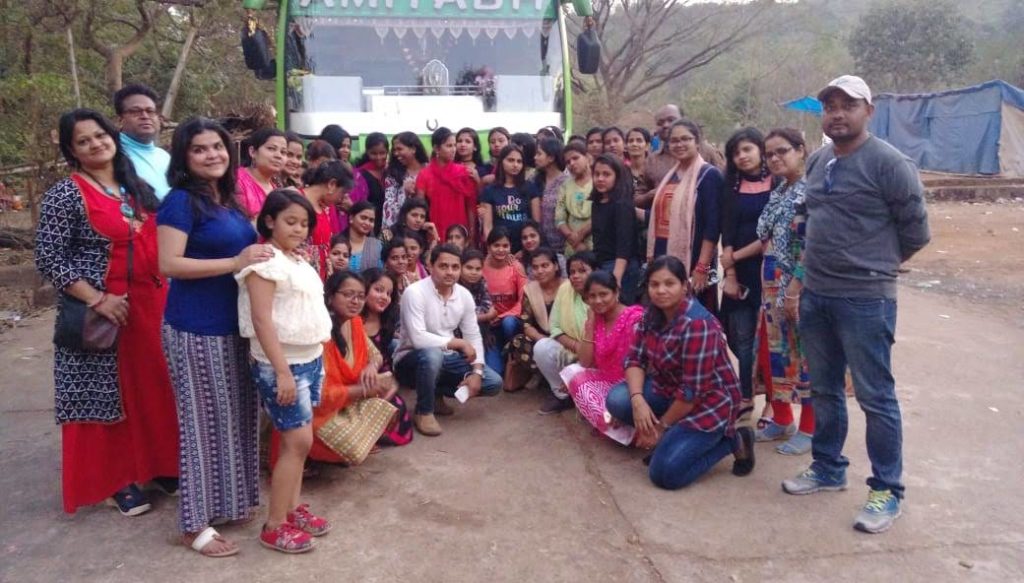
Aah, the good old days! As is now commonplace across the world, the situation today is very different to “normal”. However, one shouldn’t be too nostalgic. In normal circumstances, the smallholder farmers we serve face a level of information poverty that perpetuates a cycle of hunger and inhibits economic opportunity. By limiting physical interactions and affecting supply chains, the current pandemic has the potential to exacerbate this information gap; further escalating the precariousness of smallholder livelihoods.
PAD and the Ama Krushi team in Odisha have worked tirelessly to ensure minimal disruption to our services. Safety first!. Our highest priority was to ensure the safety of the team and our farmers. While the office was still open we swiftly implemented best practices to optimize hygiene, introduced a regime of regular disinfection for shared and commonly regularly used surfaces, provided hand cleansing facilities in all workspaces, and adjusted sick leave policies.
As the effects of the pandemic worsened and it became obvious that lockdown measures were imminent, the team worked to define a set of critical activities, and identified the complementary technologies and protocols that would be required to keep the programme operational as staff began working from home. Critical services and activities were identified as follows:
- Farmer Onboarding: Continued profiling and onboarding would ensure that new farmers could continue to join the service. In the context of the lockdown, onboarding farmers became more urgent as many farmers lost all other sources of information in the aftermath of agro-dealers being shut, and agricultural extension workers becoming unavailable due to the lockdown. The deep-dive in Box 2 below details the journey to moving our call centre operations to remote working status. Between April and June 2020, Ama Krushi successfully onboarded just over 106,000 new farmers.
- Content Delivery: Notwithstanding the well-documented advantages of digital extension services (cost-effectiveness, scalability, hugely favorable benefit-cost ratios, etc), a key advantage of digital advisory services during the current crisis is that information can be delivered via mobile phone without risking the health of farmers or extension workers. Delivering content would ensure that farmers registered on the service would continue to receive their weekly advisory messages. By happenstance, lockdown measures were imposed at an important transition point as farmers moved from harvest and crop storage activities following the winter season (Rabi), to preparation activities ahead of the summer season (Kharif). In addition to our regular agronomic advisory, Ama Krushi was well-placed to ensure that farmers were able to receive information alerts related to the lockdown. Overall, between April and June 2020, the service sent over 5.6 million outbound messages on a variety of topics (e.g. disease and pest management, harvest management, lockdown related advisories etc.).
- For example, on 15th & 16th April, Ama Krushi issued an advisory to ensure that farmers were aware that they could still take their produce to market (see Box 1, below)
- Similarly we distributed content related to the onset of the Kharif planting season, informing farmers that they could initiate cultivation.
BOX 1: Examples of messages sent during lockdown
“Namaskar. Welcome to Ama Krushi, the free Agriculture Information service of the Department of Agriculture, Government of Odisha. Some special information for farmers: Farmers who are harvesting a variety of vegetables this Rabi season can take their produce to the nearest agricultural market for sale. There is no barrier to transporting your products. Contact your nearest agricultural officer or horticultural officer for this.”
“Namaskar. Welcome to Ama Krushi […] Some special information for farmers: The current Kharif season has begun. At this time, farmers can cultivate their own land despite the coronavirus shutdown. You can use your own or rent agricultural machinery. Contact your nearest agricultural officer or horticultural officer for more information.”
- Farmer Helpdesk: We also needed to ensure the continued operation of our automated inbound service; i.e. to allow registered farmers to continue to call in and record questions 24/7. Our Live Call Centre (LCC) service, where farmers speak directly to an agent, saw a three hour extension in operating hours to assist farmers during a period of heightened need. Our partners at the Department of Agriculture & Farmers’ Empowerment (DAFE) actively promoted the LCC service through television and print media resulting in a 500% increase in traffic. For all inbound calls, our team applies tags which allow us to categorise the nature of a question and to link it to answer in our answer library. For lockdown operations, we introduced new tags to track issues related to the lockdown, as well as to ease the summarizing of data pertaining to the preparation of daily reports for DAFE and other policy makers. The team took the extra step of forwarding particularly complex queries to district nodal officers with the intention that they follow up with complementary advice in person on the ground. This was achieved in collaboration with members of the Analytics for Decision-making and Agriculture Policy Transformation (ADAPT) team; a sister project also working with DAFE. Between April and June 2020, the LCC received just over 24,000 calls primarily related to government schemes, market registration as well as pest and disease management.
- Research & Development: To more systematically understand the evolution of the pandemic and its local impacts, our research teams quickly developed a survey tool.
BOX 2: Moving a 100 person call centre to remote work
By design, the Odisha programme uses a call centre model to onboard (profile) farmers. The model has various advantages for data quality and resource effectiveness. In solving the problem of building remote call centre functionality, we borrowed heavily from tools under development in the technology pipeline. Over a 2 week period, we then worked to re-purpose them for the needed functionality. The main challenge was how to enable our agents to use a combination of feature-phones and smartphones to make and receive calls while maintaining some of the quality assurance protocols that we had in place. The other challenge was logistical; i.e. ensuring that agents had access to mobile phones and SIM cards, that we had an efficient and secure way of delivering farmer numbers and that we could train them on use of the new systems.
To test our solution, the team launched remote profiling at 25% of our operating capacity. At the same time, we introduced a back-check model to substitute our previous monitoring system. Our technical team made the requisite changes to ensure secure access to farmer’s details. The new home-based profiling system was not only customized to enable our staff to access it from their mobile phones, it also integrated a range of functions appropriated from the dialer system we use when working from the office, including the following additional functions:
- Sample selection: It automatically provides farmer details to survey agents.
- Call status: Survey agents are able to submit call status which helps to maintain the call log and the overall monitoring system.
- Incoming call: One of the biggest issues survey agents faced was not being able to record the details of farmers who call back. To assist with this challenge, we implemented changes to enable survey agents to profile and note the number of incoming calls.
- Survey agents activity: Surveyors can access their performance indicators, i.e. calls made, the number of farmers profiled over a month, a week and on that particular day.
- Training: To train our survey agents, we implemented a remote training solution utilizing video conferencing.
Given the scale of the challenges arrayed before us, and the emerging needs of our famers, we have of course experienced many challenges, including technology not functioning as intended to connectivity issues affecting output. We also continue to be engaged in a battle to shift our collective mindsets to maintain productivity as we work from home, and while we balance domestic duties and distractions.
As the Kharif season moves into gear and as we come to terms with the long-term nature of the pandemic, we have started to prepare more proactively for the future.
Normalisation is the key word here. Through downshifting, we are faced with the challenge of empowering execution staff to own – as they did before – the majority of day-to-day call centre functions. This will include training them on the tools that our project managers have been using to manage our remote call centre functionality as well as providing them with checklists and avenues for assistance. This will allow us to dedicate project management resources and capabilities to reintroducing deprioritised, but nevertheless important, components of the programme such as manual feedback surveys and remote farmer training.
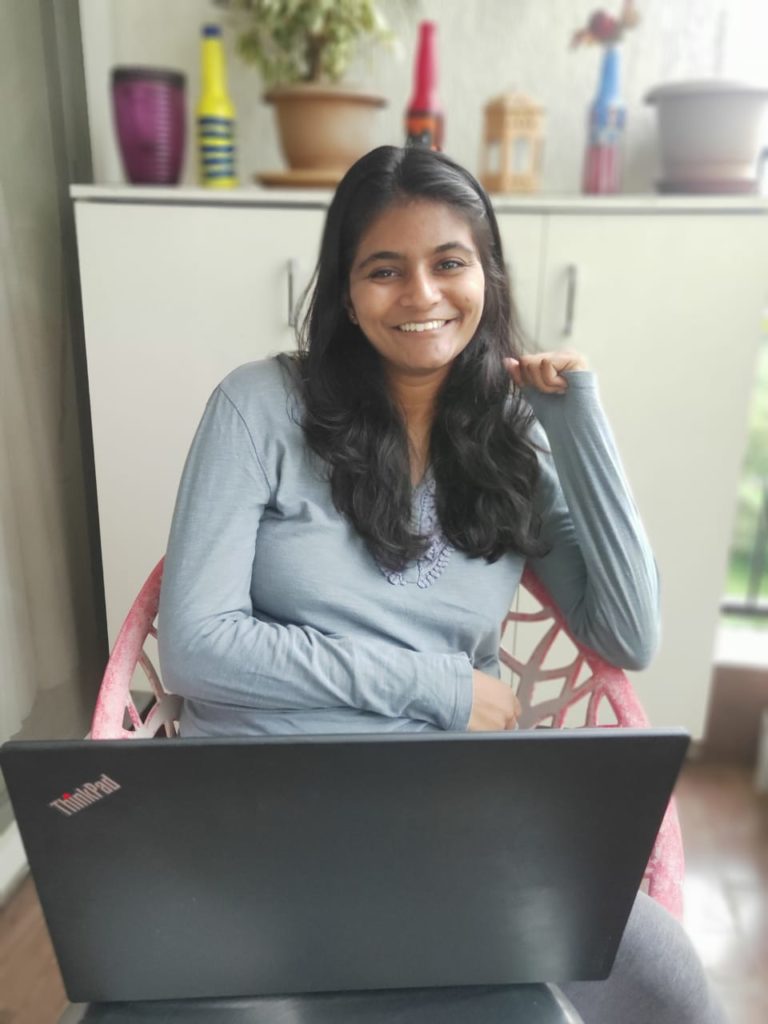
We are immensely proud of the work of the Ama Krushi team. Through flexible application of technology, a get-stuff-done mentality, and the enduring spirit of this team, our service to farmers never stopped… Not even for a day.
From the survey agents and agronomists who showed their willingness to work from their home, despite many having to do so in circumstances that are far from ideal, to the supervising team who stayed on top of teething issues and provided valuable input when necessary. This has been a huge collective effort . An unavoidable cost of work-from-home arrangements is that not all jobs can be done from home. Similarly, some roles may become more peripheral as priorities are realigned. It has been heartwarming to note the care the team has extended toward one another. One example is the contributions drive organised towards a fund for our security guard, who due to mobility restrictions, was unable to return home to his family for several weeks.
As a team – spurred by a crisis or two – we have learnt the value of purposeful and early communication as a tool for establishing a common baseline understanding for everyone to work from, and the need for maintaining connections across the wider team. We have reaffirmed our shared mission to empower smallholder farmers, and despite not being together, we have worked together to keep the programme running.
We thank our partners at the Department of Agriculture and Farmers’ Empowerment for accommodating and supporting our work from home initiatives throughout this period.
Ama Krushi is on track to empower one million smallholder farming families ahead of schedule. None of us could have imagined the conditions in which we strive to reach that milestone, and pilot new projects targeting livestock and women farmers, as we continue to iterate and add more value to the service.
Make an Impact Today

